Ireland, England and down to the Mediterranean
August 1985 to November 1986
Ireland
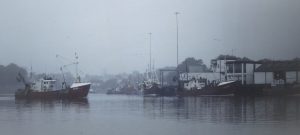 After the long at and times arduous crossing of the North Atlantic we enjoyed our first real sleep for weeks. We woke to overcast skies, and then went ashore to deal with Customs clearance and the other officials.
After the long at and times arduous crossing of the North Atlantic we enjoyed our first real sleep for weeks. We woke to overcast skies, and then went ashore to deal with Customs clearance and the other officials.
The harbourmaster informed us rather sheepishly that we could not be officially cleared in because the Customs officers were on strike! He asked us to lower our yellow quarantine flag and said we were free to move around pending eventual clearance. We stayed ashore for some shopping and a walk round the pleasant little fishing village of Castletownbere. We bought some outstanding meat and got stuck into draft Guinness for the first time in its homeland. Norma got going with part one of an enormous stack of washing, despite difficulties drying it in the drizzly weather.
When telephoning mother in Britain just before we left Bermuda, she asked when we would arrive in Ireland. Forecasting passage times is a very uncertain business - what if we had decided to divert to the Azores after all? - and can cause unnecessary alarm. I had told her, very tentatively, that our estimated time of arrival could be around the end of the month. When we finally made harbour, I called her from Castletownbere on the first of July. "I knew you would have just arrived and was expecting your call!", she lovingly but rather naively replied. If only all long passages were that predictable!
We took a two-hour minibus trip into Cork for money, mail and charts. The ride took us through the hills of County Cork, with more wild scenery and tiny villages where the farmers still take milk to their co-ops in churns on little carts drawn by donkeys. The next day we were formally cleared into Ireland by a rather apologetic Customs officer. We enjoyed the refreshing change, after months in the Bahamas and before that the United States, that we could buy superb fresh meat at a proper butcher’s shop.
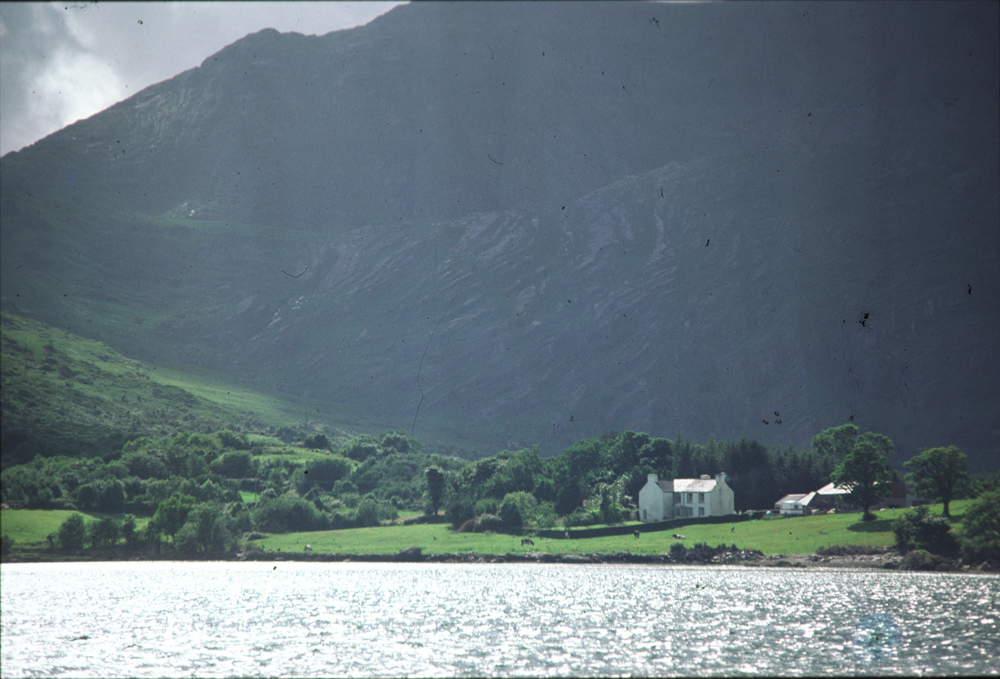 We also needed fuel, and partially filled up before being asked to leave the fuel dock to give room for a fishing boat. We then motored out of the harbour with drying clothes flying from the rigging. We motored up Berehaven, the channel between Bear Island and the mainland. The shores on both sides were rocky, backed by small green fields, stone cottages, more rocky hillsides, all very quiet. We motored into Adrigole Harbour, a very beautiful and very well-protected bay but with submerged rocks all over to be avoided. Steep hills up behind us on the mainland were shrouded by the kind of misty rain they call "soft weather".
We also needed fuel, and partially filled up before being asked to leave the fuel dock to give room for a fishing boat. We then motored out of the harbour with drying clothes flying from the rigging. We motored up Berehaven, the channel between Bear Island and the mainland. The shores on both sides were rocky, backed by small green fields, stone cottages, more rocky hillsides, all very quiet. We motored into Adrigole Harbour, a very beautiful and very well-protected bay but with submerged rocks all over to be avoided. Steep hills up behind us on the mainland were shrouded by the kind of misty rain they call "soft weather".
Before leaving the next day, Norma took the dinghy out for an explore and to collect mussels, rowing around the bay among the rocks, closely followed by several inquisitive seals nosing up to the little white boat.
We had a pleasant morning sail further up and to the head of Bantry Bay, to a large but also nearly land-locked bay, Glengarriff Harbour. This is another very beautiful haven, called locally the Madeira of Ireland because of its supposedly mild climate. A few other boats were anchored there, most of them French. I was  suffering a cold by then, which triggered my asthma, so we stayed put for a while
suffering a cold by then, which triggered my asthma, so we stayed put for a while 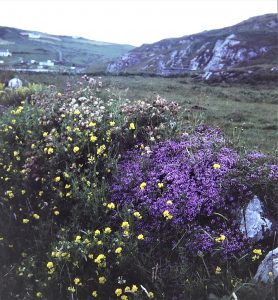 during a few days of welcome sunshine. The mussels that Norma picked there were delicious, tasty and fat, and we picked several off the rocks surrounding the many little coves around the bay and the small Illnacullen (Garnish) island. We walked up to and around the village of Glengarriff. The glorious scenery, backed by the steep, high hills, was scattered with tiny farms, oak trees, shady glades, streams, and masses of flowers including rhododendrons and fuchsias.
during a few days of welcome sunshine. The mussels that Norma picked there were delicious, tasty and fat, and we picked several off the rocks surrounding the many little coves around the bay and the small Illnacullen (Garnish) island. We walked up to and around the village of Glengarriff. The glorious scenery, backed by the steep, high hills, was scattered with tiny farms, oak trees, shady glades, streams, and masses of flowers including rhododendrons and fuchsias.
We spent a restful week in this lovely harbour and then motorsailed out and westwards out along Bantry Bay, back along the Bearhaven channel and to a little 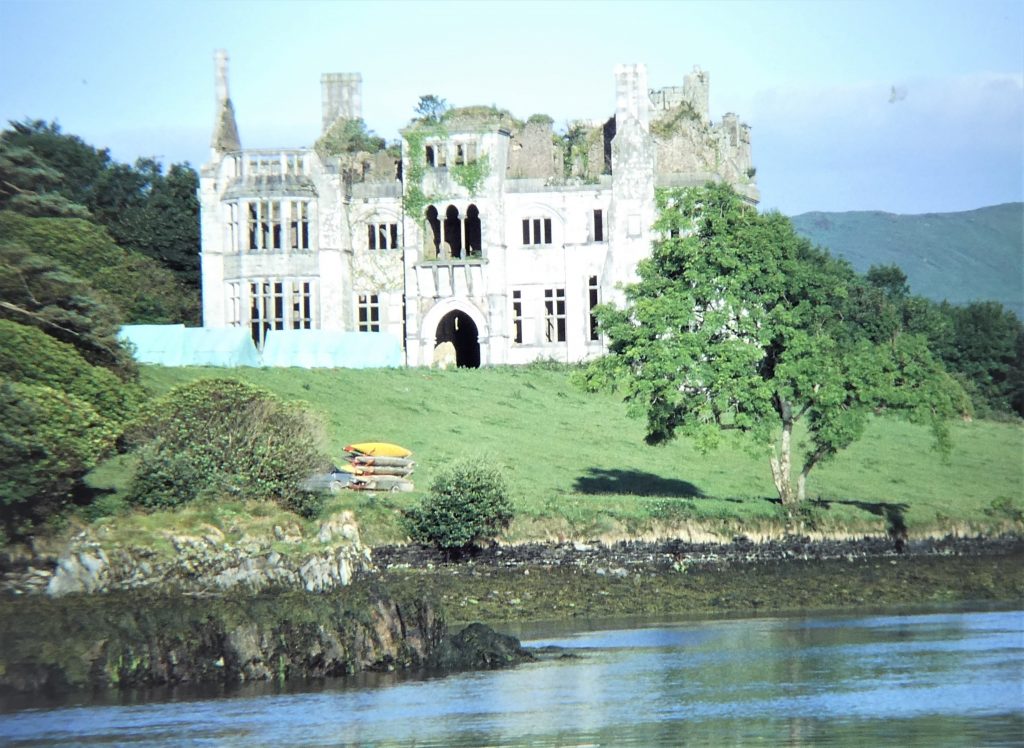 bay a little further to the west of Castletown. This was Dunboy Bay, and we anchored just off the remains of a beautiful but burnt-out mansion, Dunboy House. The next morning we walked
bay a little further to the west of Castletown. This was Dunboy Bay, and we anchored just off the remains of a beautiful but burnt-out mansion, Dunboy House. The next morning we walked 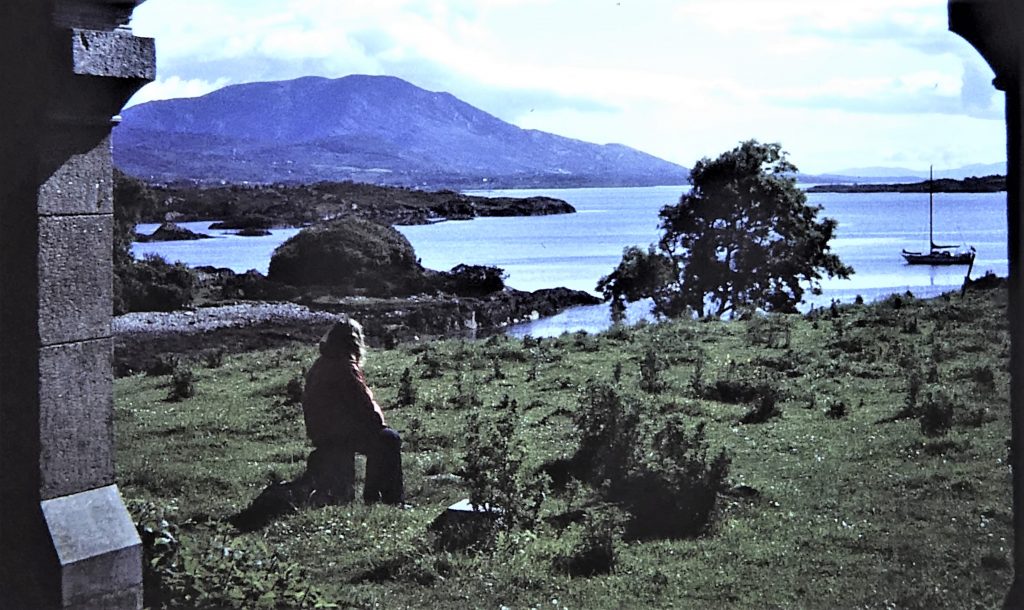 among the ruins, with cows wandering through the still-standing walls. The massive grand hall had marble pillars separating galleries, and there were large living rooms and servants' quarters.
among the ruins, with cows wandering through the still-standing walls. The massive grand hall had marble pillars separating galleries, and there were large living rooms and servants' quarters.
At the end of the point on which the house stands lie the ruins of Irish rebel leader O'Sullivan Beare's Dunboy Castle and fort, which were destroyed by English cannon fire during the siege of Dunboy in 1602.

[We revisited this area by campervan during our tour of Ireland in 2016. The Puxley family had moved to Berehaven in 1730, and John Puxley took over the land where the house and castle now stand. John Puxley developed the wide-ranging Allihies copper mines further out and along the Beara peninsula. After his death his brother Henry took over the property and built the gothic mansion. In 1921 it was largely burnt down and the estate was auctioned off. On this 2016 visit we saw that the mansion had been largely reconstructed but was unoccupied and fenced off. Behind it was a line of new townhouses that were also unoccupied, and it looked like this was a developer's enterprise that had gone bad.]

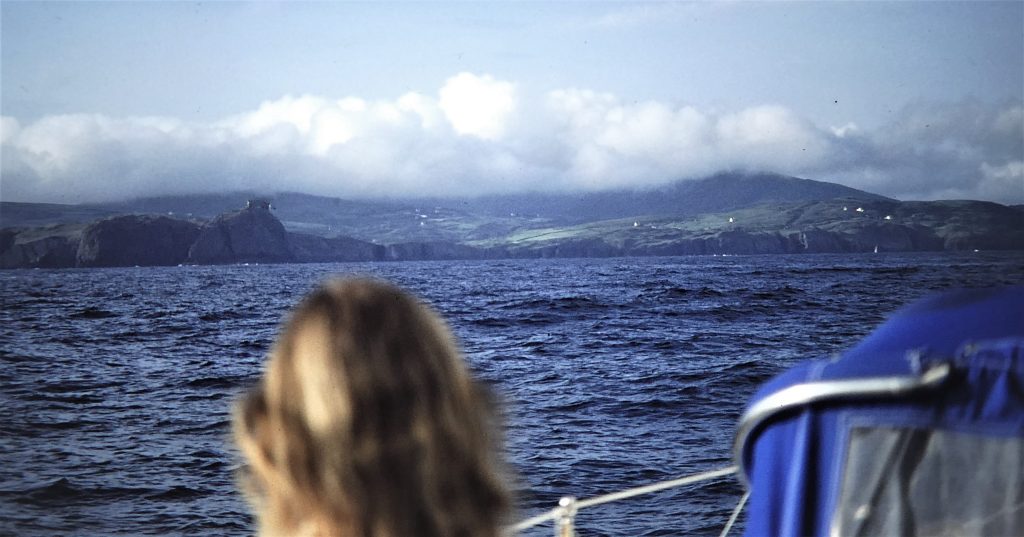 The weather changed favourably, and in a strengthening north-west wind we grabbed the opportunity to sail south across the mouth of Bantry Bay and Dunmanus Bay, round Mizen Head (the south-west extremity of Ireland) into Long Island Bay, and down the long inlet of Crookhaven. The wind was whistling by the time we got there, and we anchored in the protection offered by little Granny Island on the north side of the inlet.
The weather changed favourably, and in a strengthening north-west wind we grabbed the opportunity to sail south across the mouth of Bantry Bay and Dunmanus Bay, round Mizen Head (the south-west extremity of Ireland) into Long Island Bay, and down the long inlet of Crookhaven. The wind was whistling by the time we got there, and we anchored in the protection offered by little Granny Island on the north side of the inlet.
The next morning we took a substantial walk ashore to the little village and up to the top of a hill with a ruined Martello tower. The land was thick with fuchsias and other flowers, green fields with stone walls, linked by narrow winding roads. Healthy-looking livestock were to be seen everywhere. After a Guinness in the village pub with an English-American couple we made it back to the boat in driving, freezing rain. Norma still managed to do some washing in the afternoon!
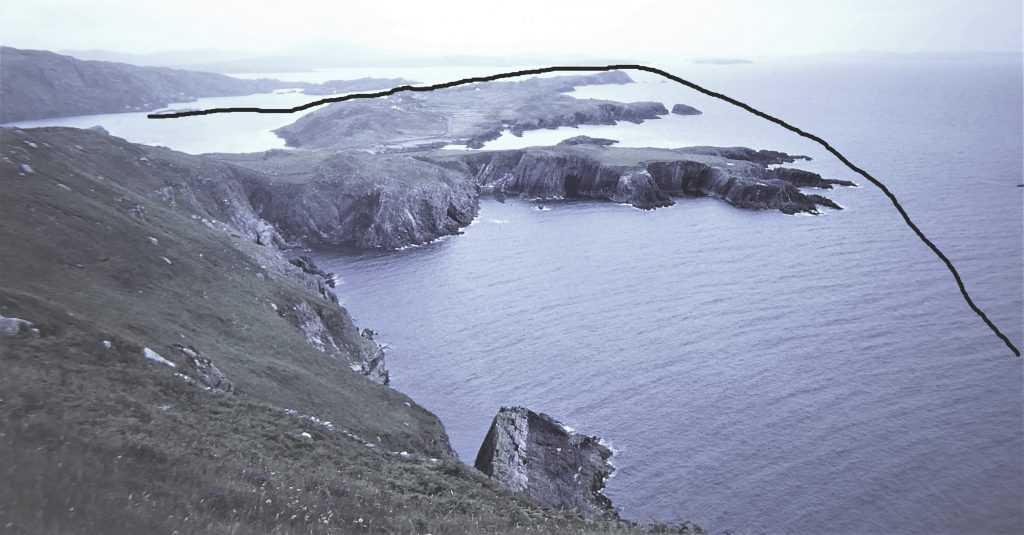
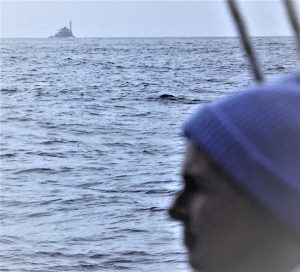 Winds were funnelling down the inlet and a gale warning was posted, so we pressed on the following day to the wide expanse of Baltimore Harbour. On the way we could see the Fastnet rock and lighthouse on the horizon to our south.
Winds were funnelling down the inlet and a gale warning was posted, so we pressed on the following day to the wide expanse of Baltimore Harbour. On the way we could see the Fastnet rock and lighthouse on the horizon to our south.
We sought shelter from the strong westerly by anchoring across the bay from Baltimore, under some abbey ruins on the shore of Sherkin Island. We took a quick dinghy trip over to the small, neat village of Baltimore for some provisions and handicrafts for presents.
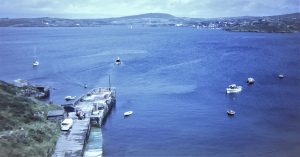 The wind eased overnight, to be followed by a miserably wet morning. However, the skies cleared in the afternoon, which allowed a walk up to the remains of the 15th century Franciscan abbey we could see from the boat. We walked the two-mile
The wind eased overnight, to be followed by a miserably wet morning. However, the skies cleared in the afternoon, which allowed a walk up to the remains of the 15th century Franciscan abbey we could see from the boat. We walked the two-mile 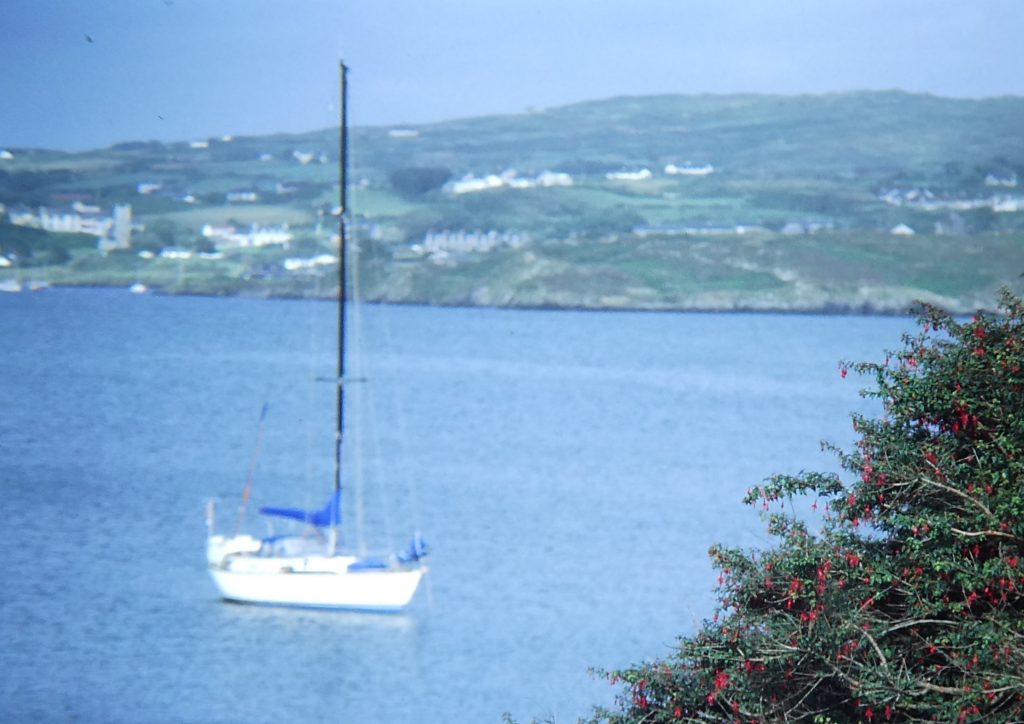 length of Sherkin Island with a friendly local lady and her daughter. The scenery was typically softly rugged, criss-crossed by old stone walls and dotted by ruined stone cottages. Sadly, throughout this part of Ireland there were signs everywhere of the rate at which people were leaving it – crumbling stone cottages amid meandering, collapsing walls were to be seen everywhere.
length of Sherkin Island with a friendly local lady and her daughter. The scenery was typically softly rugged, criss-crossed by old stone walls and dotted by ruined stone cottages. Sadly, throughout this part of Ireland there were signs everywhere of the rate at which people were leaving it – crumbling stone cottages amid meandering, collapsing walls were to be seen everywhere.
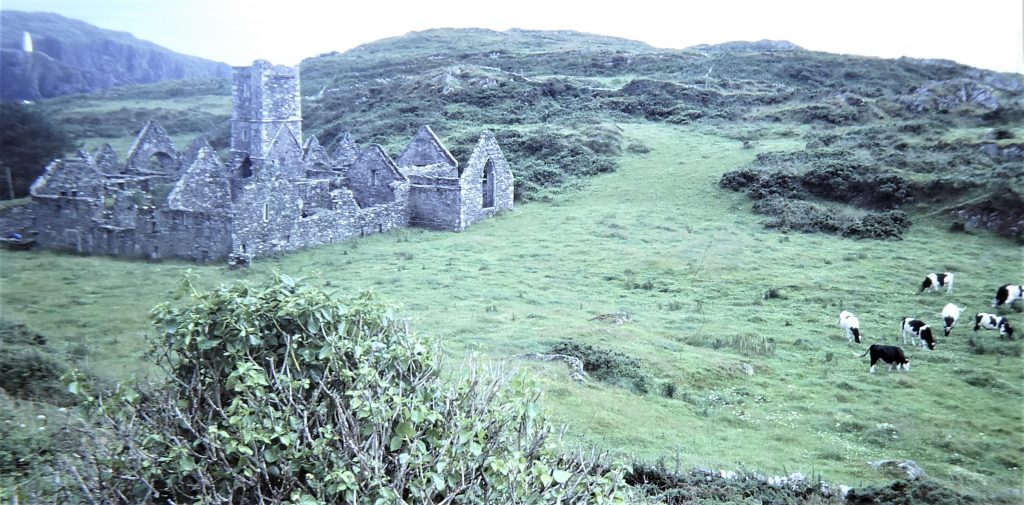 However, we learnt that many settlers were coming from overseas and doing up these cottages, and on our return walk we stopped to talk to an American couple, George Packard
However, we learnt that many settlers were coming from overseas and doing up these cottages, and on our return walk we stopped to talk to an American couple, George Packard 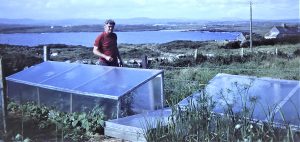 and Christina Lee, whose garden we were admiring. Not surprisingly, plants of all sorts grow easily in this climate, and the couple's herbaceous and vegetable gardens made Norma very envious! We were invited in for home-made wine, and asked to join them for lunch the next day.
and Christina Lee, whose garden we were admiring. Not surprisingly, plants of all sorts grow easily in this climate, and the couple's herbaceous and vegetable gardens made Norma very envious! We were invited in for home-made wine, and asked to join them for lunch the next day.
This turned out to be especially laid on by the Sherkin Hotel, and we were joined by Mrs "Tommy" Warren and her daughter Mary. After lunch we walked up to the Packard cottage for lots of talk about books (George is a writer), and then on to a neighbour's very nicely restored cottage for more wine and music played on an electronic keyboard.
 We stayed with George and Christina for the night and then took them for a fast sail in a good, fair wind of about 20 miles along the coast, east to the inlet of Castle Haven. We anchored off Castletownshend village, which turned out to be a prosperous-looking place by south-west Ireland standards. It was originally settled by Anglo-Irish groups escaping from Catholic marauders, and presently being rehabilitated through the influx of prosperous Europeans looking for summer houses.
We stayed with George and Christina for the night and then took them for a fast sail in a good, fair wind of about 20 miles along the coast, east to the inlet of Castle Haven. We anchored off Castletownshend village, which turned out to be a prosperous-looking place by south-west Ireland standards. It was originally settled by Anglo-Irish groups escaping from Catholic marauders, and presently being rehabilitated through the influx of prosperous Europeans looking for summer houses.
We met up again with the Warrens, who were among these settlers, in her exceptionally pleasant cottage. Tommy Warren was one of the original American woman aviator barnstormers. She showed us her flying licence, which she gained in 1930 and was signed by none other than Orville Wright!
[From an obituary in the Boston Globe, 2004: Margaret Thomas Warren was born in 1912, and was 73 when we met her. She fell in love with flying when she was eight years old and growing up in Texas. She took her first flying lesson at 14, had her full pilot's licence at 17 and became the youngest member of the Ninety-Nines, the group of women pilots founded by Amelia Earhart in 1929. She flew all kinds of small planes available at the time, from biplanes to a borrowed autogiro. She did stunt flying for airshows, delivered mail and took part in air races. Known as "Tommy," she and her husband Bayard moved in 1979 from the Boston area to live in Castletownshend, where she became a well-known patron of the arts. She returned to flying when she was 84, and flew a Cessna out of Cork. She died aged 92 in 2004. In her 1993 autobiography she wrote: "In those days I valued freedom and courage above all else. Then, flying represented a wish to transcend and overcome difficulties and, on the other hand, a longing to soar towards the celestial, to break the bonds of earth."]
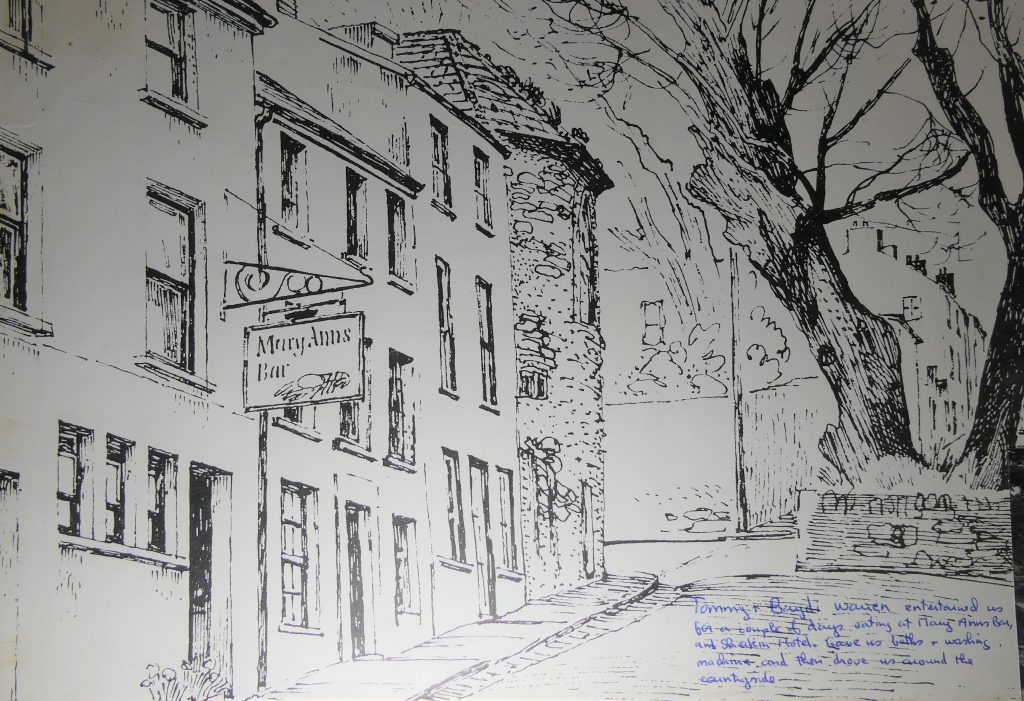
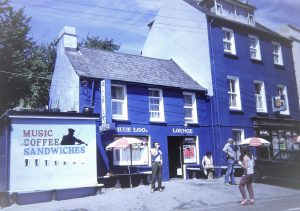 All of us, including Tommy's husband Bayard ("Baydie"), went down to the village pub, Mary-Ann's bar, and its restaurant for dinner. This lasted until after midnight, but by this time we were getting used to the fact that in these regions, every meal - and every event - is late.
All of us, including Tommy's husband Bayard ("Baydie"), went down to the village pub, Mary-Ann's bar, and its restaurant for dinner. This lasted until after midnight, but by this time we were getting used to the fact that in these regions, every meal - and every event - is late.
We were picked up the next morning by Mary Warren for a trip to the local centre, Skibbereen, for some stores and a walk around. It was a pleasant place, with a busy Catholic church, a quiet courthouse and a bishop's mansion. We hitch-hiked back, lastly given a lift by another older lady in a cottage, once a farmer with her late husband in Shropshire. Back at the boat we made friends with couples from a German and a South African boat, and we then went on for beers at Mary Ann's pub.
At 2:30 am we were awakened by a bang on the boat and the sound of voices. We jumped up on deck and scared off two young local men in a wooden skiff of a typical kind in these waters. We originally thought that they were going to climb on, but decided that they were going to try to steal our inflatable dinghy. (This was locked on to the yacht by a stainless steel cable, so this this was their second error, after hitting the boat and leaving a mark on the hull.) In the wet morning we took some washing ashore and to the Warrens' house and reported the night's event to the village garda. I commented that the blue colour of the mark left on our hull matched the rubbing strake on one of the skiffs on the beach. "Oh, that's the garda's boat!", they exclaimed. Stealing the local police boat was yet another of the boys' errors that night, and we were assured that the matter "would be taken care of".
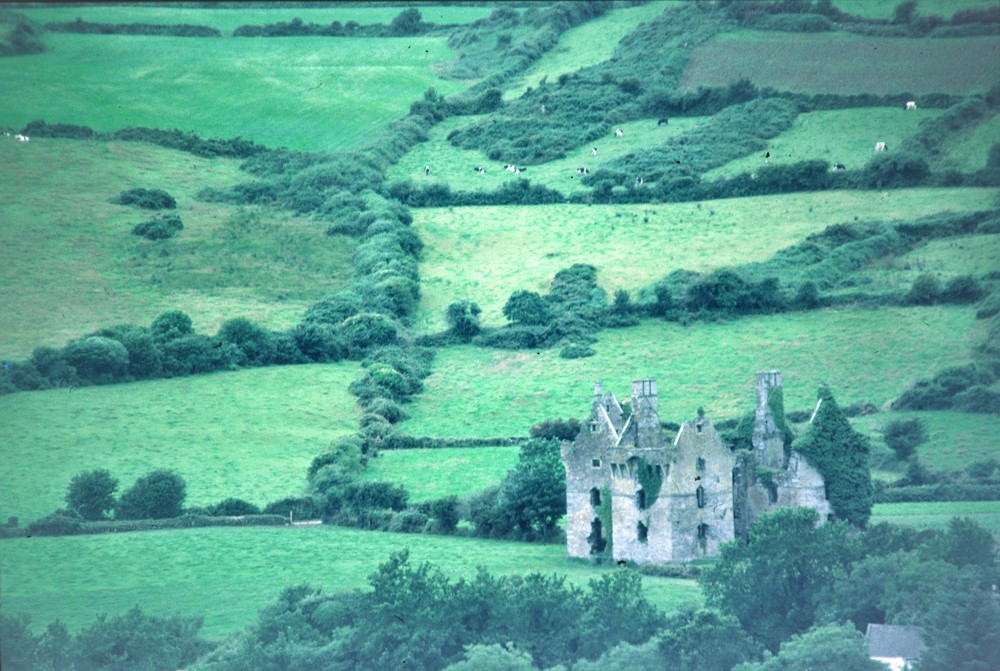
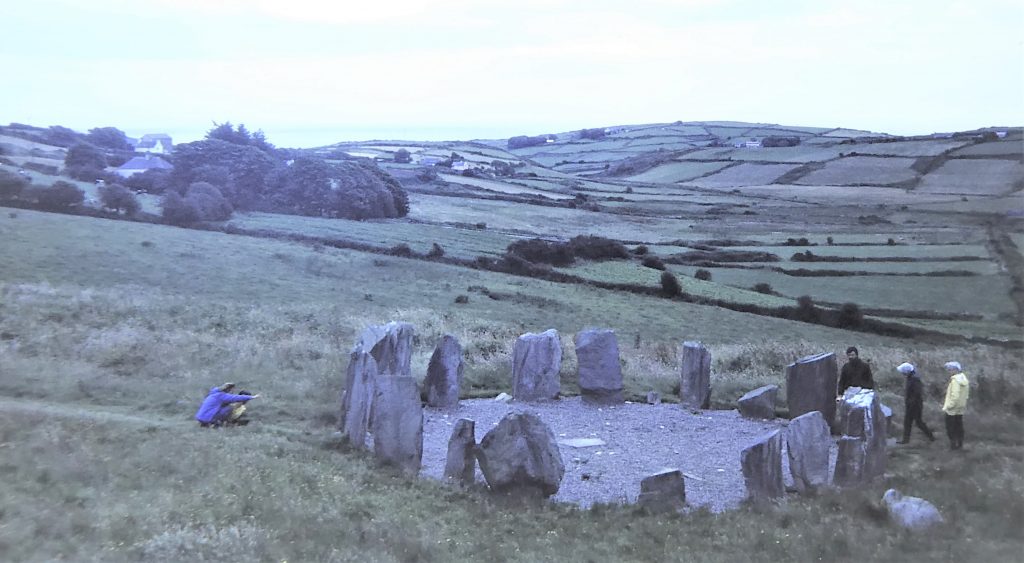 Baydie and Tommy Warren took us for a a tour of the area. We saw Coppinger Court, another picturesque ruin of a fortified mansion, sitting in the base of a narrow, fertile valley - an archetypal Irish scene. We walked round a Druids' circle at Drombeg, with a lovely view to the sea. We had lunch at Glandore, where we again came across the American writer of sail cruising guides Don Street, who had given us much good advice in Bermuda about sailing to Ireland. (Not that we took all of his advice - we chose not to call in to Halifax, Nova Scotia, which we thought was too far north.) Back at their house we had hot baths, Norma washed the sheets, and we finally made our very fond farewells and thanks for their outstanding hospitality and friendship. Back at the boat we were interviewed by a lassie from one of the local papers.
Baydie and Tommy Warren took us for a a tour of the area. We saw Coppinger Court, another picturesque ruin of a fortified mansion, sitting in the base of a narrow, fertile valley - an archetypal Irish scene. We walked round a Druids' circle at Drombeg, with a lovely view to the sea. We had lunch at Glandore, where we again came across the American writer of sail cruising guides Don Street, who had given us much good advice in Bermuda about sailing to Ireland. (Not that we took all of his advice - we chose not to call in to Halifax, Nova Scotia, which we thought was too far north.) Back at their house we had hot baths, Norma washed the sheets, and we finally made our very fond farewells and thanks for their outstanding hospitality and friendship. Back at the boat we were interviewed by a lassie from one of the local papers.
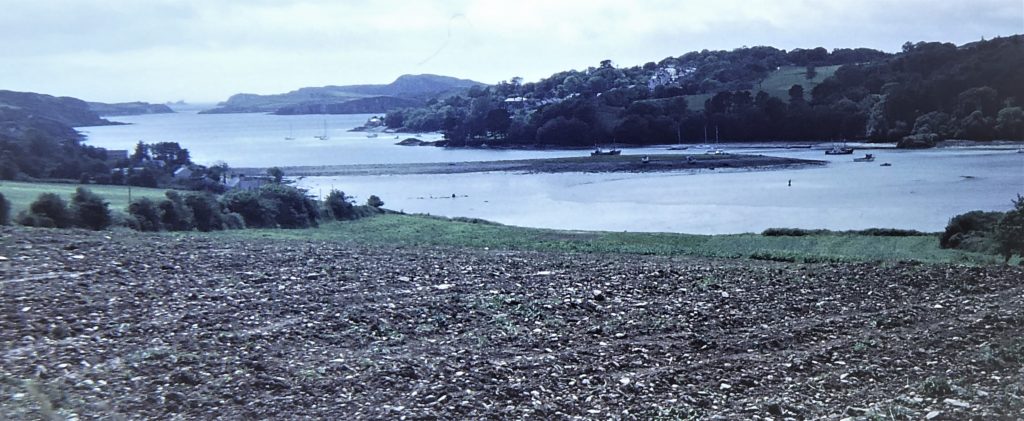
We were very sorry to leave the great anchorage of Castle Haven and our friends in Castletownshend, but on a foggy but otherwise favourable morning it was time to to pull out. We sailed round the Old Head of Kinsale with its mournful fog siren, and after an eight-hour passage with a fair wind, anchored opposite the yacht club in Kinsale Harbour. In the snake-like turns of the final approach to the town we passed between two prominent forts, the large Charles Fort to the east and the smaller James Fort on the west side. The inlet becomes the River Bandon, on which Kinsale lies.
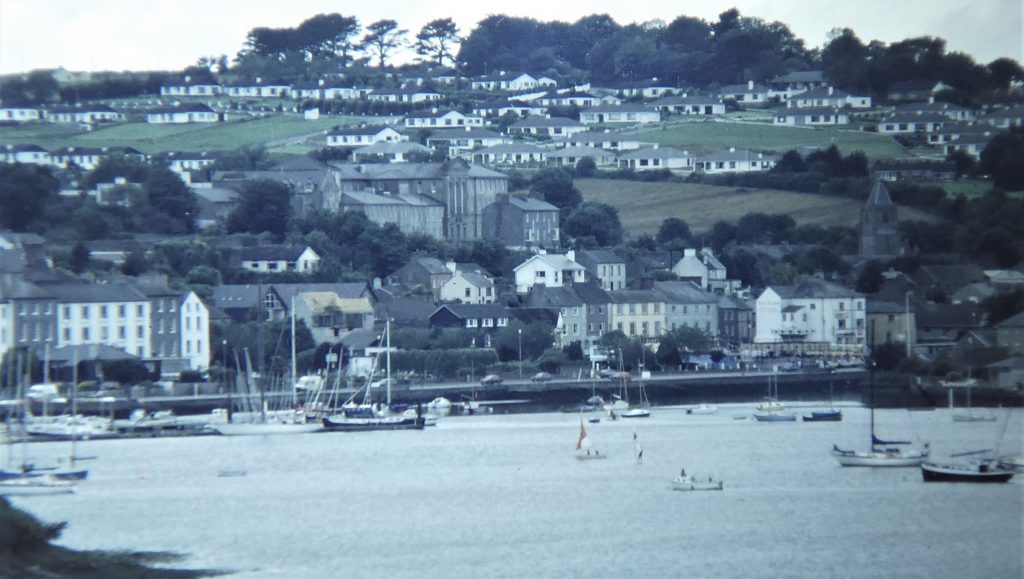
The fog continued during the following morning. We took a walk round Kinsale, a historic fishing port and the biggest town we had visited by sea for a very long time. We found it a charming place, with lots of old stone buildings and neat and tidy streets. We took a guided walking tour in the afternoon, and visited a Norman church with the remains of an old monastery, and an excellent museum in the 16th century courthouse.
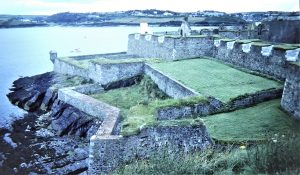 We took a walk out to the splendid and very well reconstructed Charles (after Charles II) Fort, at the entry to the harbour. Otherwise, in continuing wet and foggy weather, we got on with correspondence and other mundane tasks, and showered at the yacht club.
We took a walk out to the splendid and very well reconstructed Charles (after Charles II) Fort, at the entry to the harbour. Otherwise, in continuing wet and foggy weather, we got on with correspondence and other mundane tasks, and showered at the yacht club.
When the skies cleared for the nicest day for a long time we motorsailed round to the wide expanse of Cork Harbour. Shortly after turning in from the sea we turned left, to the west, and into the inlet of Crosshaven. There is a village there, it is the primary anchorage for yachts in Cork Harbour, and is the site of the Royal Cork Yacht Club and its marina.
The predecessor of the Royal Cork Yacht Club was the Water Club of the Harbour of Cork, established in 1720 by William O'Brien, 4th Earl of Inchiquin. The club's location and name changed several times before it received from King William IV the privilege of using the "royal" prefix and was finally established in Crosshaven. As we approached the village we were delighted to see the yacht Goose tied up at the Crosshaven Boatyard. Accordingly, we soon caught up with our good friends George and Teresa Coburn, who had shared with us our difficult long passage across the north Atlantic ocean. We rafted up alongside them.
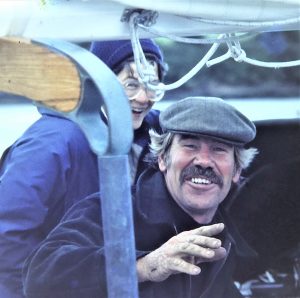 With them we went up to the attractive Cronin's pub and then on to the RCYC for dinner. During our time in Ireland we had been received by all local sailors with the utmost courtesy and friendship. At the yacht club we came up against, for the first time, the tendency for snobbishness among the posh members of any European boat club with the appendage "royal". We had been assured that the facilities of the club would be open to us, as we were members of an equivalent club in our own countries (the Royal Sydney Yacht Squadron, in my case). But it would have to be admitted that our clothing, although among the better quality chosen from the limited wardrobe of each of our long-distance cruising yachts, might be regarded as scruffy compared to the well-tailored members of the RCYC. We were placed in a hidey-hole corner of the dining room until George insisted, in his assertive American accent, that we had just sailed across the Atlantic and merited a better position. Which they gave us. And the meal was quite good.
With them we went up to the attractive Cronin's pub and then on to the RCYC for dinner. During our time in Ireland we had been received by all local sailors with the utmost courtesy and friendship. At the yacht club we came up against, for the first time, the tendency for snobbishness among the posh members of any European boat club with the appendage "royal". We had been assured that the facilities of the club would be open to us, as we were members of an equivalent club in our own countries (the Royal Sydney Yacht Squadron, in my case). But it would have to be admitted that our clothing, although among the better quality chosen from the limited wardrobe of each of our long-distance cruising yachts, might be regarded as scruffy compared to the well-tailored members of the RCYC. We were placed in a hidey-hole corner of the dining room until George insisted, in his assertive American accent, that we had just sailed across the Atlantic and merited a better position. Which they gave us. And the meal was quite good.
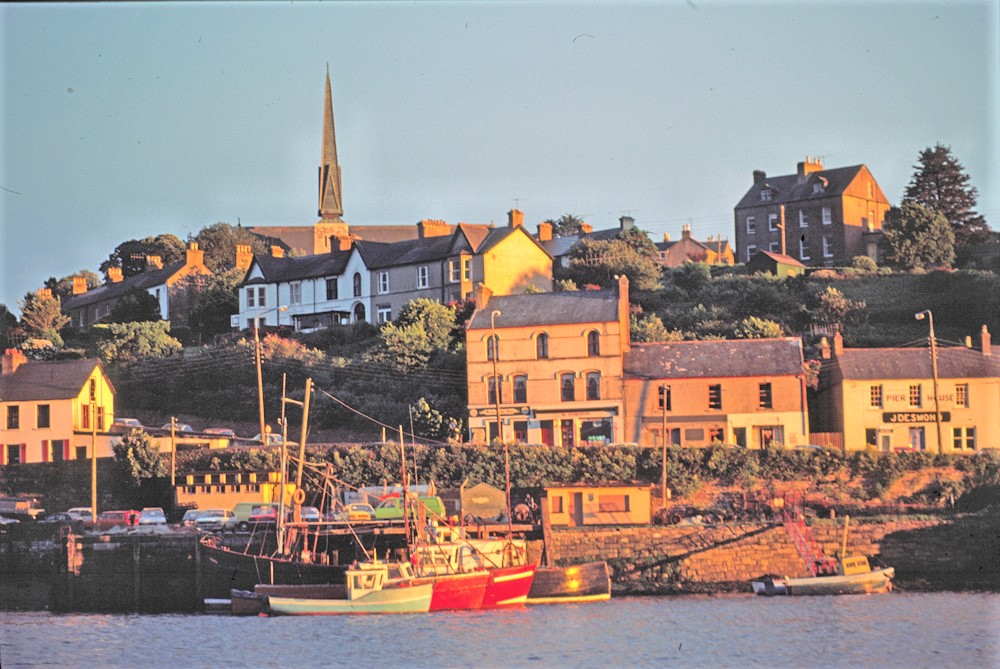 After dinner we repaired to the nearby and pretty simple "divers" pub for a few more beers and a chat with the local people and sailors. Norma and I soon went back to the boat and bed, while George and Teresa continued with the party. The next morning we heard the story of the evening.
After dinner we repaired to the nearby and pretty simple "divers" pub for a few more beers and a chat with the local people and sailors. Norma and I soon went back to the boat and bed, while George and Teresa continued with the party. The next morning we heard the story of the evening.
One of the Irishmen, full of beer, starting making disparaging remarks about "bloody Yanks". George, a retired colonel in the US Special Forces with long combat experience, did not take kindly to that. Serious disputation led to the ejection of the Irishman. While we were talking about those events the pub proprietor came down to our boats offering abject apologies and any local assistance we required. Friendly relationships were resumed, with no hard feelings.
Goose was waiting for a new engine to be fitted, and we went to anchor in the river near the town wharf, between the boat yard and the RCYC. On the wharf Norma picked up a big skate that had been dumped there by a sport fisherman; later, we had George and Teresa over for dinner: skate pie! Early next morning we tied up to the wharf to dry the boat out at low tide, and we gave a hull a scrub and a coat of antifouling. When that was all over we motored up the river for half a mile and anchored in the peaceful surroundings of fields and trees.
We then stayed put for a few days, taking walks when possible, waiting out a period of rotten weather. It was windy and wet most of the time in the anchorage, and gales were persistently forecast for all sea areas around Ireland and south-west England. The barometer dropped from 1012 to 989 MB, and television in the club was showing massive waves in the Irish Sea - our next challenge.
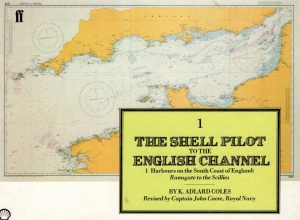 Having sat things out and dithered for six days we finally farewelled Goose and motored out of Crosshaven on 7 August in a sloppy swell and under thick but scattered clouds. Under sail, we had a good run all day, and sighted the lights of Lands End at 0300 the next morning - England at last! The wind was easing but the forecast was now for a serious gale ("Force 8, soon"), so we fired up the motor to help get us round Lands End and the Lizard Point as quickly as possible. By 1500 we were approaching the mouth of Falmouth Harbour, just seeing Pendennis Castle up to our left in the mist.
Having sat things out and dithered for six days we finally farewelled Goose and motored out of Crosshaven on 7 August in a sloppy swell and under thick but scattered clouds. Under sail, we had a good run all day, and sighted the lights of Lands End at 0300 the next morning - England at last! The wind was easing but the forecast was now for a serious gale ("Force 8, soon"), so we fired up the motor to help get us round Lands End and the Lizard Point as quickly as possible. By 1500 we were approaching the mouth of Falmouth Harbour, just seeing Pendennis Castle up to our left in the mist.
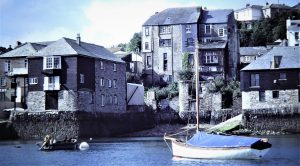
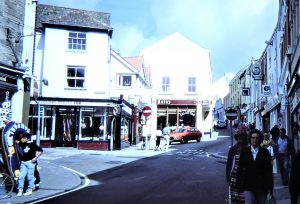 We came to anchor off the town, right next to Jacque and Madeleine, an impecunious French couple in a steel ketch, whom we had met in Fiji. We were very soon approached by a Customs boarding officer, who advised us that we would have to contact other officials ashore, among other matters to seek an extension of our six-month temporary import permit for the yacht.
We came to anchor off the town, right next to Jacque and Madeleine, an impecunious French couple in a steel ketch, whom we had met in Fiji. We were very soon approached by a Customs boarding officer, who advised us that we would have to contact other officials ashore, among other matters to seek an extension of our six-month temporary import permit for the yacht.
 We took an exploratory walk ashore to Falmouth, the biggest town since the USA, with big shops including chandleries. A very attractive place, we thought, in lovely surroundings. We organised to trade our two outboards, of 10 and 2 hp, for a new 4 hp Suzuki, which could be used for both our small hard dinghy and the larger inflatable.
We took an exploratory walk ashore to Falmouth, the biggest town since the USA, with big shops including chandleries. A very attractive place, we thought, in lovely surroundings. We organised to trade our two outboards, of 10 and 2 hp, for a new 4 hp Suzuki, which could be used for both our small hard dinghy and the larger inflatable.
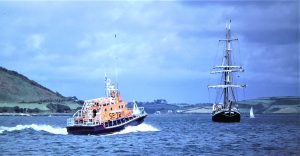 After a couple of days the long-forecast wind came in with a vengeance, Beaufort scale Force 9 (strong gale, 40-47 knots, seas 7-10 metres) by 10:00 on 11 August, along with heavy rain. It was the early stage of the famous Fastnet yacht race. The VHF radio was full of drama all day, culminating in reports of the overturning of the maxi yacht Drum, owned by Simon le Bon of the band Duran Duran. The keel had sheared off (because of a design error) a couple of miles off Falmouth Harbour, and the boat became stabilised in the inverted position. Most of the crew managed to scramble on to the upturned hull, but six of them, including Le Bon, were trapped in an air pocket within the inverted yacht. They were all helped out by a diver from a helicopter rescue crew in the 771 RN Air Squadron.
After a couple of days the long-forecast wind came in with a vengeance, Beaufort scale Force 9 (strong gale, 40-47 knots, seas 7-10 metres) by 10:00 on 11 August, along with heavy rain. It was the early stage of the famous Fastnet yacht race. The VHF radio was full of drama all day, culminating in reports of the overturning of the maxi yacht Drum, owned by Simon le Bon of the band Duran Duran. The keel had sheared off (because of a design error) a couple of miles off Falmouth Harbour, and the boat became stabilised in the inverted position. Most of the crew managed to scramble on to the upturned hull, but six of them, including Le Bon, were trapped in an air pocket within the inverted yacht. They were all helped out by a diver from a helicopter rescue crew in the 771 RN Air Squadron.
About 100 yachts pulled out of the race, with 12 dismasted. They included Lion of New Zealand, with whose skipper Peter Blake we had chatted during the Atlantic crossing. They had ripped their kevlar mainsail. We visited Lion a little later and were shown over her by Peter Blake - a very impressive long-distance racing yacht.

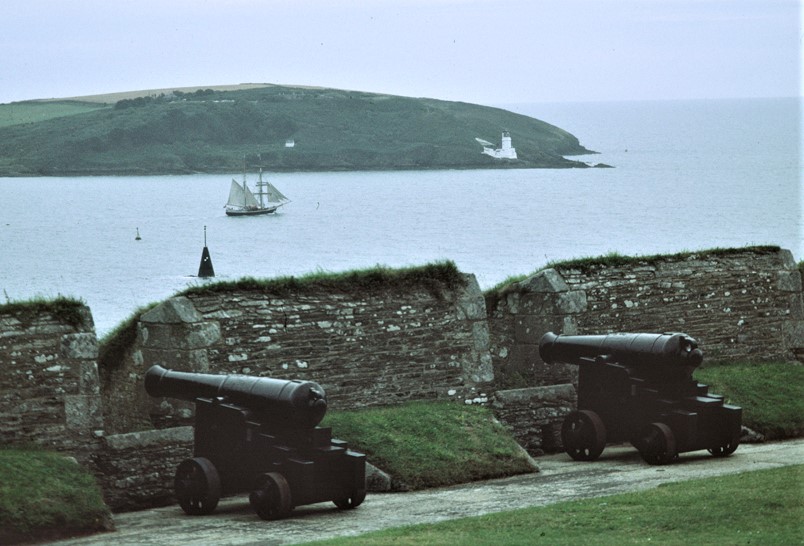 After the gale eased we walked up to Pendennis castle, on the astern headland with a lovely view over the entrance. It has an interesting concentric structure and was built by Henry VIII with a view to countering the Pope's crusade against him. Many of the many other forts he built for the same reason have this rounded shape. We had a good lunch in the old Falmouth Hotel, where Simon Le Bon was surrounded by admirers. Another southerly gale came through overnight, after which we had another look round the town and took the dinghy and its new outboard up the Penryn River. Meanwhile, a catamaran speedboat attempting a record transatlantic passage fell foul of "our" gales and was sunk only 100 miles from the Scilly Isles.
After the gale eased we walked up to Pendennis castle, on the astern headland with a lovely view over the entrance. It has an interesting concentric structure and was built by Henry VIII with a view to countering the Pope's crusade against him. Many of the many other forts he built for the same reason have this rounded shape. We had a good lunch in the old Falmouth Hotel, where Simon Le Bon was surrounded by admirers. Another southerly gale came through overnight, after which we had another look round the town and took the dinghy and its new outboard up the Penryn River. Meanwhile, a catamaran speedboat attempting a record transatlantic passage fell foul of "our" gales and was sunk only 100 miles from the Scilly Isles.
 Drum was carefully towed into the harbour upside down, after some modifications to her tall mast to allow for the shallow water, five metres and less. She was placed on a mooring close to us.
Drum was carefully towed into the harbour upside down, after some modifications to her tall mast to allow for the shallow water, five metres and less. She was placed on a mooring close to us.
At last we had a gale-free morning forecast, albeit still wet, and - along with several other boats - set out for a gentle sail east to Plymouth Harbour, skipping our originally-intended visit to Fowey. Out to sea we could see the Eddystone Lighthouse, surrounded by  menacing-looking rocks and an angry surf. We passed the immense Plymouth breakwater standing by itself about two miles out from the docks, rounded Drake's Island and anchored in Barn Pool under the harbour's rural western shore. We took the dinghy over to the Mayflower marina, on the town side of the harbour, but it seemed too far from the centre to be a useful place to stay. A closer marina in Mill Bay looked scruffy and unattractive. We decided to stay at anchor where we were.
menacing-looking rocks and an angry surf. We passed the immense Plymouth breakwater standing by itself about two miles out from the docks, rounded Drake's Island and anchored in Barn Pool under the harbour's rural western shore. We took the dinghy over to the Mayflower marina, on the town side of the harbour, but it seemed too far from the centre to be a useful place to stay. A closer marina in Mill Bay looked scruffy and unattractive. We decided to stay at anchor where we were.
 We had more luck the next day, getting a good welcome from the Royal Western YC with the assurance of showers and other services we might want. From there we walked over Plymouth Hoe, with its inevitable statue of Sir Francis Drake, and on into the commercial centre and lunch at a pub. It's a relatively "new" city, of course, because it was smashed to pieces by the Luftwaffe and then rebuilt to new plans. Back at the boat, in drizzle and mist, we had a friendly visit and check of papers by a Customs launch.
We had more luck the next day, getting a good welcome from the Royal Western YC with the assurance of showers and other services we might want. From there we walked over Plymouth Hoe, with its inevitable statue of Sir Francis Drake, and on into the commercial centre and lunch at a pub. It's a relatively "new" city, of course, because it was smashed to pieces by the Luftwaffe and then rebuilt to new plans. Back at the boat, in drizzle and mist, we had a friendly visit and check of papers by a Customs launch.
 It cleared a bit for an excellent walk up through Mount Edgcumbe, by which we were anchored. There were some beautiful formal gardens in various national styles, sweeping up over expansive grounds up to the country house and the folly, an imitation ruin (!) overlooking Plymouth Sound.
It cleared a bit for an excellent walk up through Mount Edgcumbe, by which we were anchored. There were some beautiful formal gardens in various national styles, sweeping up over expansive grounds up to the country house and the folly, an imitation ruin (!) overlooking Plymouth Sound.
We were at anchor there for just a weekend, and then pulled out into continuing what I recorded in the log as "revolting weather". In quite a strong following wind 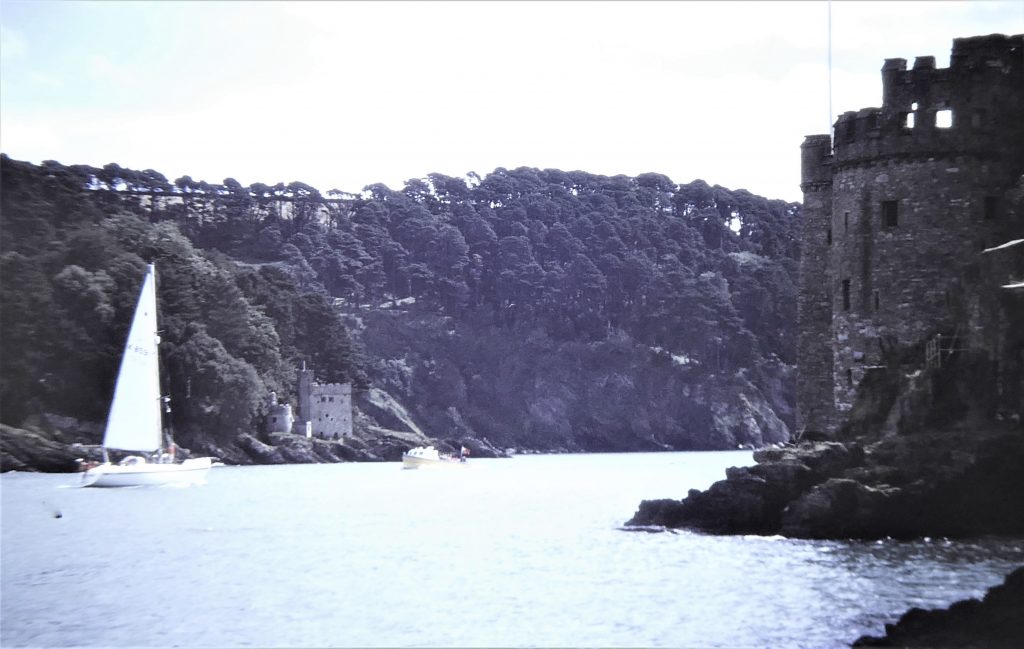 we sailed down past Salcombe and round one of the south coast promontories, Start Point. We then turned north and up the coast to the River Dart. We sailed into the river through the narrow and gorgeous entry between facing castles and into Dartmouth Harbour. It was a fast little sail as the sun started peeping through, and by mid-day we were anchored opposite the town on the eastern, Kingswear, side of the harbour. The Dartmouth YC was nearby, and we became temporary members with access to their facilities including - importantly - their showers.
we sailed down past Salcombe and round one of the south coast promontories, Start Point. We then turned north and up the coast to the River Dart. We sailed into the river through the narrow and gorgeous entry between facing castles and into Dartmouth Harbour. It was a fast little sail as the sun started peeping through, and by mid-day we were anchored opposite the town on the eastern, Kingswear, side of the harbour. The Dartmouth YC was nearby, and we became temporary members with access to their facilities including - importantly - their showers.
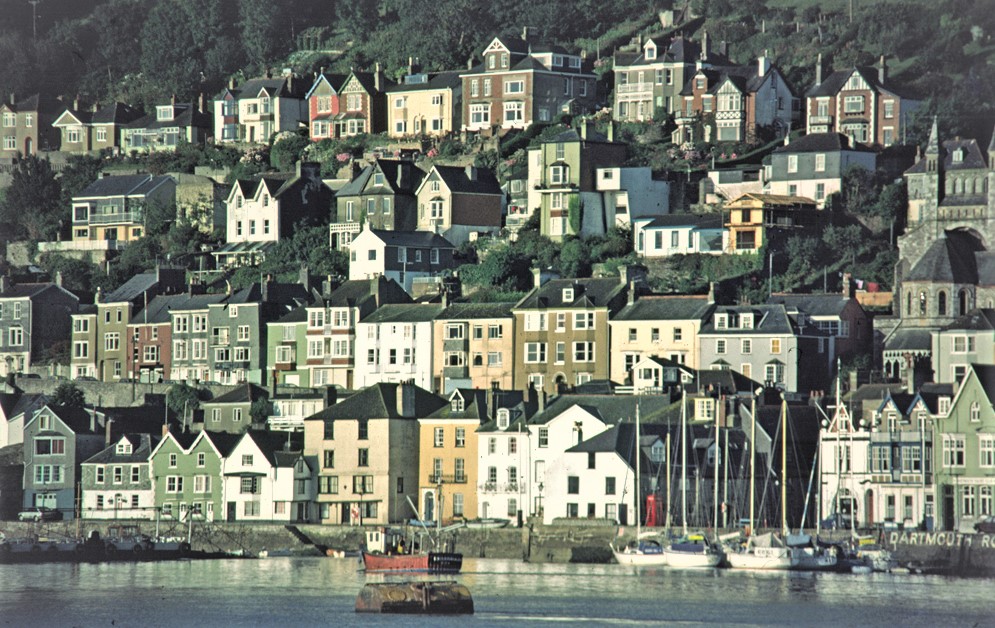
We took the dinghy across the River Dart to the lovely little town, with little houses in tiers rising up the cliff-like face of the town across the river from us. The beautiful 14th century church had an amazing wooden screen and some lovely brasses. We strolled along the cobbled waterfront, from which the Mayflower had sailed away west with the 102 members of puritan English families known as the Pilgrims to their "new Promised Land" in 1620. Their tough passage, in early winter, took 10 weeks.
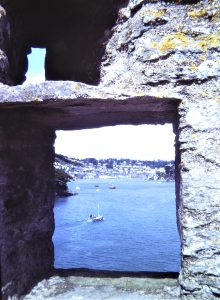 Back aboard in time for the courteous harbour officer to relieve us of our harbour dues. An Australian and a Kiwi boat were anchored nearby, so we all got together to complain about what my log records as "class-ridden and generally inhospitable English yachtsmen"! In improving weather we walked along to Dartmouth Castle, on the western side of the entrance, and joined the English Heritage organisation, which would give us free entry to most of England's most historic places and structures. We got together with an English couple in a small yacht who were neither class-ridden nor unfriendly!
Back aboard in time for the courteous harbour officer to relieve us of our harbour dues. An Australian and a Kiwi boat were anchored nearby, so we all got together to complain about what my log records as "class-ridden and generally inhospitable English yachtsmen"! In improving weather we walked along to Dartmouth Castle, on the western side of the entrance, and joined the English Heritage organisation, which would give us free entry to most of England's most historic places and structures. We got together with an English couple in a small yacht who were neither class-ridden nor unfriendly!
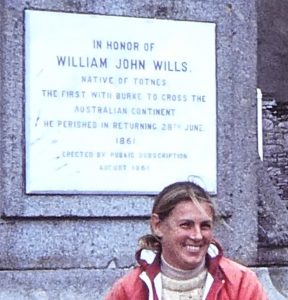 We took a longish dinghy trip further up the River Dart, about 15 kilometres. We visited Dittisham first, a typically pretty Cornish village with steep streets and nice views. We made it all the way up to Totnes, an old borough with a Norman castle and a sandstone church. In Totnes there is a memorial in honour of William John Wills, a native of the town who, with Robert Burke, was the first to cross Australia from south to north but who perished on the return trip.
We took a longish dinghy trip further up the River Dart, about 15 kilometres. We visited Dittisham first, a typically pretty Cornish village with steep streets and nice views. We made it all the way up to Totnes, an old borough with a Norman castle and a sandstone church. In Totnes there is a memorial in honour of William John Wills, a native of the town who, with Robert Burke, was the first to cross Australia from south to north but who perished on the return trip.
We had a good lunch in the town. Another outing was a full-day bus ride on an Explorer ticket, a fascinating run through narrow roads around the coast - with a lovely view from the front of the upper deck - and brief visits to Plymouth and Torquay.
Dartmouth had been a good stay, just over a week, but despite continuing misty-drizzly weather we had to get going again. In fair but changeable winds we rounded 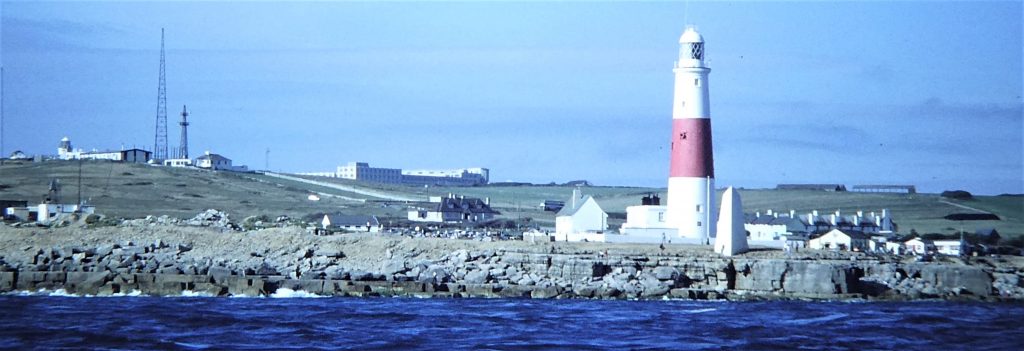 the notorious Portland Bill with a favourable tide and turned north up to Weymouth Harbour. We aimed for Custom House Quay, where yachts were rafted up, and the harbourmaster directed us to tie up to a large (RAF) racing yacht, whose crew turned out to be a snooty and unfriendly mob. After an altercation with its skipper the next morning we moved ourselves to tie directly along the harbour wall (there was nowhere to anchor in the harbour). Two friendly British boats then rafted up outside us and two more outside them, which meant we
the notorious Portland Bill with a favourable tide and turned north up to Weymouth Harbour. We aimed for Custom House Quay, where yachts were rafted up, and the harbourmaster directed us to tie up to a large (RAF) racing yacht, whose crew turned out to be a snooty and unfriendly mob. After an altercation with its skipper the next morning we moved ourselves to tie directly along the harbour wall (there was nowhere to anchor in the harbour). Two friendly British boats then rafted up outside us and two more outside them, which meant we 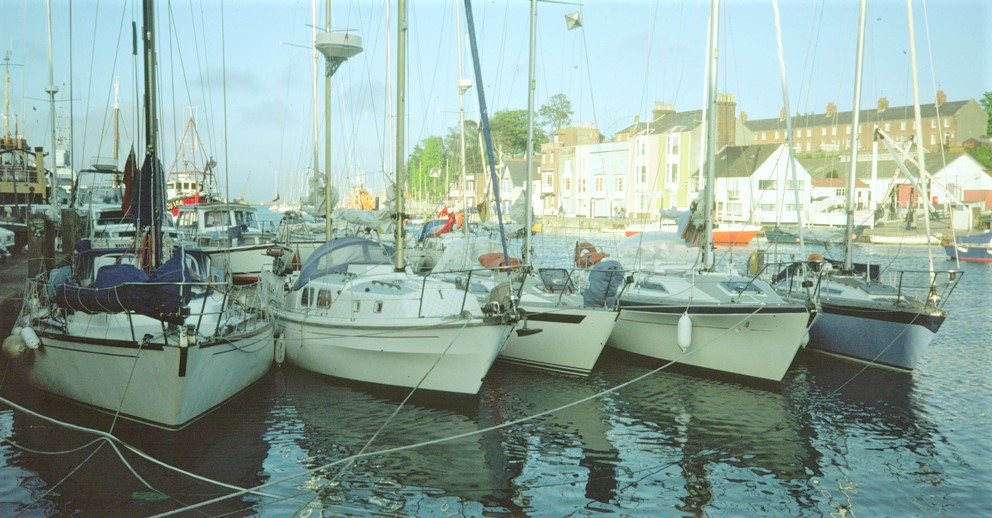 ended up with the most favourable berth for shore access and the worst for people thumping across the deck - although, to be fair, most experienced sailors tiptoed quietly round the foredeck. A train ran slowly along the quay right next to us from time to time.
ended up with the most favourable berth for shore access and the worst for people thumping across the deck - although, to be fair, most experienced sailors tiptoed quietly round the foredeck. A train ran slowly along the quay right next to us from time to time.
 Ashore, we found an English seaside resort that was almost a caricature of its kind. There was a classic esplanade backed by scores of little boarding houses, a British beach of stones, poor ice cream, sugary Weymouth rock and racy postcards. Incredibly, the skies cleared to a blue, hot afternoon, so we saw lots of white handkerchiefs on heads!
Ashore, we found an English seaside resort that was almost a caricature of its kind. There was a classic esplanade backed by scores of little boarding houses, a British beach of stones, poor ice cream, sugary Weymouth rock and racy postcards. Incredibly, the skies cleared to a blue, hot afternoon, so we saw lots of white handkerchiefs on heads!
 We took a bus to Portland Bill and walked to the top, but it was shrouded by cloud. We visited Portland Castle, down on the spit connecting the promontory from the mainland. This was another typical Henry VIII defensive structure, tucked in by the grounds of the Naval Air Station.
We took a bus to Portland Bill and walked to the top, but it was shrouded by cloud. We visited Portland Castle, down on the spit connecting the promontory from the mainland. This was another typical Henry VIII defensive structure, tucked in by the grounds of the Naval Air Station.
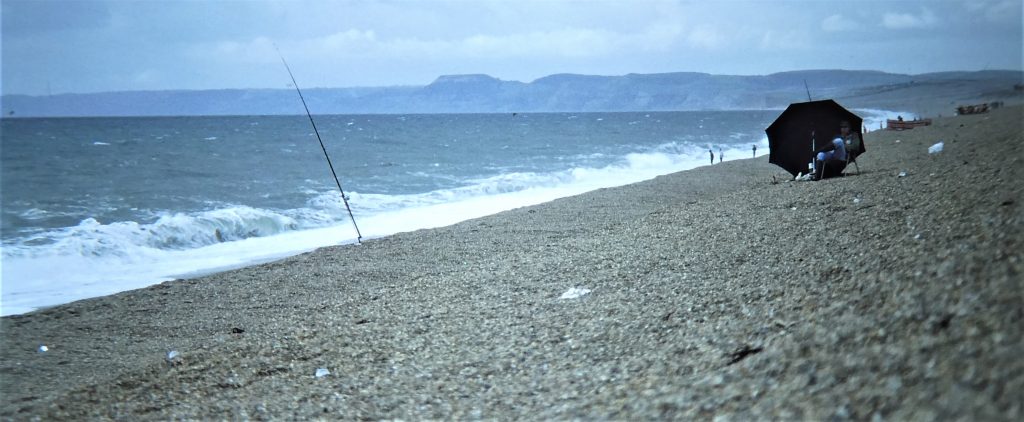
Katie came down with Tony and Robert for lunch and took us over to the extraordinary Chesil Beach, a 12-mile stretch of smooth pebbles. We became friendly with a couple ashore, and were taken for a ride to Dorchester, Hardy country - some lovely old stone buildings and and excellent museum centred on Thomas Hardy and his life and works.
On our last night here, fast asleep, we heard a thump up forward. "Someone's come aboard", I whispered. I went back to the saloon, where I found an old drunk making himself comfortable on the starboard settee. "What the hell are you doing here?", I explained. "Well", he replied. "They threw me out of the pub!"
In the morning there was another gale warning, but for "later", and we thought - with the favourable tidal stream - that we would make the Solent in time. In a fair wind and tide we flew past the Needles into the western part of the Solent and turned up through sand banks into the Lymington River and up to the eponymous harbour. We knew from our harbour guide that the whole inlet would be packed by hundreds of yachts but with no room to anchor, and we tied up between visitors' buoys.
Soon enough the rain and a strong SW wind came in as forecast. So much of our time in the Channel was spent balancing forecasts with tidal heights and streams that if we had waited for really good conditions for every leg, we would never have got anywhere. Generally, we found sailing this coast pretty tiresome, and if we had continued to live in southern England we would probably not have become sailors. The generally poor visibility and the tides make passage-planning hard, one big problem being that unless you want to make a series of detours way offshore, the headlands have to be cut very close to get inside the tidal races. And these can be ferociously rough, even in good conditions. But because of poor visibility we couldn’t see many of these headlands until within a mile or two. And the timing is critical, because if the tide’s against you, you’re near stationary. To be fair, though, this was accepted to be a poor summer, even by UK standards.
Lymington is famous for its yachting facilities, and is a pretty little place where we needed to do some shopping. We were only there for a couple of nights, the second of which was cold; ground frost was reported in some southern counties! We motored out of the river back to the Solent, and then a short distance up the Hampshire coast to the Beaulieu River. The entrance is well up into the western half of the Solent, generally opposite Cowes on the Isle of Wight. The outer end of the river was hard to see, as it winds around wide sand banks that are not visible from outside, but it is well marked once you get close enough to see the marks. We motored up the river past hundreds of moorings with flat green fields and woodland each side, and reached Bucklers Hard, acknowledged to be the most beautiful anchorage in the Solent. It's easy to agree with that claim.

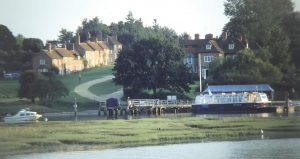 There's no room to anchor in the river, and we tied between two pilings with some difficulty, just as the tide was changing. We went ashore for a quick walk around the tiny, charming village and returned to the boat for a pleasant evening. The next day, Saturday, the large set of pilings rapidly filled up, this being a Saturday, including two large groups from sailing clubs who all knew each other. We soon found ourselves in the middle of a mass of yachts, with five rafted each side of us. Their crews shouted happily to each other and across us, but in the Solent yachtsman's way totally ignored us, with no recognition whatsoever, let alone a welcome. Several members of my English family, including my mother and sister - both last seen on a UK flying visit years before we left by sail - came down for a visit to the boat and a good lunch ashore. It was, fortunately, a blue and pleasant day.
There's no room to anchor in the river, and we tied between two pilings with some difficulty, just as the tide was changing. We went ashore for a quick walk around the tiny, charming village and returned to the boat for a pleasant evening. The next day, Saturday, the large set of pilings rapidly filled up, this being a Saturday, including two large groups from sailing clubs who all knew each other. We soon found ourselves in the middle of a mass of yachts, with five rafted each side of us. Their crews shouted happily to each other and across us, but in the Solent yachtsman's way totally ignored us, with no recognition whatsoever, let alone a welcome. Several members of my English family, including my mother and sister - both last seen on a UK flying visit years before we left by sail - came down for a visit to the boat and a good lunch ashore. It was, fortunately, a blue and pleasant day.
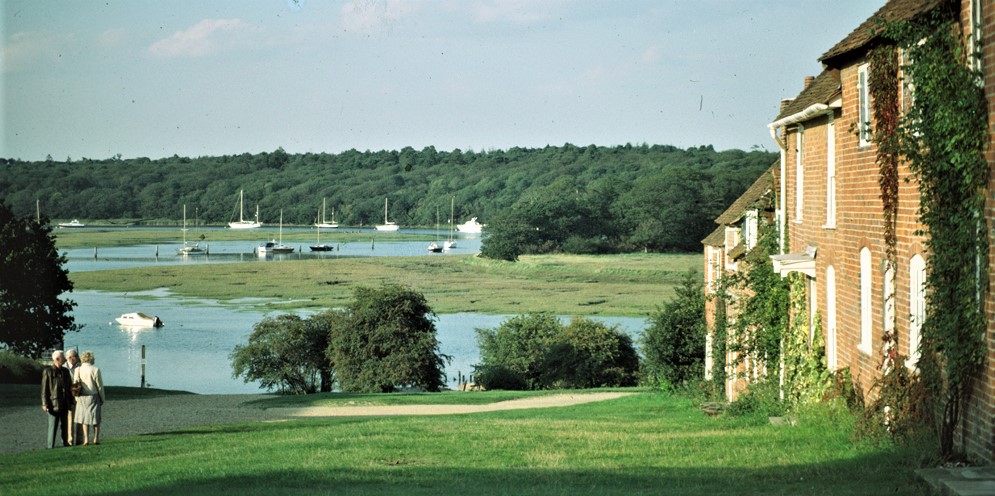
The Bucklers Hard Maritime Museum, visited on the Sunday, was an excellent exposition of the substantial wooden ship-building industry that was established on the Hard in the 18th century. Several ships of the line were constructed here. Most of the terraced houses leading down the grassy way to the river have been beautifully remodelled to represent their original interiors. We took a dinghy trip further up the river to the pretty village of Beaulieu, featuring wood-framed houses covered with ivy along the riverfront. By the time we got back the mob had left the pilings, and we motored down the river to a vacant mooring in peace and quiet. "Back to cruising", as Norma said. It was a lovely evening - three days in a row!
We spent the next day aboard, and then motored back out to the Solent. In a drifting, peaceful sail during the day we passed several sombre, deserted old forts planted in the water and effectively marking the extreme edges of the main shipping channel. We got out of the way of a warship coming out of Portsmouth. At the eastern end of the Solent waters myriad marks helped us to avoid the shoals extending south from Hayling Island, and finally we entered Chichester Harbour. The entrance is shallow at 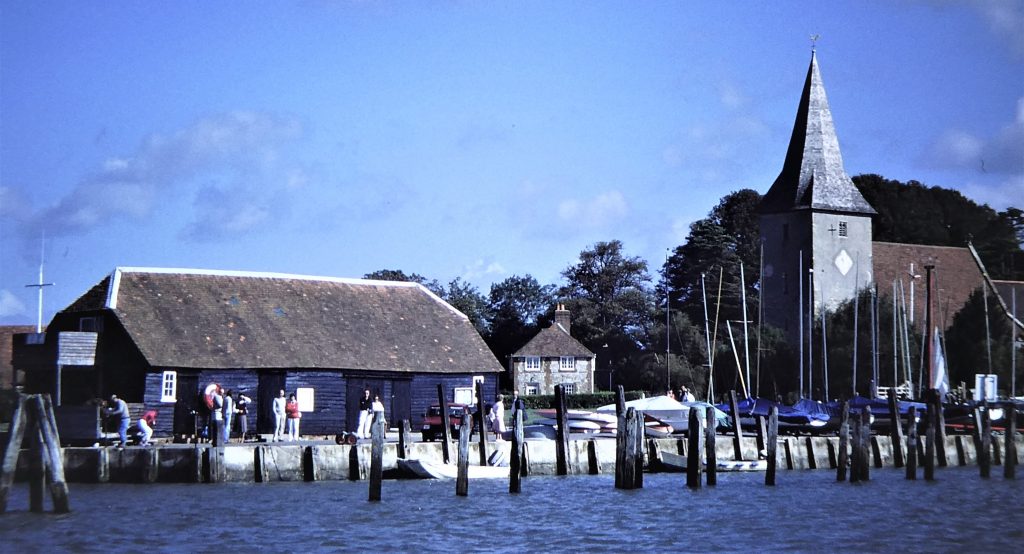 low water and we required mid-tide for our draft, a timing issue as usual. The channels throughout the harbour looked challenging on the chart, but in practice the several markers made the way easier than we anticipated. We navigated two forks in the channels between the mud banks (invisible other than at low tide) and came to anchor near Itchenor. We were peacefully by ourselves, and the next day in continuing fine weather we took the dinghy up to Bosham, along a channel to the north. This was another delightfully pretty little place, but with very limited stores, so we took the bus into Chichester for food and a gas bottle exchange.
low water and we required mid-tide for our draft, a timing issue as usual. The channels throughout the harbour looked challenging on the chart, but in practice the several markers made the way easier than we anticipated. We navigated two forks in the channels between the mud banks (invisible other than at low tide) and came to anchor near Itchenor. We were peacefully by ourselves, and the next day in continuing fine weather we took the dinghy up to Bosham, along a channel to the north. This was another delightfully pretty little place, but with very limited stores, so we took the bus into Chichester for food and a gas bottle exchange.
Over the next few days we had more visits, this time from Norma's parents and cousins, all residents of the area. We stayed the night ashore and visited some of the Selsey sights. Back aboard, the weather was reverted to cool, overcast and increasingly windy - this was causing some drama among local weekend sailors. The wind blew us off the narrow channel as the tide changed, 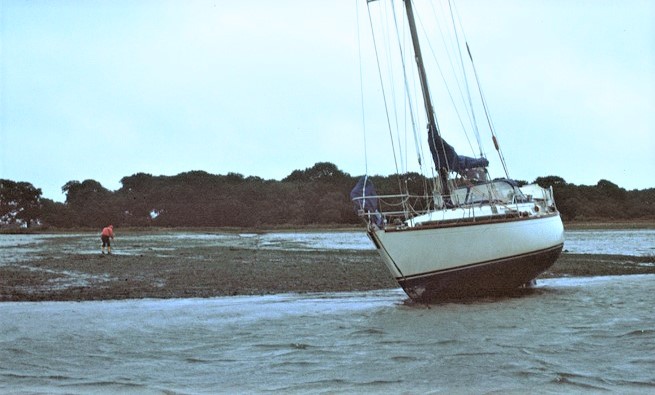 and at low tide we were completely out of the water, lying with the keel deep in the mud. This was no great drama for us, and Norma went out in the glutinous mud collecting a meals-worth of cockles. Once floating again we kept off the mud bank by using the rudder to shear us off in the tidal stream.
and at low tide we were completely out of the water, lying with the keel deep in the mud. This was no great drama for us, and Norma went out in the glutinous mud collecting a meals-worth of cockles. Once floating again we kept off the mud bank by using the rudder to shear us off in the tidal stream.
We returned to Bosham for a closer look, including the world's prettiest sailing club and the Saxon church with links to Kings Harold and Canute. We then took the boat out and motored to near the end of the Emsworth Channel, anchoring at high tide in what seemed to be the middle of nowhere. By this time we had been recognised by some locals as long-distance sailors, and we went ashore for an interview for a southern television station. We were filmed carrying a couple of sails to a local chandlery (we were selling them, as it happened, a lightweight spinnaker and old mainsail both surplus to needs), and then took the boat out followed by the TV crew in a hired a fishing boat, filming us out for a day sail - something we never did!
After the customary wait for clearing weather, during which we took a walk on Hayling Island and collected blackberries, we shot out of Chichester Harbour early one morning on a strong ebb tide. Because we had to make our destination before the next cold front, we motored in oily calm to Brighton Marina, and tied to the visitors' berth just after lunchtime. This was a huge marina, then the biggest in Europe, with over 1,850 berths. Its atmosphere was rather forbidding, with high while cliffs up on the land side and high grey concrete breakwaters on the other.
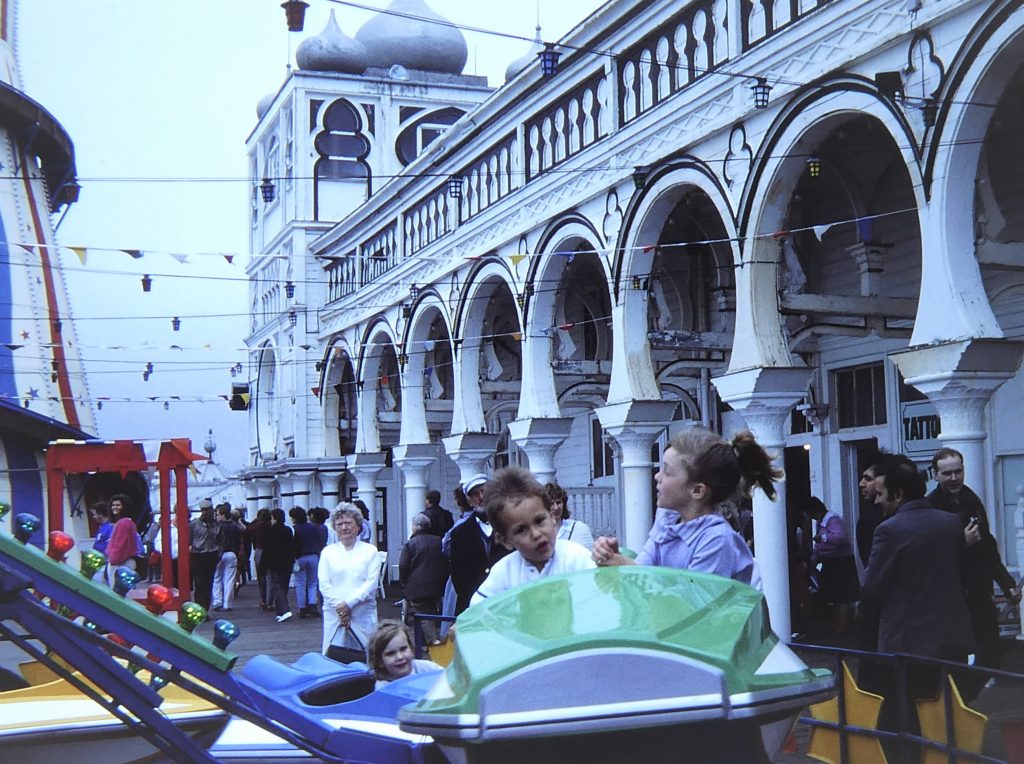 It was a longish walk into town, along the highest layer of the three-layer waterfront. Most of the the tourist facilities were quiet. With the sun peeping through in the afternoon, we spied one hardy soul sunbathing on the stony beach. We
It was a longish walk into town, along the highest layer of the three-layer waterfront. Most of the the tourist facilities were quiet. With the sun peeping through in the afternoon, we spied one hardy soul sunbathing on the stony beach. We 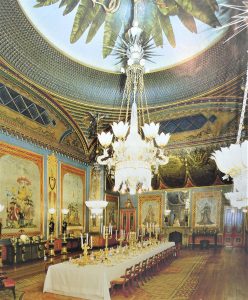 visited the Royal Pavilion, an amazing Regency extravaganza, with a Nash Indian-inspired exterior. e were busy during our short stay there, with its various conveniences allowing a good clean-up of the boat and dinghies, fuelled up, laundry ashore and showers on the marina. We took time to go round a 1944 destroyer, HNS Cavalier, identical to the Battle-class destroyer I spent a few cold days on in mid-winter as a school Naval cadet. We also walked out the length of the Palace Pier, in all its decaying glory. Very quiet, apart from a few punks and bad ice-cream stalls. The old part of Brighton was surprisingly attractive, with jewellers and boutique shops in narrow streets, and there was a good museum with an excellent Brighton collection. In Kemptown serious efforts were being made to reinvigorate the splendour of Nash's architecture.
visited the Royal Pavilion, an amazing Regency extravaganza, with a Nash Indian-inspired exterior. e were busy during our short stay there, with its various conveniences allowing a good clean-up of the boat and dinghies, fuelled up, laundry ashore and showers on the marina. We took time to go round a 1944 destroyer, HNS Cavalier, identical to the Battle-class destroyer I spent a few cold days on in mid-winter as a school Naval cadet. We also walked out the length of the Palace Pier, in all its decaying glory. Very quiet, apart from a few punks and bad ice-cream stalls. The old part of Brighton was surprisingly attractive, with jewellers and boutique shops in narrow streets, and there was a good museum with an excellent Brighton collection. In Kemptown serious efforts were being made to reinvigorate the splendour of Nash's architecture.
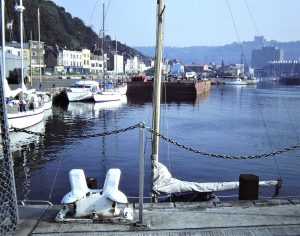 After a couple of nights we were off again, and in the afternoon had a great sail round Beachy Head and Dungeness to Dover, arriving near midnight. We anchored in the main outer harbour, rolling in the swell, and first thing in the morning made our way through an opening bridge into the Wellington Dock and tied alongside an
After a couple of nights we were off again, and in the afternoon had a great sail round Beachy Head and Dungeness to Dover, arriving near midnight. We anchored in the main outer harbour, rolling in the swell, and first thing in the morning made our way through an opening bridge into the Wellington Dock and tied alongside an 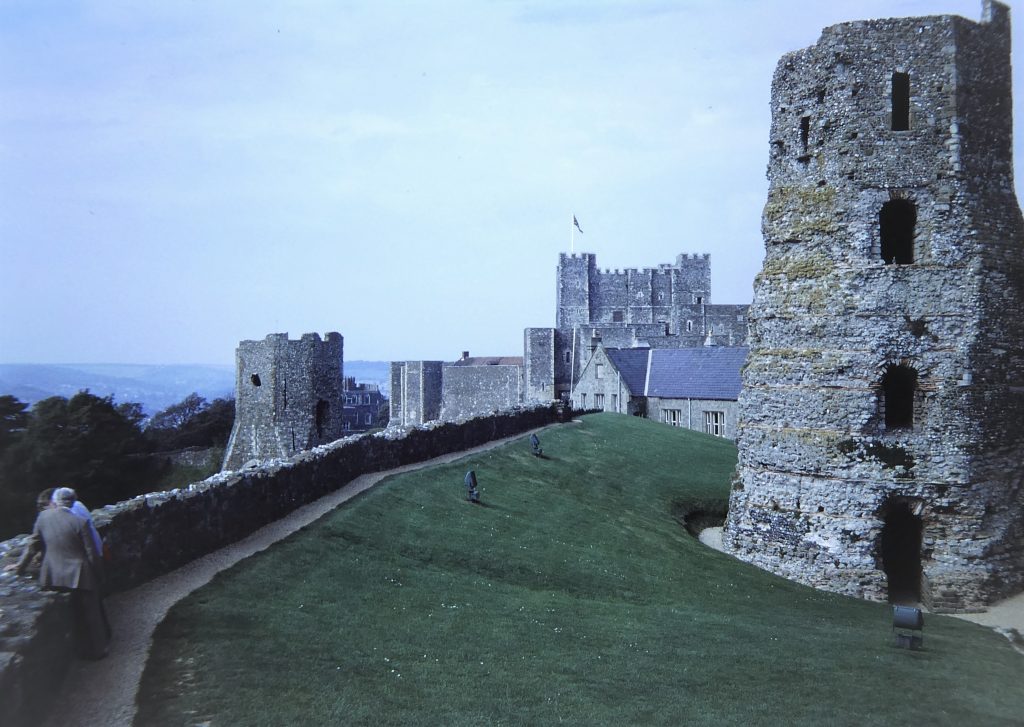 unoccupied motorboat. We took a great but quite difficult walk up to Dover Castle, with a history of the site going back to William the Conqueror. It was an immense complex of fortifications and dwellings, a solid keep, a Saxon church extraordinary mosaic decorations with the remains of a Roman lighthouse adjacent. Later, we visited the excavated remains of a Roman villa in the town. We helped a couple of blokes get their boat craned out of the water, and went with them to the accommodating and welcoming Royal Cinq Ports Yacht Club - a bit different from the Solent clubs.
unoccupied motorboat. We took a great but quite difficult walk up to Dover Castle, with a history of the site going back to William the Conqueror. It was an immense complex of fortifications and dwellings, a solid keep, a Saxon church extraordinary mosaic decorations with the remains of a Roman lighthouse adjacent. Later, we visited the excavated remains of a Roman villa in the town. We helped a couple of blokes get their boat craned out of the water, and went with them to the accommodating and welcoming Royal Cinq Ports Yacht Club - a bit different from the Solent clubs.
We were escorted out of the docks by a Harbour Patrol launch, avoided the busy shipping as we left the harbour, and motored round South Foreland in sloppy tidal waters. Every movement in the Channel is influenced by the tide, and we would need the flood to enter and go up the Thames. We decided to stop and anchor just to the west of the ruined Margate pier, seemingly a long way out from the shore because of the considerable tidal range. After a rather rolly night we woke to thick fog, with visibility down to about 100 metres. Thames Coastguard was reporting visibility down to three metres!
In the early afternoon it seemed to clear a bit, and we motored out into the Gore Channel, along the coast between the extensive sandbanks of the Margate Hook and the Kent mainland. But after an hour it clamped down again, so we eased inshore and re-anchored once more in the apparent middle of nowhere. We were in as shallow waters as we dared, but had to blast a catamaran a warning as it barrelled down upon us out of the murk.
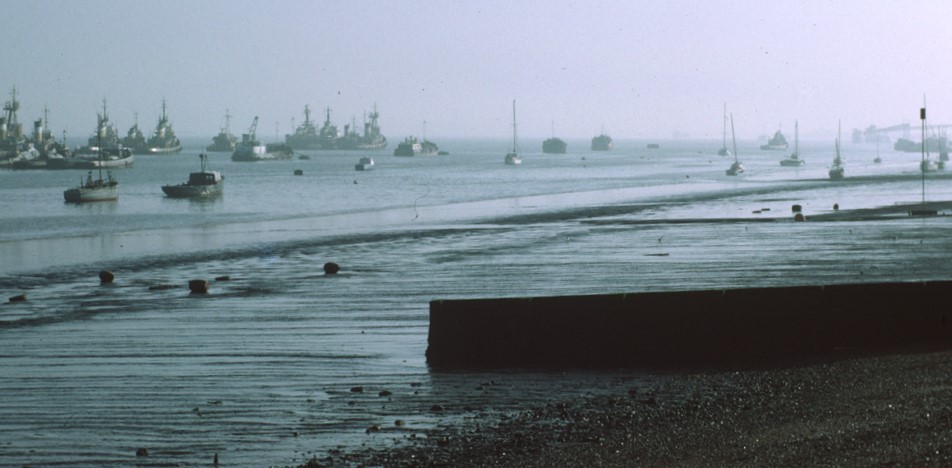 Dense fog early the next day too, but it cleared enough by mid-morning to get going. There was supposed to be an anchorage in the Yantlet Flats, generally opposite Southend on the southern side of the Thames Estuary, but it looked very open and uninviting, so we pressed on to Gravesend Reach, in the outer reaches of the Thames River. After slugging against the ebbing tide we anchored there in the late afternoon among moored tugs and powered barges. But it was a surprisingly calm night.
Dense fog early the next day too, but it cleared enough by mid-morning to get going. There was supposed to be an anchorage in the Yantlet Flats, generally opposite Southend on the southern side of the Thames Estuary, but it looked very open and uninviting, so we pressed on to Gravesend Reach, in the outer reaches of the Thames River. After slugging against the ebbing tide we anchored there in the late afternoon among moored tugs and powered barges. But it was a surprisingly calm night.
We took the dinghy ashore across the mud flats and walked up to Gravesend, very quiet, and called into the Gravesend Sailing Club. It was Sunday, and we got a great welcome from the members there as "real sailors". We thought they were true sailors, also. They wanted us to stay for the evening and give a talk to the members, but we had to get back to the boat while we could still get the dinghy over the mud, and tomorrow we were aiming to move early.
 It was a little misty to start with when we left to go upriver, but it cleared to a nice day as we started to motor up the River Thames, quite an adventure. It was wide in these lower reaches, mud banks in front of some docks, many looking decayed, some being revitalised. We passed lots of barges, a few ships, and a few tourist launches.
It was a little misty to start with when we left to go upriver, but it cleared to a nice day as we started to motor up the River Thames, quite an adventure. It was wide in these lower reaches, mud banks in front of some docks, many looking decayed, some being revitalised. We passed lots of barges, a few ships, and a few tourist launches.
The extraordinary Thames Tidal Barrier, on the approach to Greenwich, was a sight to see and a bit intimidating to pass through. It is retractable barrier system that was designed to prevent the floodplain of most of Greater London from being flooded by exceptionally high tides and storm surges moving up from the North Sea. It only became operational 1982, so in historical terms we were among the earliest yachts to pass through. We then wound our way round the curves of the river past the Greenwich Old Naval College and museum, the Isle of Dogs and Wapping, and finally came to see the Tower Bridge and the Tower of London. They were to be our neighbours for six months, as we were to spend the winter in London at the adjacent St Katharine's Dock (or Yacht Haven, as it preferred to be called).
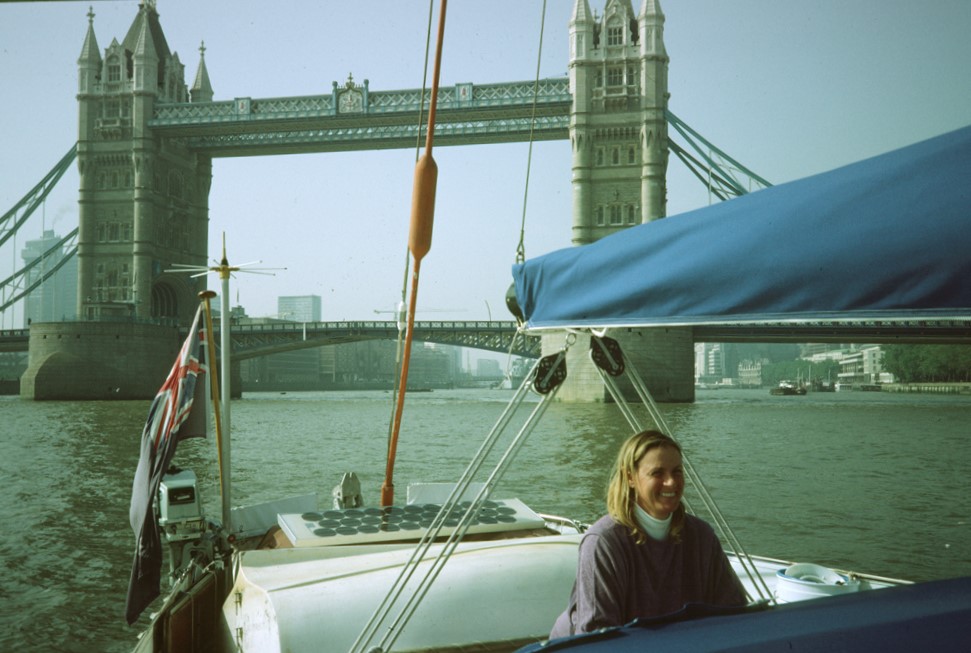
We milled around in the river for a while and topped up with fuel at a floating wharf, waiting for the tide to allow opening of the lock gates and our entry to the marina.
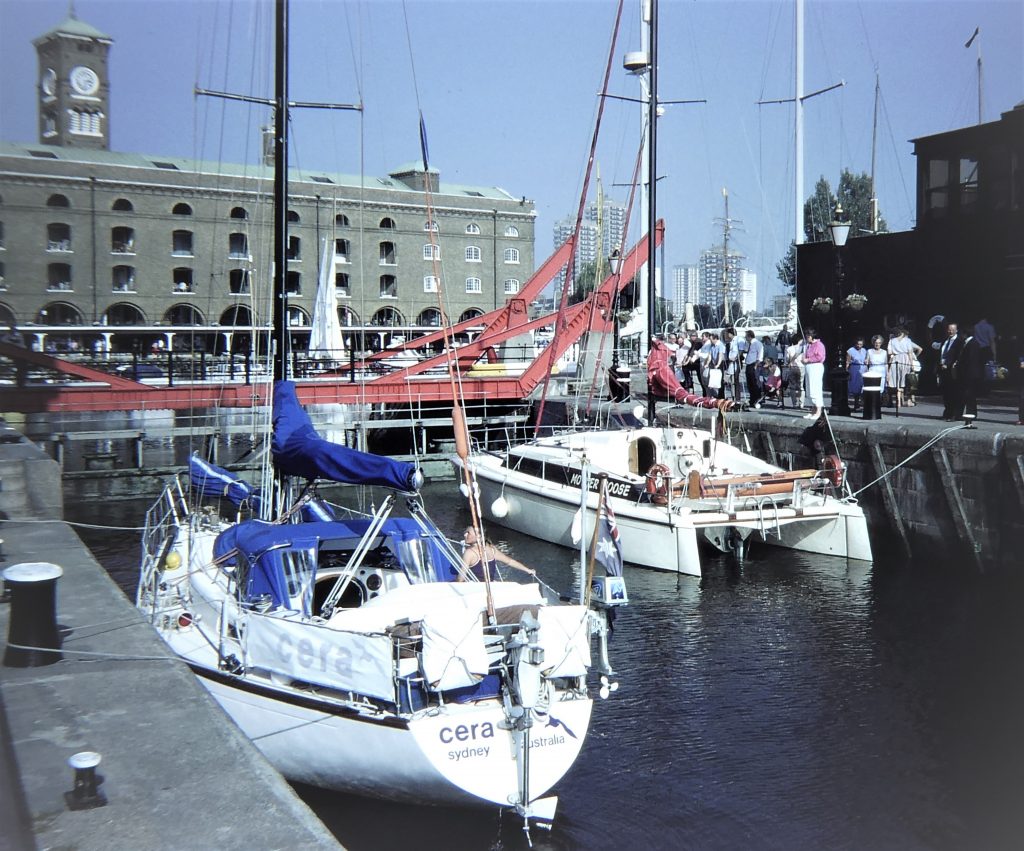
Locking into St Katharine's Dock
We were assigned to what we hoped would be a temporary berth, because it was on the shady north side of a big building and we would never see the sun in the winter. After checking in with the manager, we were given a much better position in the eastern basin of the complex where, we were to find, the handful of live-aboard yachts were placed. As it happens, when we were checking in - having pre-booked our six months - the manager asked, "you're not going to live aboard, are you?" "Er, we do anticipate spending some extended periods visiting London", we replied. That seemed to be an acceptable position.
Turned out that the local council was dead against people living aboard there, and thus avoiding paying the council rates. But we were sufficiently transient to avoid any real problem, and we were never hassled about it.
We walked up to Wapping to find some shops, and appreciated the extensive rehabilitation of the area and, of course, the entire docklands.
Our winter in St Katharine's Dock, London
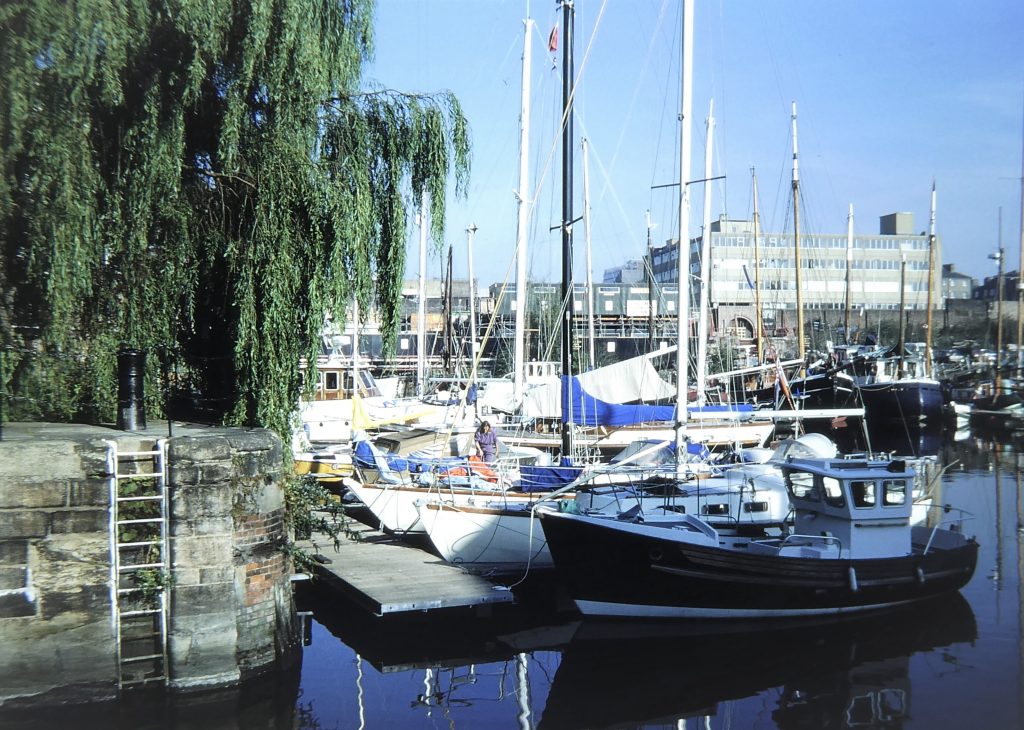 St Katharine’s was a lovely spot, and very convenient for all that London had to offer.
St Katharine’s was a lovely spot, and very convenient for all that London had to offer.
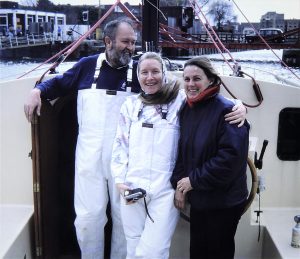 A few other boats in this eastern basin were being lived aboard, mostly by Brits using their craft as temporary residences. We became special friends with the owners of the catamaran with which we had entered the docks, Don and Gillian Pinn. We were to become life-long correspondents with them after we had gone our different ways and were able to visit them occasionally on trips from Australia.
A few other boats in this eastern basin were being lived aboard, mostly by Brits using their craft as temporary residences. We became special friends with the owners of the catamaran with which we had entered the docks, Don and Gillian Pinn. We were to become life-long correspondents with them after we had gone our different ways and were able to visit them occasionally on trips from Australia.
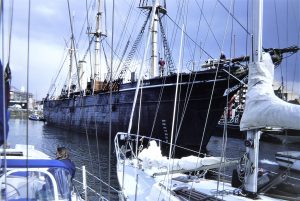
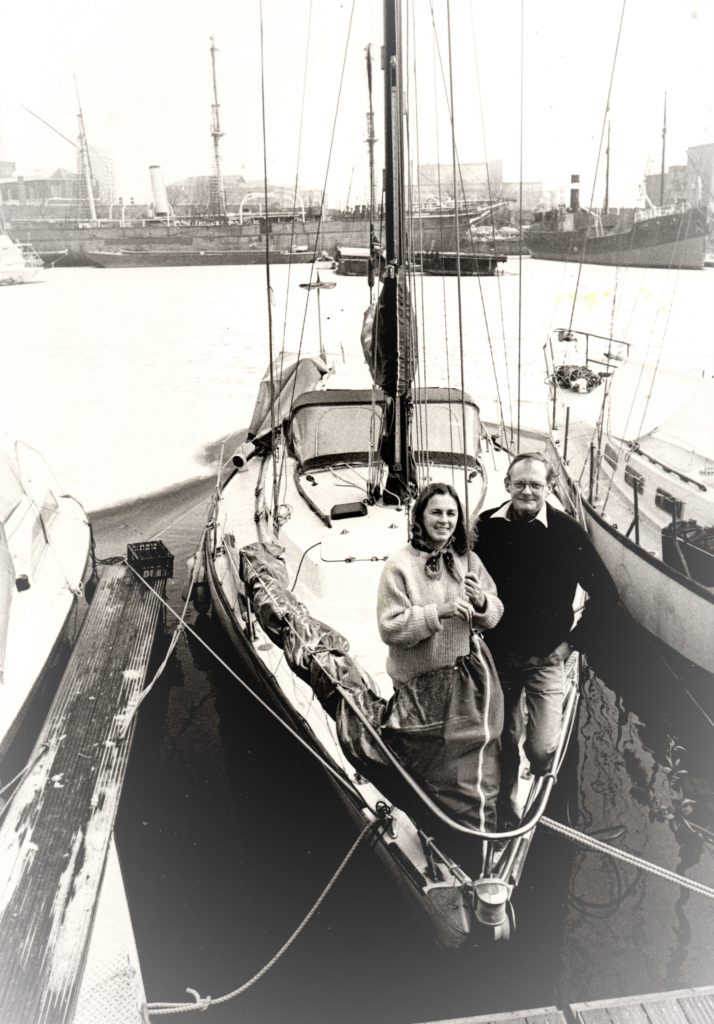 There were a few working craft too. And right near us was a splendid barque-rigged auxiliary steamship, the Royal Research Ship Discovery. She was built for Antarctic research, and launched in 1901. She was the last traditional wooden three-masted ship to be built in the United Kingdom. Her first mission was the British National Antarctic Expedition, carrying Robert Falcon Scott and Ernest Shackleton on their first, and highly successful, journey to the Antarctic, known as the Discovery Expedition.
There were a few working craft too. And right near us was a splendid barque-rigged auxiliary steamship, the Royal Research Ship Discovery. She was built for Antarctic research, and launched in 1901. She was the last traditional wooden three-masted ship to be built in the United Kingdom. Her first mission was the British National Antarctic Expedition, carrying Robert Falcon Scott and Ernest Shackleton on their first, and highly successful, journey to the Antarctic, known as the Discovery Expedition.
At least until Christmas, a period of acceptable winter weather, we were good tourists, doing all the sights of London. Public transport, mostly by the Underground and occasionally by bus, was cheap, and the Tower Hill tube station was an easy walk from the dock.
We absolutely wallowed in music, for which London is one of the world’s greatest cities. We went to some kind of concert nearly every other day, and sometimes two a day, until it got too cold after Christmas. This was not as expensive as it sounds, as not only were seats at even the grander venues far less expensive than anywhere else we’d been, but also there are scores of churches, halls and the like - particularly in and around the City of London, near by us - which lay on regular concerts of top quality at very small cost, or free. And for plays, there were matinees and standbys which suited our relaxed time constraints.
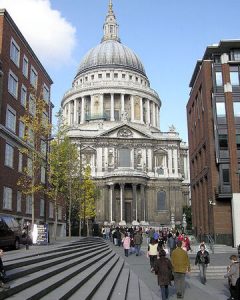
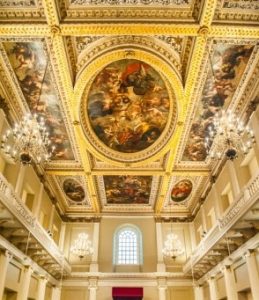 Among many examples, our first major concert was of choral music by the early English composer Tallis, with a big choir (the Tallis Scholars), the program including the amazing Spem in Alium, a 40 part piece needing a score the size of a newspaper. We then went to a pair of masques, a peculiarly English form of entertainment, written and played originally for Charles I at huge expense at just the time when Cromwell was upsetting the natives with talk of regal extravagance. Having booked early we sat in the front row about where Charles would have sat, in the very building where the performances were put on for him, Banqueting House in Whitehall, with a ceiling painted by Rubens also in fulsome praise of his king. Charles even walked to his death on the scaffold through one of the windows near which we sat. In early December we attended the Messiah in St Paul's Cathedral; we were too late for seats, but were apologetically assigned a fantastic standing position by a column right at the front of the audience.
Among many examples, our first major concert was of choral music by the early English composer Tallis, with a big choir (the Tallis Scholars), the program including the amazing Spem in Alium, a 40 part piece needing a score the size of a newspaper. We then went to a pair of masques, a peculiarly English form of entertainment, written and played originally for Charles I at huge expense at just the time when Cromwell was upsetting the natives with talk of regal extravagance. Having booked early we sat in the front row about where Charles would have sat, in the very building where the performances were put on for him, Banqueting House in Whitehall, with a ceiling painted by Rubens also in fulsome praise of his king. Charles even walked to his death on the scaffold through one of the windows near which we sat. In early December we attended the Messiah in St Paul's Cathedral; we were too late for seats, but were apologetically assigned a fantastic standing position by a column right at the front of the audience.
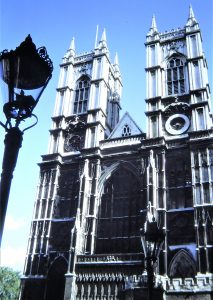
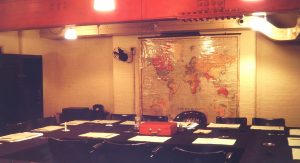
 We also used our folding Peugeot bicycles extensively in London, for visits including Westminster Abbey, Churchill's War Rooms and many others. I also used the bike to make regular visits to the offices of the British Medical Association, in Tavistock Square. Through its Secretary General - with whom I had got friendly in my international road safety conference days - I was commissioned for some consultancy work, including researching and writing monographs on subjects as varied as the then-feared nuclear winter, alcohol use by young people, and alternative therapies.
We also used our folding Peugeot bicycles extensively in London, for visits including Westminster Abbey, Churchill's War Rooms and many others. I also used the bike to make regular visits to the offices of the British Medical Association, in Tavistock Square. Through its Secretary General - with whom I had got friendly in my international road safety conference days - I was commissioned for some consultancy work, including researching and writing monographs on subjects as varied as the then-feared nuclear winter, alcohol use by young people, and alternative therapies.
In various forms of transport we toured much of the British Isles, as postcard-pretty as ever, even in winter. For a week, in the depths of winter, we went up to Scotland, to stay in the Highlands with the Scottish side of the family.
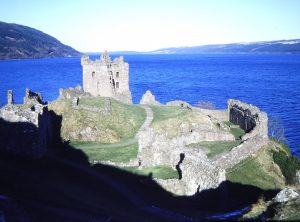
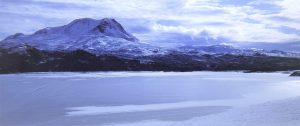 The weather, paradoxically, was glorious – clear blue skies and no wind, although freezing cold of course. Many of the lochs were frozen over. The ski fields were busy. We covered a huge mileage on the roads, particularly up and down the west coast, where I have not been since childhood.
The weather, paradoxically, was glorious – clear blue skies and no wind, although freezing cold of course. Many of the lochs were frozen over. The ski fields were busy. We covered a huge mileage on the roads, particularly up and down the west coast, where I have not been since childhood.
During our time at St Katharine's we had lots of visits to the boat by friends and relations, including its designer, Professor Peter Joubert. Never one to waste words, he wrote in the visitors' book: "The yacht is in great condition". He was in fact very proud of our voyaging in a vessel of his design, and we were very glad we had commissioned and built such a great (and pretty) yacht. We caught up again with our lifelong friends David and Pat Amies, with whom we went back to our days as doctors in the RAF in the 'sixties.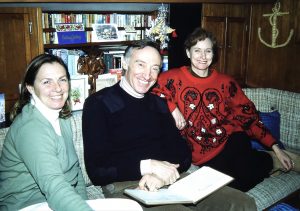
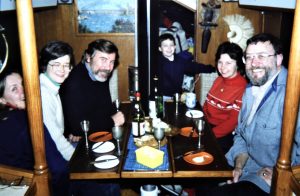 We were also visited several times by two couples who had become among our best cruising friends: Clydie, John and son Ian Connolly (all the way back to Hawaii and in many places since, currently buying a new British boat in the Solent); and George and Teresa Coburn, with whom we had sailed across the North Atlantic and were by this time wintering on the English south coast.
We were also visited several times by two couples who had become among our best cruising friends: Clydie, John and son Ian Connolly (all the way back to Hawaii and in many places since, currently buying a new British boat in the Solent); and George and Teresa Coburn, with whom we had sailed across the North Atlantic and were by this time wintering on the English south coast.
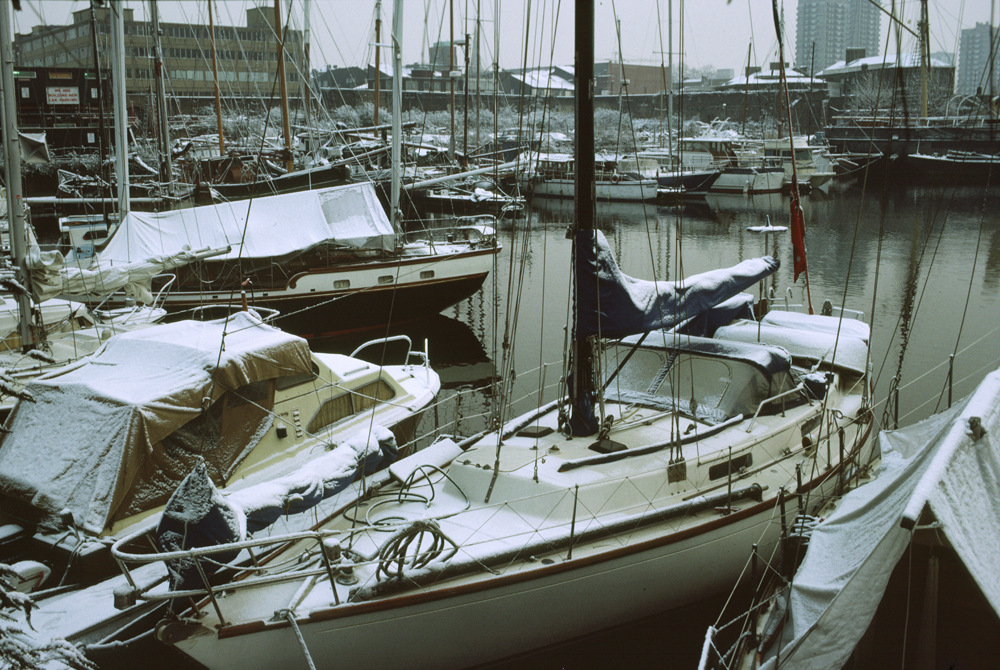
But 1985-1986 was clearly to be our only winter in the boat in northern Europe! It was the coldest February for 200 years, and we were iced in solid for several weeks. Ducks were walking on the ice round the boat, which we kept warm with borrowed electric heaters. It was reported that the winter was so cold that 70 per cent of Britain's beehives were wiped out.
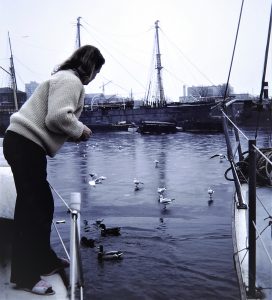 The building adjacent to the berth where we were lying housed the premises of the Cruising Association, which was formed by British cruising sailors in 1908. It is famed for holding an outstanding collection of nautical literature in its library, including charts of the entire world. We had arranged access to the premises, their showers, their library and comfortable sitting room. One afternoon, while I was working on the boat, Norma came down from there and said, "come up quick". The CA did depend on donations of officially out-of-date charts to maintain its collection, and it appeared that a massive collection of charts had just been left there by a ship. They were not required by the CA, and we were welcome to any we chose. Thus, in a few hours of sorting, we obtained for free pretty well all the charts we would require for the rest of our voyaging, something that we'd been worrying about.
The building adjacent to the berth where we were lying housed the premises of the Cruising Association, which was formed by British cruising sailors in 1908. It is famed for holding an outstanding collection of nautical literature in its library, including charts of the entire world. We had arranged access to the premises, their showers, their library and comfortable sitting room. One afternoon, while I was working on the boat, Norma came down from there and said, "come up quick". The CA did depend on donations of officially out-of-date charts to maintain its collection, and it appeared that a massive collection of charts had just been left there by a ship. They were not required by the CA, and we were welcome to any we chose. Thus, in a few hours of sorting, we obtained for free pretty well all the charts we would require for the rest of our voyaging, something that we'd been worrying about.
We were supposed to be out of St Katharine's by March 31 1986, but that day it was blowing 35-45 knots in the Channel, the temperature was about 5 degrees and near-freezing at night, and we were experiencing flurries of sleet. We arranged to stay for another couple of weeks, during which we finalised a lot of the boat jobs that had been ongoing over the winter, ticked off another few tourist visits, and went down to say farewell to Mum for a while.
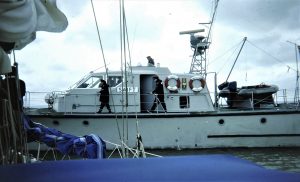 But we had to get going, despite the TV weatherman telling us that we were experiencing "the most severe beginning to April since records began"! On the foul wet morning of Tuesday 15 April we locked out of the old docks into sleet driven by a Force 5-6 southerly. After four hours or so the motor started fluctuating and then stopped altogether. Under mainsail alone we sailed into the estuary of the River Medway between the Isle of Grain and Sheerness, where the Thames turns from a river into an estuary. We turned down Stangate Creek and anchored in Sharfleet Creek, surrounded by bleak marsh and mud flats. We were immediately attended by the river police, simply checking our status. I changed the fuel filter and bled the injectors, in the assumption that some blockage had become established during our long stay in the docks.
But we had to get going, despite the TV weatherman telling us that we were experiencing "the most severe beginning to April since records began"! On the foul wet morning of Tuesday 15 April we locked out of the old docks into sleet driven by a Force 5-6 southerly. After four hours or so the motor started fluctuating and then stopped altogether. Under mainsail alone we sailed into the estuary of the River Medway between the Isle of Grain and Sheerness, where the Thames turns from a river into an estuary. We turned down Stangate Creek and anchored in Sharfleet Creek, surrounded by bleak marsh and mud flats. We were immediately attended by the river police, simply checking our status. I changed the fuel filter and bled the injectors, in the assumption that some blockage had become established during our long stay in the docks.
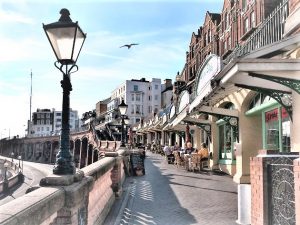 We waited for the depression to move through and sailed out through the Thames estuary and around North Foreland to Ramsgate Harbour. We tied up on a visitors' jetty just inside the southern breakwater and took a walk into what was a very attractive little town, with good shops and very friendly local people. We were almost immediately invited out for dinner the next evening! In very cool conditions with a Force 8 gale outside, we tied to the inner side of the breakwater wall, which gave us some protection. We stayed there for long enough to dry out and apply a coat of sticky copper-based antifouling paint. We then moved into the more sheltered inner harbour and in slightly improving conditions started airing and drying out the boat. Condensation had been a constant challenge all winter. We received more invitations from a succession of very friendly locals, and we had a great party on the boat with them and a few from other overseas cruising yachts in the harbour. We did find Ramsgate to be the most attractive place for the boat we visited on the entire south coast.
We waited for the depression to move through and sailed out through the Thames estuary and around North Foreland to Ramsgate Harbour. We tied up on a visitors' jetty just inside the southern breakwater and took a walk into what was a very attractive little town, with good shops and very friendly local people. We were almost immediately invited out for dinner the next evening! In very cool conditions with a Force 8 gale outside, we tied to the inner side of the breakwater wall, which gave us some protection. We stayed there for long enough to dry out and apply a coat of sticky copper-based antifouling paint. We then moved into the more sheltered inner harbour and in slightly improving conditions started airing and drying out the boat. Condensation had been a constant challenge all winter. We received more invitations from a succession of very friendly locals, and we had a great party on the boat with them and a few from other overseas cruising yachts in the harbour. We did find Ramsgate to be the most attractive place for the boat we visited on the entire south coast.
 On May 1 we left rather reluctantly after a good time there, and motored off confidently, leading a German boat whose skipper was (rightly) worried about the many sandbanks along the Kentish coast. We assured him that we had good enough local charts to get us through with no problems. But when I switched to the new Navico automatic wheel pilot (replacing the old Shipmate model that had given some trouble in the Atlantic crossing) the boat suddenly made a U-turn! Sorted that problem out (its compass had been set 180 degrees out!) and pressed on south down the shallow Ramsgate Channel through the sandbanks to Deal, then round the Forelands and past the white cliffs of Dover. The engine was again speeding up, then stopping and needing a bleed. We decided to make an overnight stop at Brighton Marina instead of pressing on to the Solent and arriving in the dark with a dicky motor.
On May 1 we left rather reluctantly after a good time there, and motored off confidently, leading a German boat whose skipper was (rightly) worried about the many sandbanks along the Kentish coast. We assured him that we had good enough local charts to get us through with no problems. But when I switched to the new Navico automatic wheel pilot (replacing the old Shipmate model that had given some trouble in the Atlantic crossing) the boat suddenly made a U-turn! Sorted that problem out (its compass had been set 180 degrees out!) and pressed on south down the shallow Ramsgate Channel through the sandbanks to Deal, then round the Forelands and past the white cliffs of Dover. The engine was again speeding up, then stopping and needing a bleed. We decided to make an overnight stop at Brighton Marina instead of pressing on to the Solent and arriving in the dark with a dicky motor.
The problem sailing west down-Channel is that you can’t win. The prevailing wind is sou-west. So, if you do the ungentlemanly thing and beat to windward, you still have to have a favourable tide, otherwise you don’t get anywhere in these waters. This means that the tide is against the wind and the seas will be horrible. So, we spent a lot of time in various ports waiting for easterlies, which are very rare at that time of the year and, moreover, bring fog.
Completely consistent with the above observations, when we sailed out of Brighton the next day we had a fair wind from the east but the visibility was awful. We saw the marker off Selsey Bill just in time to avoid it, but passed the wrong side. While  approaching the Solent and then aiming for Southampton Water we could not see any land or landmarks to navigate by. There is however a forest of buoys and channel markers in the Solent, all numbered or named and identifiable through the chart. This is the way we navigated our way, trying to keep to the edge of the shipping channels. At one time I reassured Norma, “at least we’re out of the shipping channel”, when out of the fog loomed an unexpected buoy which showed we’d just been swept right across the channel by the tidal stream. Sailing in the Solent in poor visibility was a challenge! With some relief we sailed up the River Hamble from Southampton Water and tied between visitors' pilings opposite the Port Hamble Marina, one of many.
approaching the Solent and then aiming for Southampton Water we could not see any land or landmarks to navigate by. There is however a forest of buoys and channel markers in the Solent, all numbered or named and identifiable through the chart. This is the way we navigated our way, trying to keep to the edge of the shipping channels. At one time I reassured Norma, “at least we’re out of the shipping channel”, when out of the fog loomed an unexpected buoy which showed we’d just been swept right across the channel by the tidal stream. Sailing in the Solent in poor visibility was a challenge! With some relief we sailed up the River Hamble from Southampton Water and tied between visitors' pilings opposite the Port Hamble Marina, one of many.
We rented a Fiesta and did some local touring, including Portsmouth Harbour and the exhibition of the restoration of Henry VIII's Mary Rose warship, and to Winchester Cathedral. We then took the car over to Woking and to Selsey, said farewells to the parents. Making the most of the car we visited several chandleries and manufacturers, and obtained a lot of new parts and stuff for the boat. We fitted a new, stronger shaft for the Hydrovane self-steering, replacing the one we had bent mid-Atlantic. By coincidence we again came across Peter Blake. During the time we had spent in Britain he had sailed right around the world yet again, coming second in the Whitbread race.
Despite the weather, with gales, rain and the cold, this couple of weeks in the Hamble had been highly productive in terms of getting the boat - and us - ready for long-distance sea-going again. The next step was to take a single day sailing out of the Solent and along to Weymouth Harbour. As we approached, in the turbulent water inevitable anywhere near Portland Bill, the brand new and supposedly unbreakable Navico autopilot stripped its gears trying to keep course. Remembering the company's CEO assurance that this new equipment would take us round the world, I rang him in a fury and left the parts with a friendly chandlery to ship up to the factory for replacement.
We left Weymouth, and Britain, on June 2 1986, returning to foreign shores, in this case a day sail in light winds across the Channel to Cherbourg, France.
The Channel Islands and Brittany
The southwards crossing of the Channel was uneventful by Channel standards: generally overcast, some drizzle, light winds, cross-course tidal stream about two knots, visibility about three miles with foggy patches. Ships in their defined channels have right of way, and if yachts obstruct them they get told off by the Channel control centre. Crossing the shipping channels therefore feels a bit like walking across a motorway.
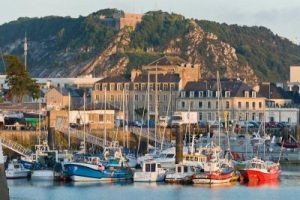 Cherbourg is an immense commercial harbour with an enormous and very expensive marina. The city was of course the major supply port for the D-Day invasion, once it was liberated. It is not a particularly attractive place, but it did have a nicely restored old part of town and it was great to feel “foreign” again. We revelled in the food shops. Norma is not the sort often to be overwhelmed by the choice of foodstuffs in a supermarket, but this did happen here, for the first time since Honolulu! We were getting rather punch-drunk about marina costs by this time, so only stayed long enough to stock up on marvellous French food and duty-free booze. We had a look around the town and the fort that overlooks it, with a museum and information about the Normandy landings.
Cherbourg is an immense commercial harbour with an enormous and very expensive marina. The city was of course the major supply port for the D-Day invasion, once it was liberated. It is not a particularly attractive place, but it did have a nicely restored old part of town and it was great to feel “foreign” again. We revelled in the food shops. Norma is not the sort often to be overwhelmed by the choice of foodstuffs in a supermarket, but this did happen here, for the first time since Honolulu! We were getting rather punch-drunk about marina costs by this time, so only stayed long enough to stock up on marvellous French food and duty-free booze. We had a look around the town and the fort that overlooks it, with a museum and information about the Normandy landings.
From Cherbourg we sailed for the Channel Islands. We had not originally intended to visit these islands, being in a bit of a rush to get south. But we changed our minds, and they turned out to be attractive and interesting. However, they do offer substantial challenges for the yacht and the navigator.
The first island to visit was Alderney, off the north-west tip of the Normandy peninsula, and nearly due west of Cherbourg. To get there we had to cross the Race (Raz) of Alderney, notorious for its rips and rough seas driven by fast tidal streams and unpredictable headland winds. We had to tack directly to windward to get there, but it's not far, taking about four hours, and the trip was mostly not as rough as we had expected.
The Channel Islands are not part of the United Kingdom but do have self-governing status, recognising the Queen as Head of State in her capacity as Duke of Normandy. The liberal tax laws make them a tax haven for the British, and a lot of money floats around, reminiscent (as in other ways) of Bermuda.
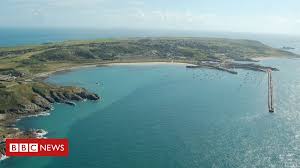 We picked up a public mooring in the wide expanse of Alderney Harbour, which looked a lot better on the chart than in practice. [Note: the 35mm slide photos taken during this period of our voyaging we never saw again after sending them for processing. Considering our movements and the varying international mailing involved, it is fortunate that we only lost a few while we were away. For this account, we have chosen for illustration a few stock photos from Google images.]
We picked up a public mooring in the wide expanse of Alderney Harbour, which looked a lot better on the chart than in practice. [Note: the 35mm slide photos taken during this period of our voyaging we never saw again after sending them for processing. Considering our movements and the varying international mailing involved, it is fortunate that we only lost a few while we were away. For this account, we have chosen for illustration a few stock photos from Google images.]
The harbour was originally a large open bay, which was converted into a harbour by the Royal Navy in the 19th century for its ships. The bay was in the first stage protected by a massive, straight, kilometre-long, breakwater, which is still there. A second breakwater to complete the enclosure was never built, because the Napoleonic Wars came to an end, so the harbour is open to the Channel to the north-east. Even in calm weather the yacht was rolling uncomfortably in the swell, even though we were moored as near to the wall as possible.
 We walked ashore in pleasant weather up to the island's centre and its main town, St Anne, and toured its interesting museum. We took a little train to the island's north-east corner. There are several Victorian fortresses all around the island. There are also many immense German fortifications, part of Germany's western defences. It's a very pretty island, with masses of wild flowers, green fields and contented cows.
We walked ashore in pleasant weather up to the island's centre and its main town, St Anne, and toured its interesting museum. We took a little train to the island's north-east corner. There are several Victorian fortresses all around the island. There are also many immense German fortifications, part of Germany's western defences. It's a very pretty island, with masses of wild flowers, green fields and contented cows.
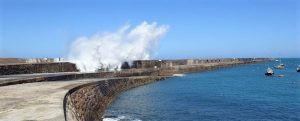 Sure enough, within a few days the wind picked up to gale force, the boat rolling badly and with seas breaking over the forbidding harbour wall. As soon as possible we pulled out into foul weather but with less wind, and it was clearing by mid-day.
Sure enough, within a few days the wind picked up to gale force, the boat rolling badly and with seas breaking over the forbidding harbour wall. As soon as possible we pulled out into foul weather but with less wind, and it was clearing by mid-day.
We sailed down to the island of Guernsey and picked up a mooring in the outer part of the harbour of St Peter Port. The inner marina was only accessible at high tide over a sill that was exposed when the tide went down. The harbour is a very popular destination for British sailors, and it was crammed. Visitors like us were faced by the Great European Raft-up, with lots of boats on each mooring. The tides, which govern every movement, don’t stick to working hours so boats were coming and going all night, with much banging, shouting and untangling of lines.
 We had to stay for a few days because I needed to take a ferry trip back to England to check on my mother and to discuss her status with her doctor. Fortunately we were intending to spend quite some time in Europe before sailing off over the horizon back to Australia. After a few days getting her settled and her affairs in good order, it was relaxing to get back to the boat.
We had to stay for a few days because I needed to take a ferry trip back to England to check on my mother and to discuss her status with her doctor. Fortunately we were intending to spend quite some time in Europe before sailing off over the horizon back to Australia. After a few days getting her settled and her affairs in good order, it was relaxing to get back to the boat.
Guernsey was another pretty little island. St Peter Port had a good museum, and all around the place there were several forts and fortifications to be seen. The countryside was just like that of Alderney: flowers and greenery, narrow winding roads. Castle Cornet sits prominently on the southern harbour breakwater, with another museum describing its long history of wars and occupations. In the town there was a splendid market, with many stallholders dressed in period costumes. Incredibly cheaply we rented a Fiesta for the day and took it round all the island's shores and yet more forts and German blockhouses.
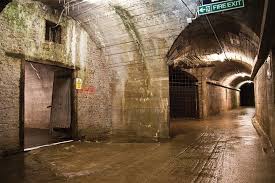 The islands were occupied by the Germans during WW2. We visited the quite extraordinary remains of and underground hospital, with miles (it seemed that way) of tunnels carved out of the granite by slave labour, once packed with beds, now cold, dank, and haunted by the ghosts of the injured. Wounded German soldiers were shipped there from the mainland, especially after the invasion.
The islands were occupied by the Germans during WW2. We visited the quite extraordinary remains of and underground hospital, with miles (it seemed that way) of tunnels carved out of the granite by slave labour, once packed with beds, now cold, dank, and haunted by the ghosts of the injured. Wounded German soldiers were shipped there from the mainland, especially after the invasion.
After we had let a thunderstorm pass, we set sail again southwards towards the northern coast of Brittany. We had done a fair bit of planning for this leg of the trip, because of strong tidal streams and the shallow waters, rocks and islets to be avoided on the final approach. But we were optimistic that the pleasant weather in which we left St Peter Port would hold for the day, and the forecast was good. All the sailing guides warned against approaching the Brittany coast in conditions of poor visibility, and we took these warnings seriously.
But in vain. Sure enough, half way there the fog clamped down, it was flat calm, and the satellite navigator went into one of its blank periods (several hours between fixes - no GPS then). It would have been just as risky to go back. Frankly, I’ve never felt so lost and vulnerable. The cross-track component of the tidal stream was anything between four and six knots, trying to take us at least 20 degrees off our intended course. We were heading for a ferocious coast, armed with millions of black and spiky rocks, aiming for a marker buoy with a warning whistle that would indicate the path through the rocks. We had to stop the motor from time to time to try to hear the buoy's warning sound, which meant that we were being sent sideways when we stopped.
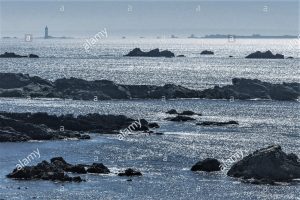
Just as I was deciding to anchor miles off the coast and wait for better visibility, Norma’s eagle eyes spotted a lighthouse and a north cardinal buoy about two miles east of where we hoped we were, showing that we'd been swept down by the tidal stream. We were just able to motor against the tide back to to the red channel-marker buoy we had been looking for, and found it 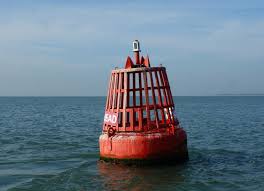 silent; in the oily calm the buoy was not being moved enough to squish the bellows that produced the whistle. This buoy was the one that marked the entrance to the Treguier river and through the multitude of rocks on the approach.
silent; in the oily calm the buoy was not being moved enough to squish the bellows that produced the whistle. This buoy was the one that marked the entrance to the Treguier river and through the multitude of rocks on the approach.
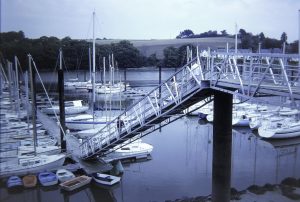 With the rising tide and in clearing weather we then wound our way up the river to the enchanting Breton town of Treguier and tied up at the marina. The log records: "A worrying little passage at times!" But by then we were enjoying "blessed peace and quiet!", as I wrote at the time.
With the rising tide and in clearing weather we then wound our way up the river to the enchanting Breton town of Treguier and tied up at the marina. The log records: "A worrying little passage at times!" But by then we were enjoying "blessed peace and quiet!", as I wrote at the time.
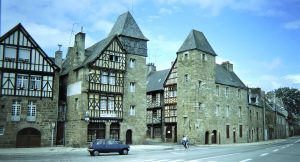 After lunch the following day we walked around the lovely little episcopal city, with a well-
After lunch the following day we walked around the lovely little episcopal city, with a well- preserved centre and a beautiful Breton Gothic/romanesque cathedral. The stone walls held bowls of flowers, timber-framed houses lined narrow streets up the hillside. On market day we shopped for piles of marvellous provisions and lay in the sun after lunch.
preserved centre and a beautiful Breton Gothic/romanesque cathedral. The stone walls held bowls of flowers, timber-framed houses lined narrow streets up the hillside. On market day we shopped for piles of marvellous provisions and lay in the sun after lunch.
After such a pleasant stop it was with some reluctance we pulled away after only a few days and returned down the river to the sea, where we found the red buoy merrily whistling away! We then had a very good sail dead downwind to the west, passing between the coast and the Sept-Iles collection of islets and rocks a couple of miles offshore. We had then to negotiate what I recorded as a "hairy and very rocky channel", past the Chateau du Taureau perched on a rock and into the wider but generally shallow Morlaix Bay at dead low tide. We decided to anchor in the bay and go up the river to Morlaix with the tide the next day. We were welcomed by a young Australian couple in a small British-built yacht nearby, which they were intending to sail back to Australia once they had nipped back to England to deliver a baby!
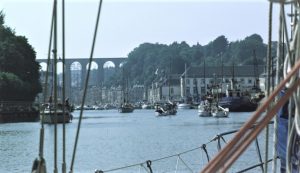
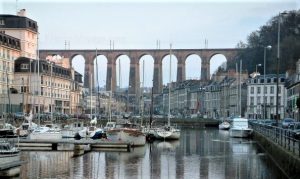 We motored up to Morlaix, arriving just in time to lock into the marina on the river at high tide. We squashed into a vacant place in the large, busy marina. We then received the usual Customs visit, friendly enough but the detailed "inspection" was most unusual. We had a walk around the town, an attractive place with some old houses, all overlooked by the high viaduct
We motored up to Morlaix, arriving just in time to lock into the marina on the river at high tide. We squashed into a vacant place in the large, busy marina. We then received the usual Customs visit, friendly enough but the detailed "inspection" was most unusual. We had a walk around the town, an attractive place with some old houses, all overlooked by the high viaduct 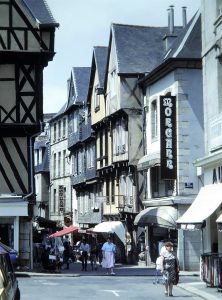 towering over the river. There was a nasty surprise for us on our return: Customs were requiring a hefty daily fee for a "navigation tax", the first we had ever heard of such a thing in France. It was being imposed, it seemed, on Australian, New Zealand and South African boats only. Anything to do with the Pacific nuclear testing dispute, we wondered? We argued that the yacht was British registered, and produced the old British Registry certificate (which had by then been officially replaced by Australian registration that was introduced after we had left). They were still being difficult, so we told the official we couldn’t afford France at that rate and were going to Spain – in practice, no-one else bothered us during the weeks we were in Brittany. No-one we spoke to later, including Australians, had any such problem outside Morlaix.
towering over the river. There was a nasty surprise for us on our return: Customs were requiring a hefty daily fee for a "navigation tax", the first we had ever heard of such a thing in France. It was being imposed, it seemed, on Australian, New Zealand and South African boats only. Anything to do with the Pacific nuclear testing dispute, we wondered? We argued that the yacht was British registered, and produced the old British Registry certificate (which had by then been officially replaced by Australian registration that was introduced after we had left). They were still being difficult, so we told the official we couldn’t afford France at that rate and were going to Spain – in practice, no-one else bothered us during the weeks we were in Brittany. No-one we spoke to later, including Australians, had any such problem outside Morlaix.
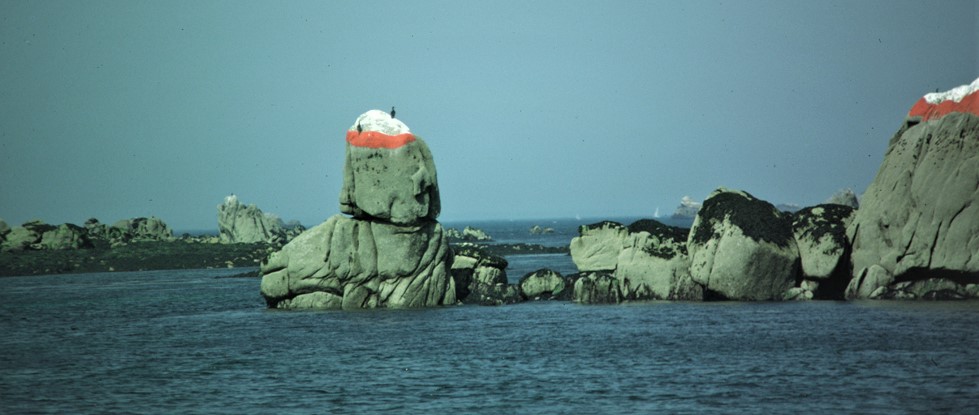 We were going to spend the night in the marina, but were warned that there was going to be very noisy
We were going to spend the night in the marina, but were warned that there was going to be very noisy 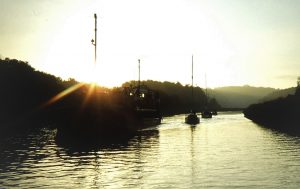 pop concert close ashore that evening, so, just in time for the locking-out process, we left to motor down the river in the setting sun and back to the bay. We anchored at its north end, by the village of Carantec, and were joined by our Oz friends. The weather clamped down again, so we shared some meals and a pleasant walk ashore with them.
pop concert close ashore that evening, so, just in time for the locking-out process, we left to motor down the river in the setting sun and back to the bay. We anchored at its north end, by the village of Carantec, and were joined by our Oz friends. The weather clamped down again, so we shared some meals and a pleasant walk ashore with them.

Once it cleared we motored out past the intimidating rocks, worried again about the fluctuating engine speed. We were able to sail for a while, but the wind died and in flat calm we had to motor along the coast to the west. The mass of rocks extended way out from the shore by a long way, but was well marked by warning buoys. Round one of these, in the late afternoon, we took a sharp turn to the south and entered the narrow but well-marked channel leading into the river and little settlement of l'Aberwrach.
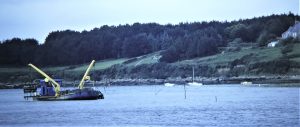 After a misty start the next day was fine, and we walked up to the nearby village of Landeda. This was a friendly place with lots of neat houses old and new, and we did some routine shopping. Back on the river we watched work boats collecting piles of seaweed, a major industry in Brittany, and dredging with chain scoops for oysters in the muddy shallows. We spent six nights there, walking, taking dinghy trips up the river, shopping and getting ready for the major passage to come: crossing the Bay of Biscay to Spain.
After a misty start the next day was fine, and we walked up to the nearby village of Landeda. This was a friendly place with lots of neat houses old and new, and we did some routine shopping. Back on the river we watched work boats collecting piles of seaweed, a major industry in Brittany, and dredging with chain scoops for oysters in the muddy shallows. We spent six nights there, walking, taking dinghy trips up the river, shopping and getting ready for the major passage to come: crossing the Bay of Biscay to Spain.
By Monday July 7 all the weather forecasts for the Atlantic were favourable for the next few days, and in the early morning we motored out to sea along the long approach through the rocks and shallows. The engine had been playing up again, so I bled the fuel system once more. The conditions were miserable, grey skies, grey, cool, starting to rain. Typical! We were soon able to sail, in a squally north-west wind.
By then we were sailing round the north-west tip of Brittany and were approaching a major obstacle, the passage between the Isle of Ushant and a lighthouse on the collection of islets between island and the mainland. This is the Passage du Fromveur, about half a mile wide between the island and the reefs.
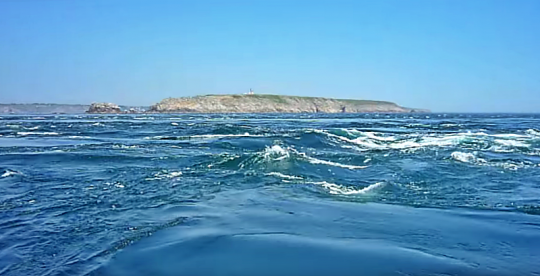 The name Fromveur comes from the Breton words froud, meaning current, and meur meaning great, as the passage can be swept by strong tidal streams, often running at 8 knots. We had timed the approach to avoid the worst of the tides, but it was still pretty intimidating. Further, the Isle of Ushant had interfered with the westerly wind, so we had to resort to the motor to assist - and, of course, it began to fluctuate and threaten to stop. So, in very rough water at the southern end of the pass, just managing to make progress under sail and at the narrowest part of the channel, I was down in the engine room bleeding the system again.
The name Fromveur comes from the Breton words froud, meaning current, and meur meaning great, as the passage can be swept by strong tidal streams, often running at 8 knots. We had timed the approach to avoid the worst of the tides, but it was still pretty intimidating. Further, the Isle of Ushant had interfered with the westerly wind, so we had to resort to the motor to assist - and, of course, it began to fluctuate and threaten to stop. So, in very rough water at the southern end of the pass, just managing to make progress under sail and at the narrowest part of the channel, I was down in the engine room bleeding the system again.
An old Breton proverb proposes: "He who sees Ushant sups his own blood." I could relate to that. After all this tide-ripped rock-hopping, it was a great relief navigationally finally to leave pretty Brittany and sail into the open sea of the Bay of Biscay. Five hours later we were sailing under blue skies in a fair wind from just north of west, going well.
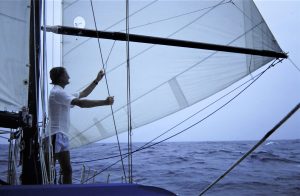 Having cleared the pass we settled into a pleasant afternoon's sailing followed by a busy night, surrounded by dozens of fishing trawlers. By late that afternoon we had passed the half-way mark. The wind was building into a strong northerly, with the number 2 headsail poled out the opposite side to the mainsail. We made good speed overnight and that continued all day until with the evening the wind was up to Force 7 and gales were being forecast for Finisterre. Using the navigational lights we sailed on into the harbour at La Coruna, on the north-west coast of Spain, and anchored just after midnight after two and a half nights at sea, a fast but busy passage without any Biscay dramas.
Having cleared the pass we settled into a pleasant afternoon's sailing followed by a busy night, surrounded by dozens of fishing trawlers. By late that afternoon we had passed the half-way mark. The wind was building into a strong northerly, with the number 2 headsail poled out the opposite side to the mainsail. We made good speed overnight and that continued all day until with the evening the wind was up to Force 7 and gales were being forecast for Finisterre. Using the navigational lights we sailed on into the harbour at La Coruna, on the north-west coast of Spain, and anchored just after midnight after two and a half nights at sea, a fast but busy passage without any Biscay dramas.
Galicia, Spain
La Coruna is a very pleasant port in north-west Spain, the region known as Galicia. Here we started “real” cruising again: we could anchor at last, and the area is indented by a series of lovely fjord-like “rias”, which are drowned river valleys.
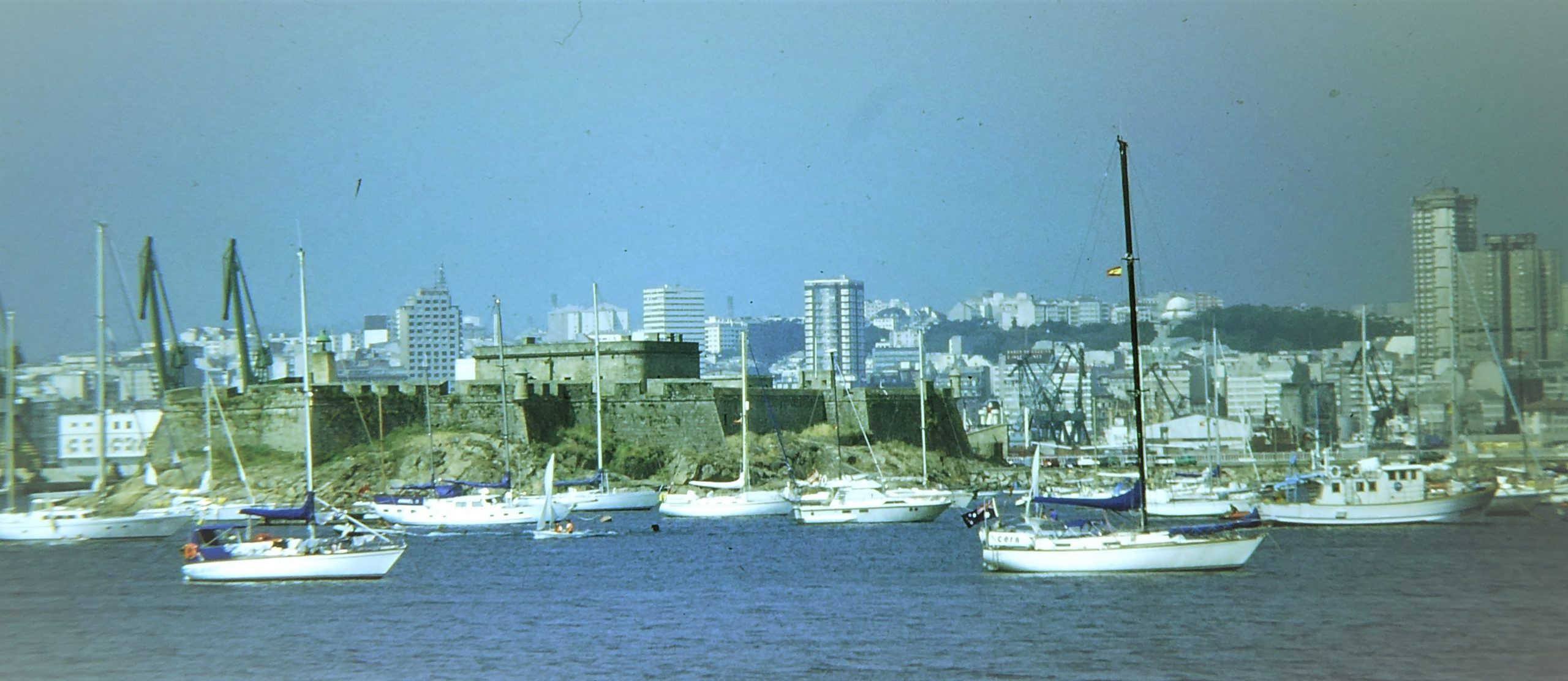 We woke to a calm, clear, blue-skied morning. What a change! Only one simple form was to be signed for the port police ashore, then back to the boat to help some local boats with their anchoring. The harbour is very deep by yachting standards, and too many sailors are reluctant to release sufficient scope for their anchor. (French and Spanish are the worst!) This meant they were dragging all over the place, including into us, with everybody very cheerful!
We woke to a calm, clear, blue-skied morning. What a change! Only one simple form was to be signed for the port police ashore, then back to the boat to help some local boats with their anchoring. The harbour is very deep by yachting standards, and too many sailors are reluctant to release sufficient scope for their anchor. (French and Spanish are the worst!) This meant they were dragging all over the place, including into us, with everybody very cheerful!
The shopping was great in the town, with superb fish and produce markets with very helpful  stallholders anxious to ensure that we understood the produce and the prices. (Norma, as it happens, speaks Spanish.) The old part of town houses some lovely 12th-14th century churches, some little houses in compact squares. We walked out to the Torre de Hercules, a lighthouse for hundreds of years, with brick facing over the original Roman stone.
stallholders anxious to ensure that we understood the produce and the prices. (Norma, as it happens, speaks Spanish.) The old part of town houses some lovely 12th-14th century churches, some little houses in compact squares. We walked out to the Torre de Hercules, a lighthouse for hundreds of years, with brick facing over the original Roman stone.
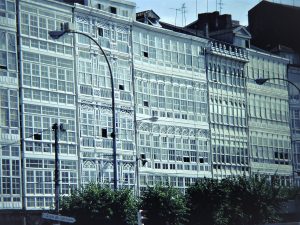 The town is also famous for the glassy facades of many of the buildings, with bright reflections in the morning sun.
The town is also famous for the glassy facades of many of the buildings, with bright reflections in the morning sun.
We took an outing from here: a comfortable bus ride to Santiago de Compostela by the autopista, through rolling green countryside, small farmhouses overlooking small fields, truly of the "old" Spain.
 The city and its cathedral are, of course, world famous as the reputed burial site of the apostle St James the Great, and in 1985 had been declared a UNESCO World
The city and its cathedral are, of course, world famous as the reputed burial site of the apostle St James the Great, and in 1985 had been declared a UNESCO World 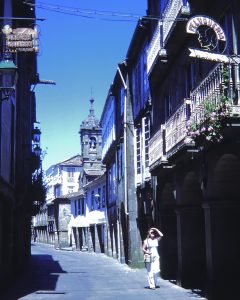 Heritage site. We started with the cathedral, the end of a route of pilgrimage since the 11th century, and used Michener's great book Iberia as a guide. Each of the four faces of the cathedral is beautiful, and each one is of a slightly different style, depending on the era it was built. The glorious Baroque western facade looks over the main plaza, the Praza do Obradoiro, and the other faces all have their own plaza.
Heritage site. We started with the cathedral, the end of a route of pilgrimage since the 11th century, and used Michener's great book Iberia as a guide. Each of the four faces of the cathedral is beautiful, and each one is of a slightly different style, depending on the era it was built. The glorious Baroque western facade looks over the main plaza, the Praza do Obradoiro, and the other faces all have their own plaza.
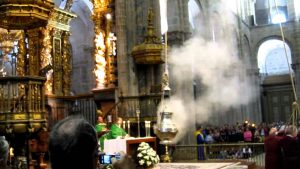 We entered the cathedral during the latter part of a mass, and caught some Bach played on the remarkable organ, with some horizontal pipes. We were hugely fortunate also to catch the swinging of the Botafumeiro, an enormous censor full of burning charcoal and smoking incense. This is hung by rope from the sky-high dome of the transept and swung by a team of men until its dramatic arc reaches the very eaves of the cathedral.
We entered the cathedral during the latter part of a mass, and caught some Bach played on the remarkable organ, with some horizontal pipes. We were hugely fortunate also to catch the swinging of the Botafumeiro, an enormous censor full of burning charcoal and smoking incense. This is hung by rope from the sky-high dome of the transept and swung by a team of men until its dramatic arc reaches the very eaves of the cathedral.
After a good lunch we strolled through the superbly maintained old part of the city before returning to La Coruna again by bus. But this time the bus took the scenic route, through lots of pretty villages. Men with black berets were leading their donkeys with carts, red-roofed houses had outhouses for grain and cheese, cooled by the breeze through wooden slats.
The weather and the forecast were looking good, but we were stuck for a while, waiting for mail. My mother told us that she had posted two packages at least a fortnight ago, probably including a set or two of processed 35mm slides. But every time we went to the local Amex to check, nada. Meanwhile, we got on with some boat maintenance and enjoyed the social life. Many of the English-speaking crews we had come in contact with in the UK and Channel Islands, and others were joining the many who would be going on south. So it was regular drinks and meals on several different yachts, including ours.
We became particular friends with two very different couples in very different boats: ex-pilot Tom and Sylvia Thomas, in the Hillyard wooden double-ender Diphda, and an American couple, prosperous New York businessman Bill and Eileen Kederska in their luxurious 49ft Halberg-Rassey Aurora, which they had just had built in Sweden. We were to see a lot of all four, and sometimes with the six of us together, many times in coming months and maintained contact and correspondence for years.
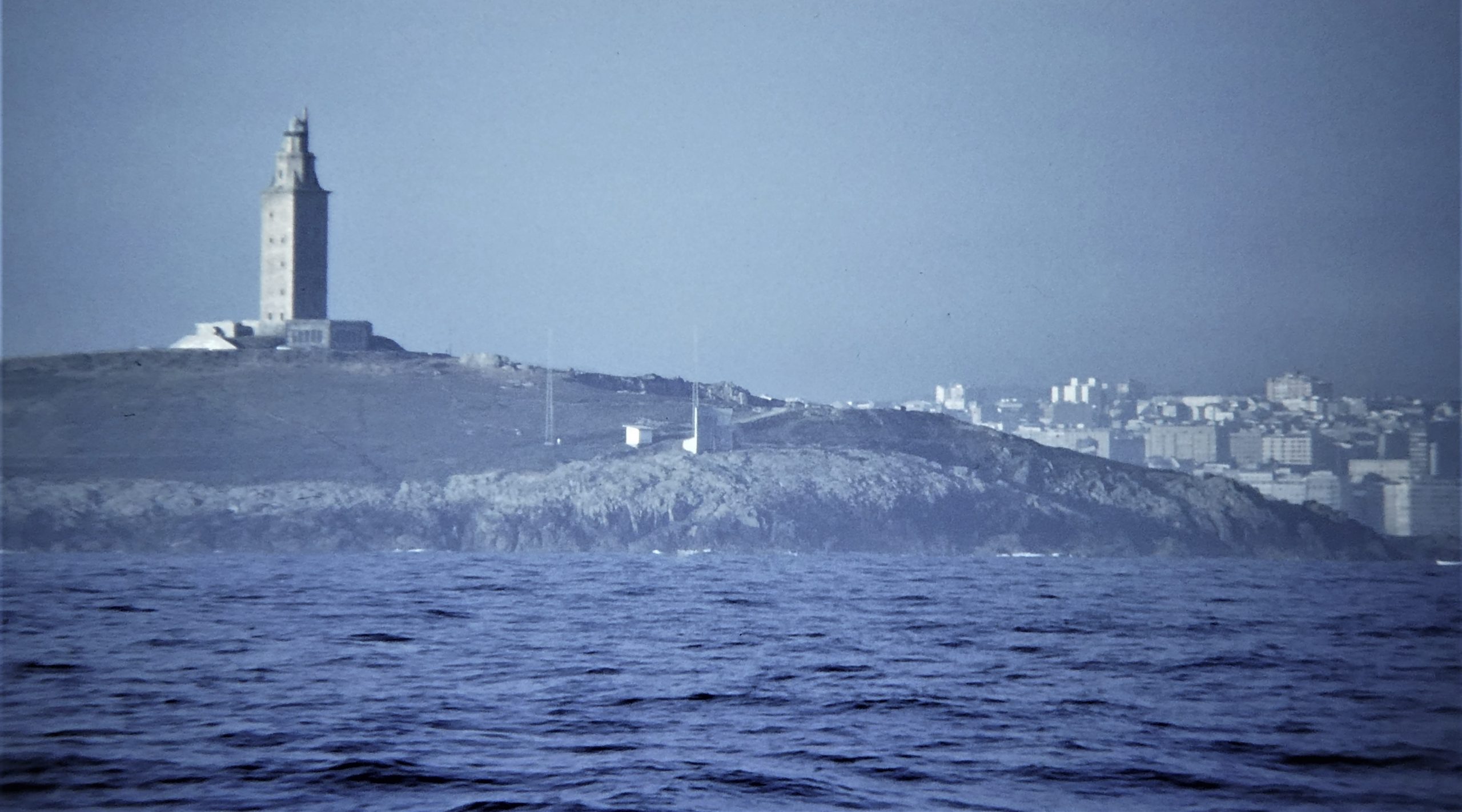 We had to give up waiting eventually, and sailed out of the harbour and round the prominent Torre de Hercules. It was then a pleasant sail down to the first of the rias we would be visiting, Ria Camarinas.
We had to give up waiting eventually, and sailed out of the harbour and round the prominent Torre de Hercules. It was then a pleasant sail down to the first of the rias we would be visiting, Ria Camarinas.
"Ria" means, in Spanish, an estuary, a long inlet of water in a drowned valley. Because of the annual battering by the Atlantic ocean, as in Brittany, the coast here in Galicia is a mass of such rias, protected by steep headlands, islets and masses of rocky outposts.
We anchored just beyond the village of Camarinas, off a peaceful beach. At first sight the village appeared very run down, but with much construction  work under way. It did turn out to be a simple fishing village, pleasant enough.
work under way. It did turn out to be a simple fishing village, pleasant enough.
Still having trouble getting air into the fuel system, leading to irregular running of the engine, I decided to strip the whole system. What I found was that two critical O-rings in the main fuel filter had been frozen solid over the winter in St Katharine's, and were not sealing properly. This was allowing small bubbles to collect at the injector and block the fuel intake. I replaced the O-rings and sealed the system better, after which we had no more problems. I should have thought of this possibility sooner, but frozen O-rings is not a problem we had faced in Australia or the Pacific.
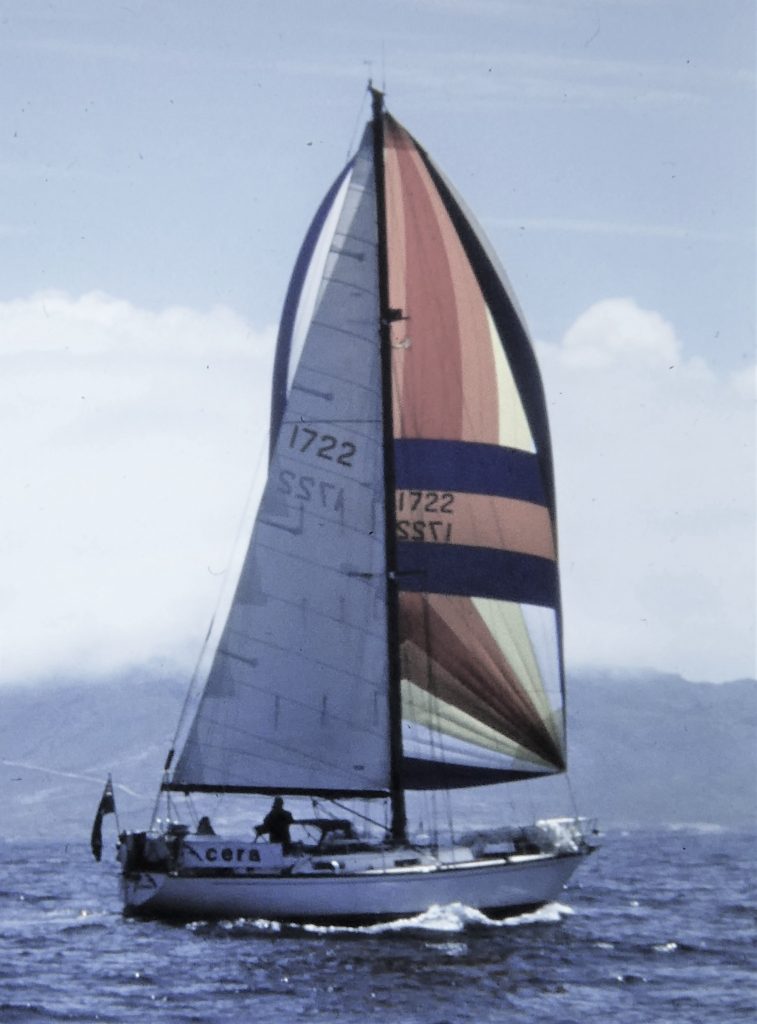 The next leg of our passage round the north-west corner of Spain took us past Cape Finisterre, where great white clouds were spilling over the headland, notorious for heavy seas and bad weather. Finisterre, the "end of the earth", was thought by the Romans to be the furthest western headland on the continent, but further south there are a couple more headlands reaching a few miles further out. We would soon be rounding both of them.
The next leg of our passage round the north-west corner of Spain took us past Cape Finisterre, where great white clouds were spilling over the headland, notorious for heavy seas and bad weather. Finisterre, the "end of the earth", was thought by the Romans to be the furthest western headland on the continent, but further south there are a couple more headlands reaching a few miles further out. We would soon be rounding both of them.
We were having a great sail under spinnaker while rounding the cape when we were photographed by a friend who gave us a print later. It's very hard to get such pictures when you're away at sea!
 Our destination was the Ria de Muros y Noya, and we anchored just off the village of Muros. We were soon to be joined by Diphda and Aurora, leading to yet more socialising aboard and ashore.
Our destination was the Ria de Muros y Noya, and we anchored just off the village of Muros. We were soon to be joined by Diphda and Aurora, leading to yet more socialising aboard and ashore.
Muros is a very attractive little town, which had been declared to be of Historic-Artistic Interest. It was backed by terraced fields along with a particularly attractive Romanesque church on the hillside.
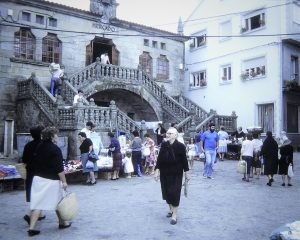
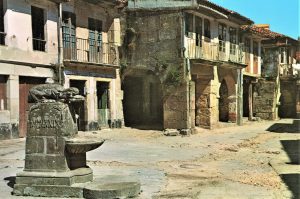 In the old part of the town there were lots of arched alleyways over narrow, winding alleys. There were several small plazas throughout the old centre, one with an intriguing fountain topped by a sculpture of a cross-looking a lizard. There was a beautiful old market building nearby, quite busy when we visited.
In the old part of the town there were lots of arched alleyways over narrow, winding alleys. There were several small plazas throughout the old centre, one with an intriguing fountain topped by a sculpture of a cross-looking a lizard. There was a beautiful old market building nearby, quite busy when we visited.
Muros has a long history of fishing, but 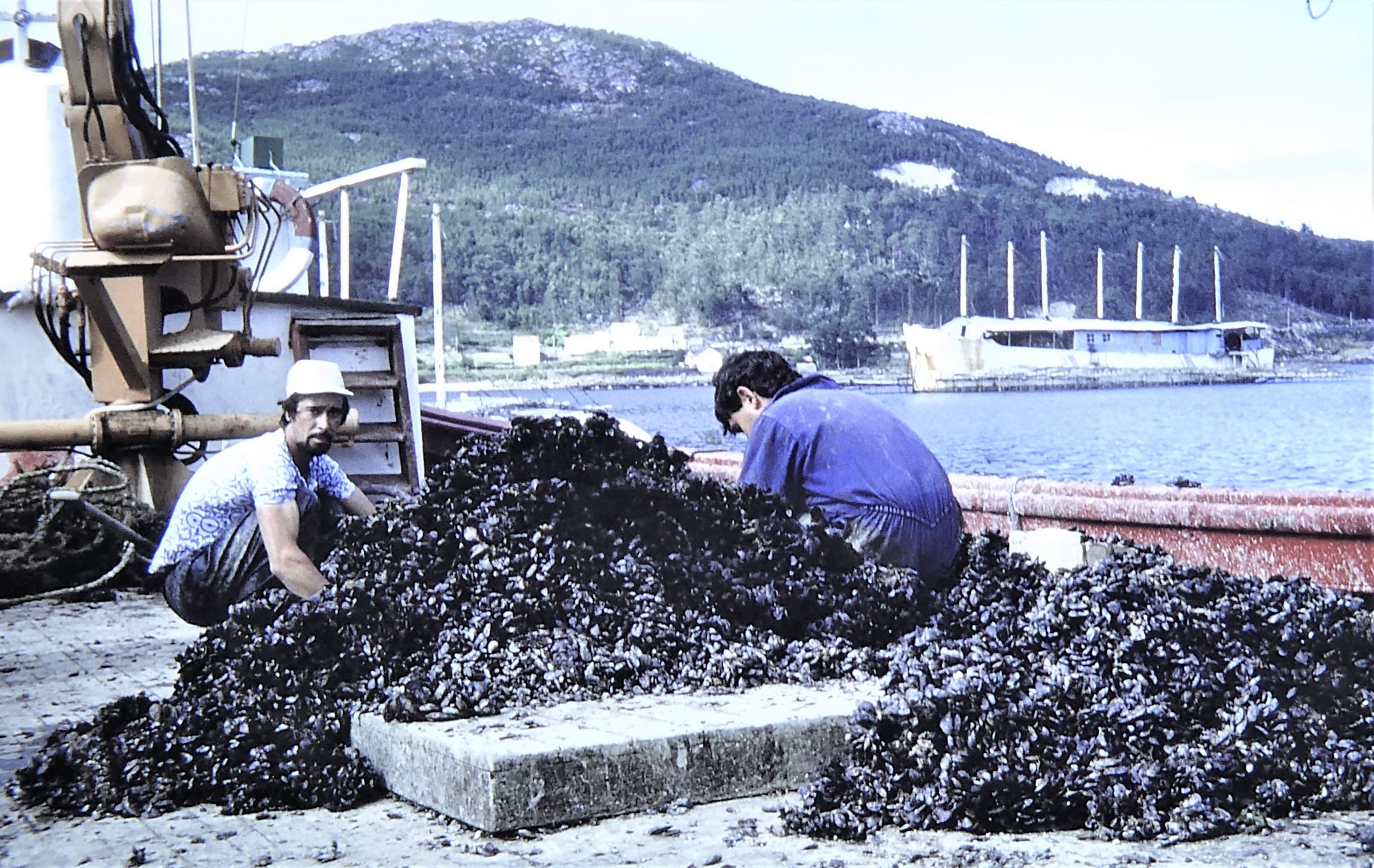 at the time of our visit it was primarily a massive mussel farm, with
at the time of our visit it was primarily a massive mussel farm, with  swarms of mussel rafts as far as could be seen. We went out in the dinghy to see how the cheerful fishermen handled the whole affair of harvesting the mussels and bringing them ashore.
swarms of mussel rafts as far as could be seen. We went out in the dinghy to see how the cheerful fishermen handled the whole affair of harvesting the mussels and bringing them ashore.
After three peaceful nights in beautiful weather we continued down the coast, rounding the next major headland to the south and up into the Ria de Arousa and the little town of Puebla del Caraminal. We had only just anchored when the first thing we had to do was go and help the crew of a Dutch ferro-cement ketch which, in a 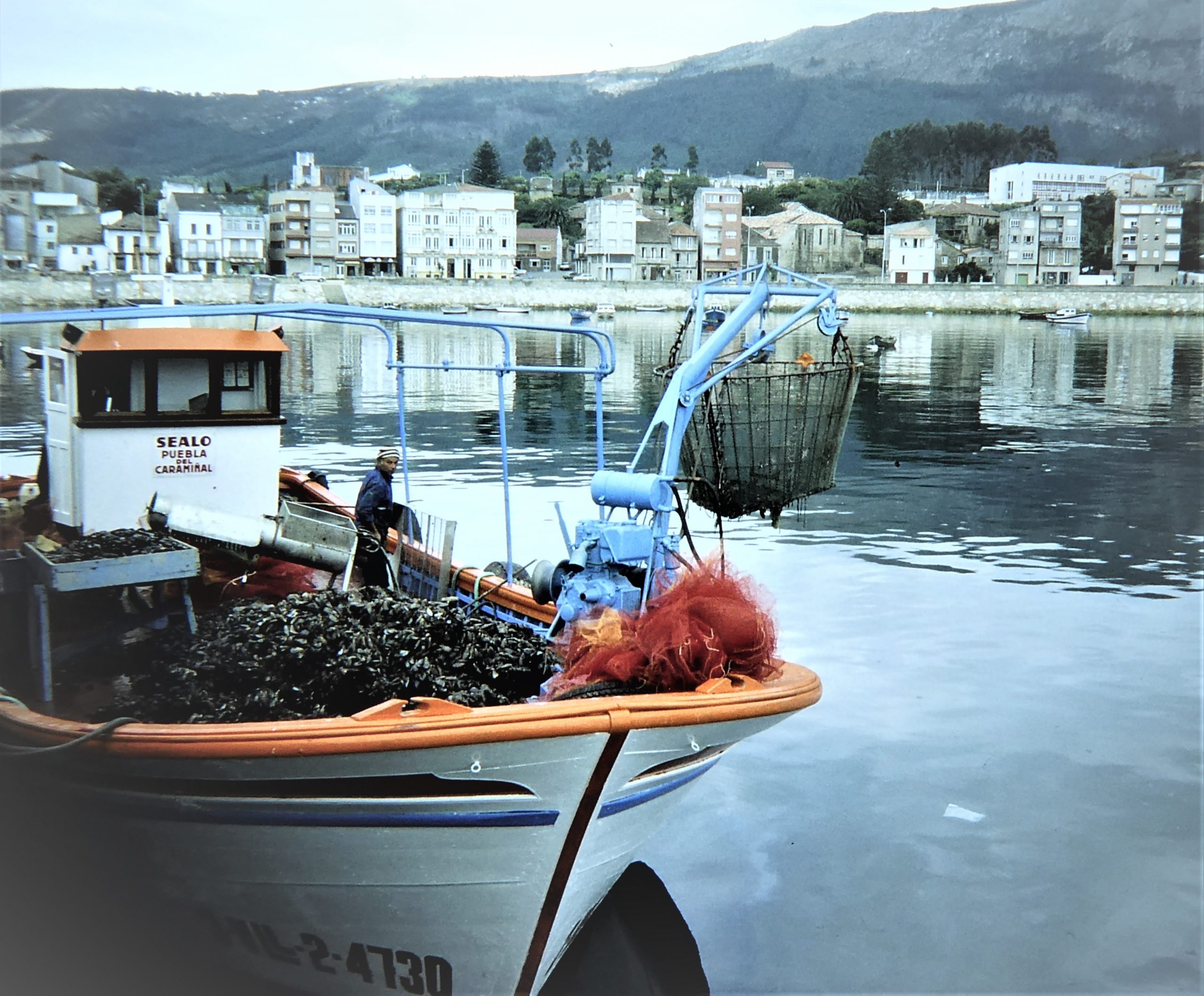 typically incompetent show of anchoring, was in danger of dragging ashore or into other vessels. They had a too-small weird crescent-shaped French patent anchor on far too little chain.
typically incompetent show of anchoring, was in danger of dragging ashore or into other vessels. They had a too-small weird crescent-shaped French patent anchor on far too little chain.
Ashore, we found a prosperous village, with several factories in the business of processing mussels from scores of rafts in the bay. There was a confusing mass of lanes and streets. We filled some jerries with water from the village fountain. Basic stores were available in the week, but on Saturday there was a thriving market with a wide variety of fish - but many not much more than tiddlers. There were good vegetables, farmers' market style.
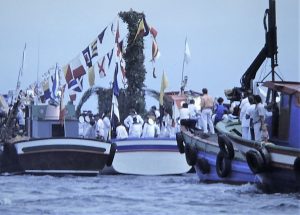 We then motored across to the other side of the ria and to San Julian, on the Isla de Arosa (aka Illa de Arousa). We anchored in a wide bay on the north side of the small island. The first thing we heard was a fusillade of typical Spanish fireworks, loud bangs, and it appeared that we had chanced upon a major local festival.
We then motored across to the other side of the ria and to San Julian, on the Isla de Arosa (aka Illa de Arousa). We anchored in a wide bay on the north side of the small island. The first thing we heard was a fusillade of typical Spanish fireworks, loud bangs, and it appeared that we had chanced upon a major local festival.
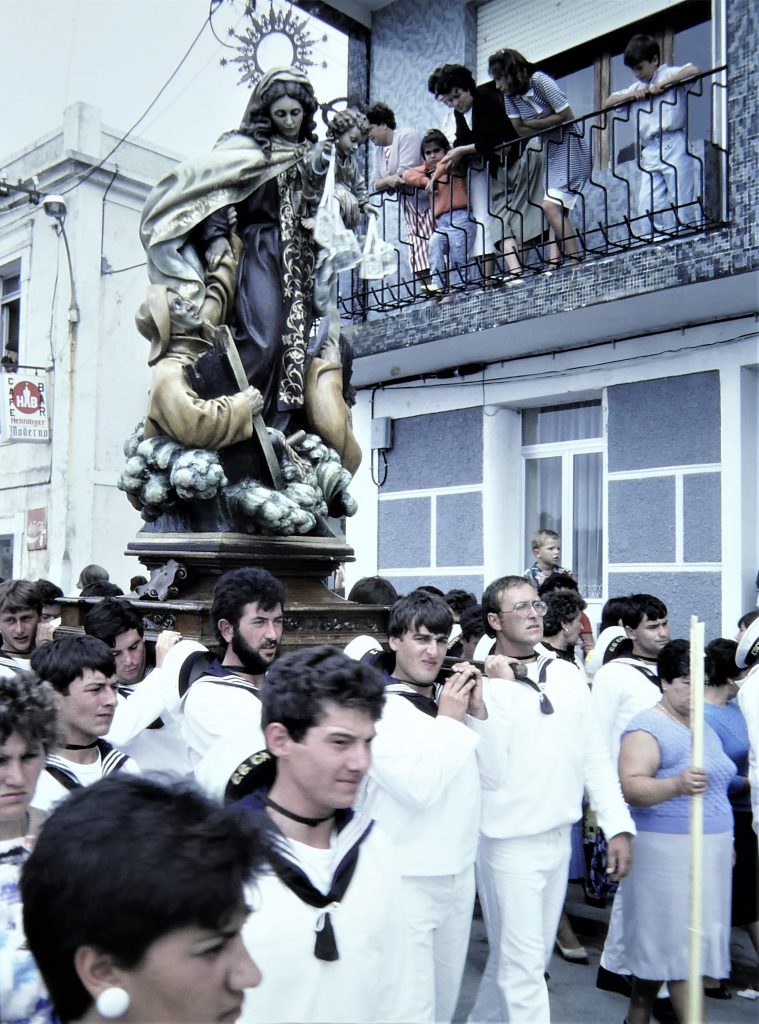 The bay was a mass of fishing boats, many of them colourfully dressed with flags. This, we learnt, was the last day of the Festa do Vrau, with today's saint being the patron saint of mariners.
The bay was a mass of fishing boats, many of them colourfully dressed with flags. This, we learnt, was the last day of the Festa do Vrau, with today's saint being the patron saint of mariners.
An effigy of the saint lending a tender hand to a supplicating seaman was carred by a group of sailors, who walked in slow procession through the streets of the 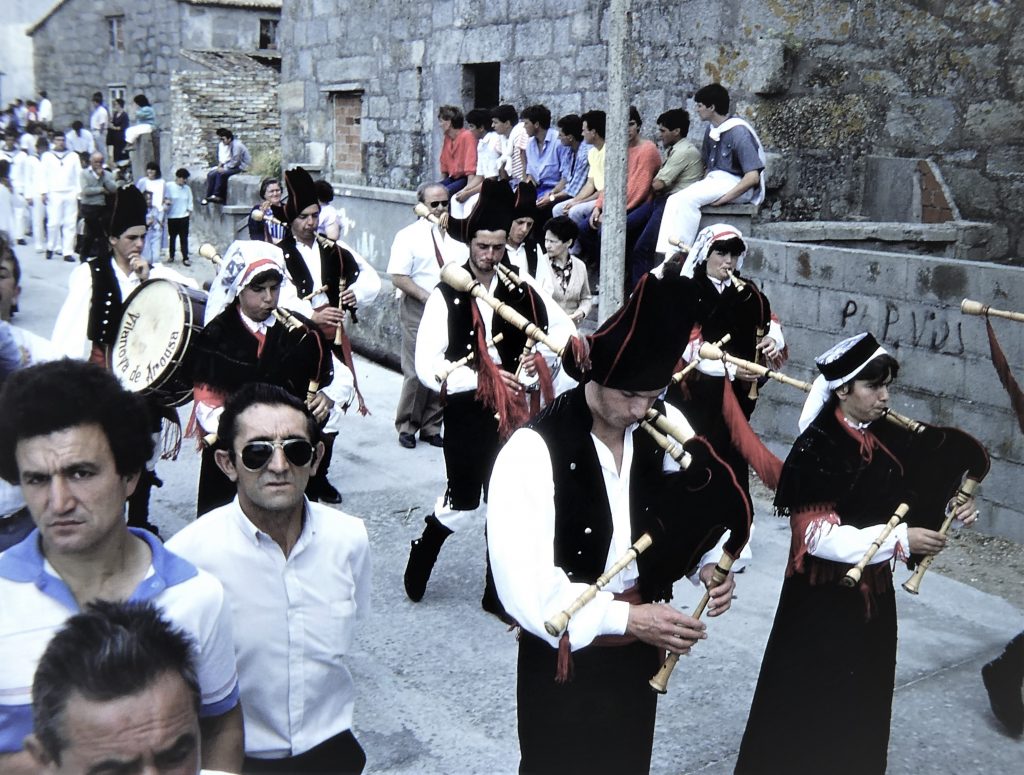 village. The procession was accompanied by a band of Galician bagpipes and drums. All participants were in local costume, a very colourful scene.
village. The procession was accompanied by a band of Galician bagpipes and drums. All participants were in local costume, a very colourful scene.
We went back ashore in the evening and enjoyed more local bagpipe music and, later, another Galleghan music ensemble. This was a fascinating day to have happened upon.
There were no tourists there, let alone any other "Ingles". Galicians tend to have a default frown on their face, and we were never sure quite how welcoming they were for our uninvited attendance at their festival.
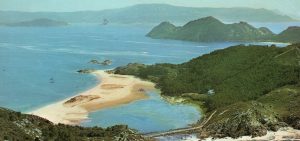 After a great weekend here we sailed down and out of the ria and south to the Isles Cies, a mile or two off the mouth of the Ria de Vigo. This group of small islands appeared to be a local tourist attraction. We anchored off a popular long beach on the east side, facing the mainland. We had a walk ashore, seeing the immense and obviously populat camp site. We stayed for what turned out to be a peaceful night there, a bit of a surprise because the anchorage was wide open to the east and we felt a bit exposed - but a light land breeze kept us facing into the chop.
After a great weekend here we sailed down and out of the ria and south to the Isles Cies, a mile or two off the mouth of the Ria de Vigo. This group of small islands appeared to be a local tourist attraction. We anchored off a popular long beach on the east side, facing the mainland. We had a walk ashore, seeing the immense and obviously populat camp site. We stayed for what turned out to be a peaceful night there, a bit of a surprise because the anchorage was wide open to the east and we felt a bit exposed - but a light land breeze kept us facing into the chop.
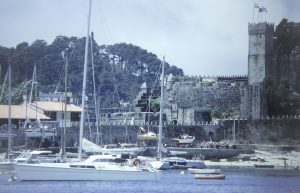 From there it was a short trip down to the big town of Puerto do Bayona, where several cruising yachts were anchored off the yacht club, including many friends. Inevitably, we immediately re-entered socialising mode. We had arrived a couple of days after my birthday, so we took ourselves out to dinner: a very good one, with a kind of ceviche followed by roast suckling pig with little peppers and chips. We had drinks with Tom and Sylvia at the yacht club on the way back to the boat.
From there it was a short trip down to the big town of Puerto do Bayona, where several cruising yachts were anchored off the yacht club, including many friends. Inevitably, we immediately re-entered socialising mode. We had arrived a couple of days after my birthday, so we took ourselves out to dinner: a very good one, with a kind of ceviche followed by roast suckling pig with little peppers and chips. We had drinks with Tom and Sylvia at the yacht club on the way back to the boat.
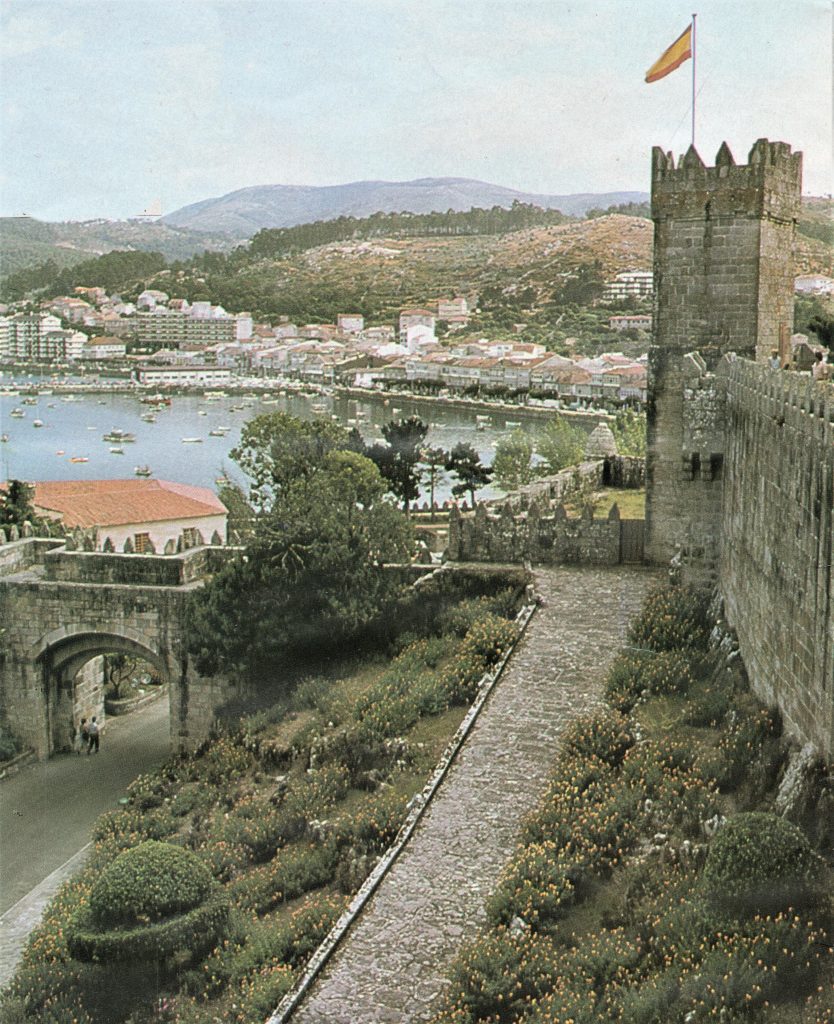 Up the hill on the headland protecting the bay is an old castle that has been converted to a parador, a posh hotel. We took a walk up there, but were not much welcome! We took a bus into Vigo, the big city of the region, fixing new mail forwarding arrangements with the Amex office. We walked Vigo's old town, the waterfront, and up to a castle with a good view of the Ria de Vigo.
Up the hill on the headland protecting the bay is an old castle that has been converted to a parador, a posh hotel. We took a walk up there, but were not much welcome! We took a bus into Vigo, the big city of the region, fixing new mail forwarding arrangements with the Amex office. We walked Vigo's old town, the waterfront, and up to a castle with a good view of the Ria de Vigo.
The weather changed for the worse for a couple of days, with more yachts dragging their anchors. Some never learn, and think it's normal. We wrote a lot of letters, enjoyed more socialising, and I attended Sylvia (on Diphda) to give some medical advice. Happily, she soon improved.
It was then time to get going south and cross the border into a new country, Portugal.
Portugal
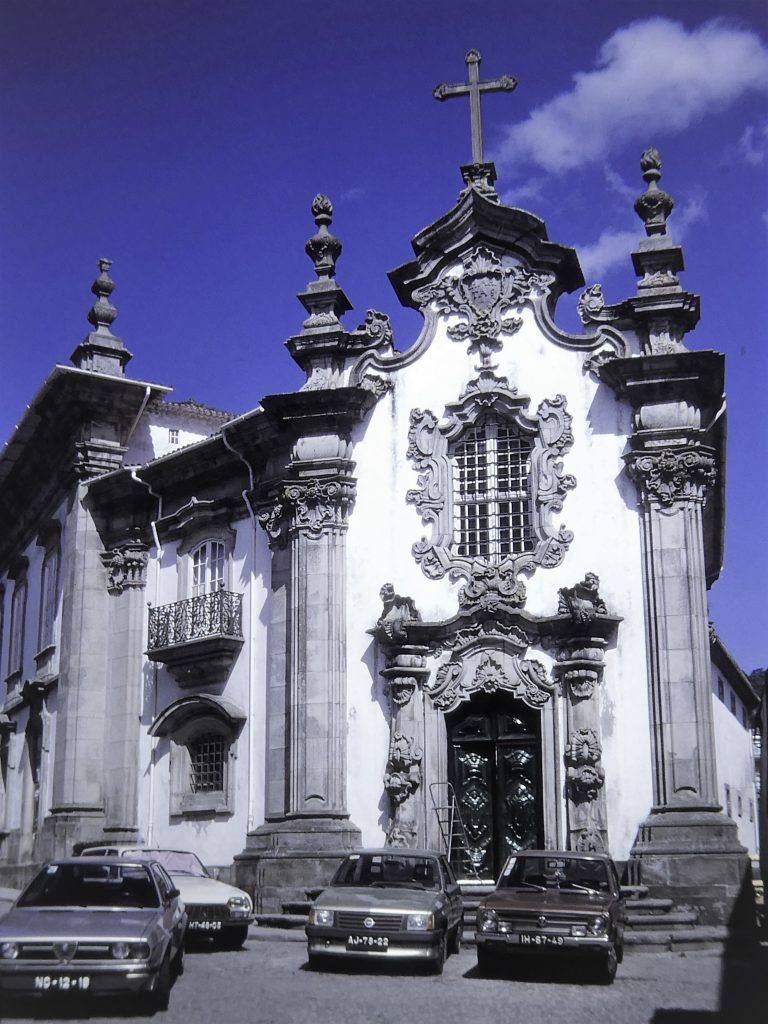 The passage leg was a short one, a drifting sail and some motoring, down from Bayona to the Port of Entry for Portugal, Viana do Costelo. This lies at the estuarine end of the River Lima/Limia at the foot of a steeply sloping hillside. Arriving in the evening, there was no indication as to where we might go, so we anchored off a slipway at what looked like an old pilot station. We soon got a call from an official shore indicating that we - and a Dutch boat anchored nearly - should move into a commercial dock, in which we tied up. This was a ship-sized dock, and there was a wide tidal range, so at low tide we had to scramble a long way up a grimy ladder on a filthy wall to report in to an office for immigration and other clearance procedures. We still had to go in and report to the Port Captain the next day.
The passage leg was a short one, a drifting sail and some motoring, down from Bayona to the Port of Entry for Portugal, Viana do Costelo. This lies at the estuarine end of the River Lima/Limia at the foot of a steeply sloping hillside. Arriving in the evening, there was no indication as to where we might go, so we anchored off a slipway at what looked like an old pilot station. We soon got a call from an official shore indicating that we - and a Dutch boat anchored nearly - should move into a commercial dock, in which we tied up. This was a ship-sized dock, and there was a wide tidal range, so at low tide we had to scramble a long way up a grimy ladder on a filthy wall to report in to an office for immigration and other clearance procedures. We still had to go in and report to the Port Captain the next day.
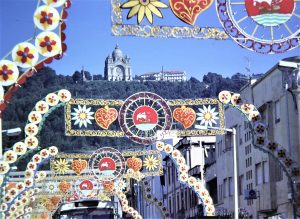 There were only a few forms to complete, and a low fee to pay for a year's cruising permit. We walked into the old part of what was a gorgeous little town. We admired lots of splendid and beautiful buildings, typically ornate in Portuguese style, particularly around the main square, the Praca de Republica. The lovely church there displayed its exuberant architecture, gleaming white and the whole interior was lined with blue and white ceramic tiles, so typical of the country.
There were only a few forms to complete, and a low fee to pay for a year's cruising permit. We walked into the old part of what was a gorgeous little town. We admired lots of splendid and beautiful buildings, typically ornate in Portuguese style, particularly around the main square, the Praca de Republica. The lovely church there displayed its exuberant architecture, gleaming white and the whole interior was lined with blue and white ceramic tiles, so typical of the country.
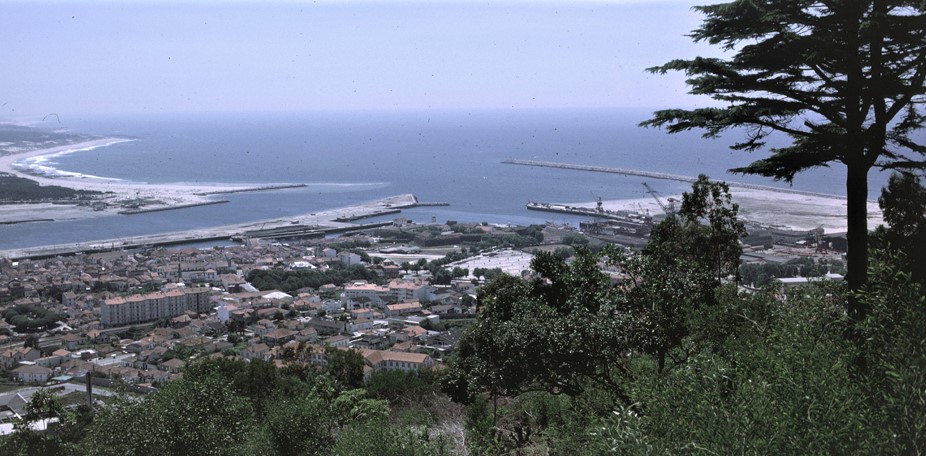 We took a funicular railway up the hillside to the top, from where we had a magnificent view of the estuary and the harbour. At the peak sat the Santuario de Santa Luzia, a basilica that had been built quite recently and was not as attractive as the old churches down in the town.
We took a funicular railway up the hillside to the top, from where we had a magnificent view of the estuary and the harbour. At the peak sat the Santuario de Santa Luzia, a basilica that had been built quite recently and was not as attractive as the old churches down in the town.
The whole place was a mass of street decorations for a forthcoming fiesta, and in the tourist office there were some song and dance presentations by way of promotion.
The town was lovely, but the dock was not a good place to stay because it was really too deep to climb the vertical ladders every time to go ashore. So, after a couple of nights we pulled out and had a good sail in a fair wind down to Porto de Leixoes.
We anchored inside the breakwater, which extended well out into the sea. This was a very busy port, with big ships coming and going at all hours, with resulting wakes and disturbance. It was, however, a place from which we could go and visit the famous city of Porto/Oporto, and that was the reason we were there.
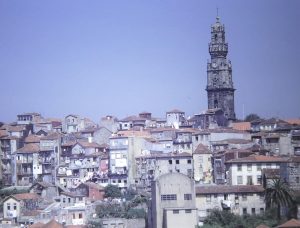
 We took a bus into Porto, which was what we came to regard as rather a shambolic place. (We seemed to use the word "shambolic" quite a lot in Portugal!) Tier upon tier of old terraced buildings ranged up the steep and cobbled little streets over which washing hung out and into which slops were chucked out from windows. At the top we visited the massive
We took a bus into Porto, which was what we came to regard as rather a shambolic place. (We seemed to use the word "shambolic" quite a lot in Portugal!) Tier upon tier of old terraced buildings ranged up the steep and cobbled little streets over which washing hung out and into which slops were chucked out from windows. At the top we visited the massive 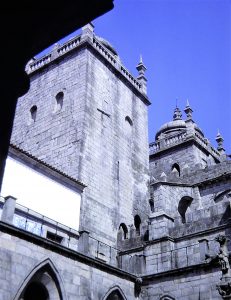 Romanesque cathedral and the ornate church of St Francis, where gold paint was sadly peeling. We lunched on good peasant food, Tripas a la mode Porto (tripe and bean stew with not much tripe), with lots of good wine.
Romanesque cathedral and the ornate church of St Francis, where gold paint was sadly peeling. We lunched on good peasant food, Tripas a la mode Porto (tripe and bean stew with not much tripe), with lots of good wine.
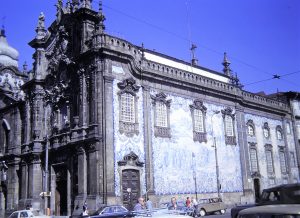 We crossed over the River Douro to the shabby Vila Nova de Gaia suburb, where cellars ("lodges") prepare and age the port, and where the old sailing skiffs now lie tied up in a picturesque manner. They used to carry the wine barrels down from the vineyards further up the Douro, a famous and beautiful grape-growing region. We visited two of the port producers, both offering very generous tastings of their wines, both white and red. Back in the town we took a guided tour of the amazing Chamber of Commerce building, once the stock market, including its incredible Moorish Banqueting Hall.
We crossed over the River Douro to the shabby Vila Nova de Gaia suburb, where cellars ("lodges") prepare and age the port, and where the old sailing skiffs now lie tied up in a picturesque manner. They used to carry the wine barrels down from the vineyards further up the Douro, a famous and beautiful grape-growing region. We visited two of the port producers, both offering very generous tastings of their wines, both white and red. Back in the town we took a guided tour of the amazing Chamber of Commerce building, once the stock market, including its incredible Moorish Banqueting Hall.

 The buses went on strike during the day, so with a couple of yachty friends we had to take a taxi back to the port.
The buses went on strike during the day, so with a couple of yachty friends we had to take a taxi back to the port.
Overnight the evening mist had turned to fog, so those of us aiming to go back to sea had to stay put. This worked well, because over drinks in the local yacht club, along with several friends, we were joined by a Portuguese couple whom we had met with their yacht in Bayona, Guillerme and Elena Guimaraes. Along with Tom and Sylvia from Diphda, they invited us out for a tour the next day of an important part of northern Portugal, where sleepy historic towns – once of great importance to the old kingdoms – now nestle in the hills among the vineyards.
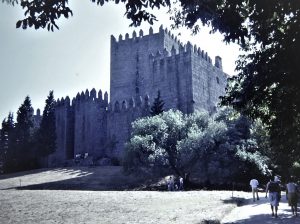
 We were picked up from the port by Guillerme and his family, and we all piled into a nine-seat Peugeot. We went first to the town of Guimaraes, a UNESCO World Heritage site. It is celebrated as the birthplace of the nation, chosen in 1139 as his capital by Portugal's first king, Alfonso Henriques, who was reputedly born there. The huge square keep of his "royal" fortified manor/castle, the Castelo de Guimaraes - very well restored and maintained - dominates the town. We visited the town's pousada, a very beautiful baroque ex-monastery, superbly converted.
We were picked up from the port by Guillerme and his family, and we all piled into a nine-seat Peugeot. We went first to the town of Guimaraes, a UNESCO World Heritage site. It is celebrated as the birthplace of the nation, chosen in 1139 as his capital by Portugal's first king, Alfonso Henriques, who was reputedly born there. The huge square keep of his "royal" fortified manor/castle, the Castelo de Guimaraes - very well restored and maintained - dominates the town. We visited the town's pousada, a very beautiful baroque ex-monastery, superbly converted.
We went to the top of a hill overlooking the town and the expanse of environs, to a marvellous viewpoint with a fairly modern church, the Sanctuary of Penha, at the peak.
We drove then to nearby Braga. This has a long history as a religious and commercial centre, and is still regarded as the ecclesiastical capital of Portugal. Up on the top of a forested 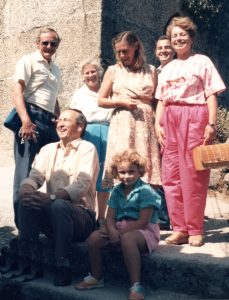 hill stands Portugal's most spectacular religious sanctuary, the stairway and church of the Bom Jesus do Monte. The zig-zag stairway is built in three sections, with biblical, mythological and symbolic themes. The gardens all around were very pretty.
hill stands Portugal's most spectacular religious sanctuary, the stairway and church of the Bom Jesus do Monte. The zig-zag stairway is built in three sections, with biblical, mythological and symbolic themes. The gardens all around were very pretty.
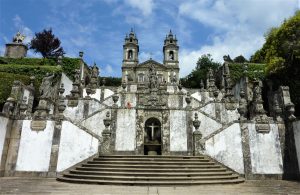 Returning to Leixoes it became misty again, with solid fog at sea, and over the next few days became showery and wet. But finally after a week in the harbour we were off south again, for an overnight sail down to Cascais. This was a fine enough short passage, with some pleasant sailing under high white overcast the first afternoon, followed by a clear night. However, in the middle of the night the wind left us and never re-appeared, so we motored the rest of the way. In the early hours of the morning we got - nearly literally - entangled with a vast mass of fishing boats using long seine nets. We were shepherded out from the maze by one of their longboats, flashing a light for us. On the final approach to Cascais in the second afternoon we rounded Cabo da Roca, the actual western-most point of the Eurasian land mass.
Returning to Leixoes it became misty again, with solid fog at sea, and over the next few days became showery and wet. But finally after a week in the harbour we were off south again, for an overnight sail down to Cascais. This was a fine enough short passage, with some pleasant sailing under high white overcast the first afternoon, followed by a clear night. However, in the middle of the night the wind left us and never re-appeared, so we motored the rest of the way. In the early hours of the morning we got - nearly literally - entangled with a vast mass of fishing boats using long seine nets. We were shepherded out from the maze by one of their longboats, flashing a light for us. On the final approach to Cascais in the second afternoon we rounded Cabo da Roca, the actual western-most point of the Eurasian land mass.

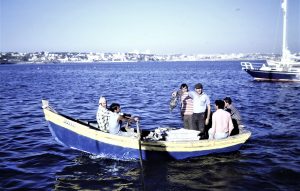 We anchored in the open bay of the touristy little town of Cascais, which would be our base for visiting Lisbon. We walked round some of the rather splendid but dilapidated mansions in the old part of town and viewed a fish auction that featured rather sad and very dead fish.
We anchored in the open bay of the touristy little town of Cascais, which would be our base for visiting Lisbon. We walked round some of the rather splendid but dilapidated mansions in the old part of town and viewed a fish auction that featured rather sad and very dead fish.
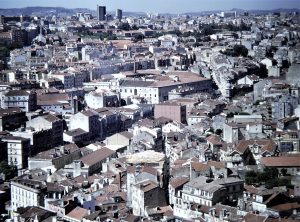 We took an excellent early train into the centre of the city of Lisbon. We climbed the slopes through the ancient "bairro" quarter and up to the opulent church of Sao Roque, with its magnificent baroque interior. Like most churches here the interiors are dark, and we were taken around by a friendly custodian. Switching
We took an excellent early train into the centre of the city of Lisbon. We climbed the slopes through the ancient "bairro" quarter and up to the opulent church of Sao Roque, with its magnificent baroque interior. Like most churches here the interiors are dark, and we were taken around by a friendly custodian. Switching 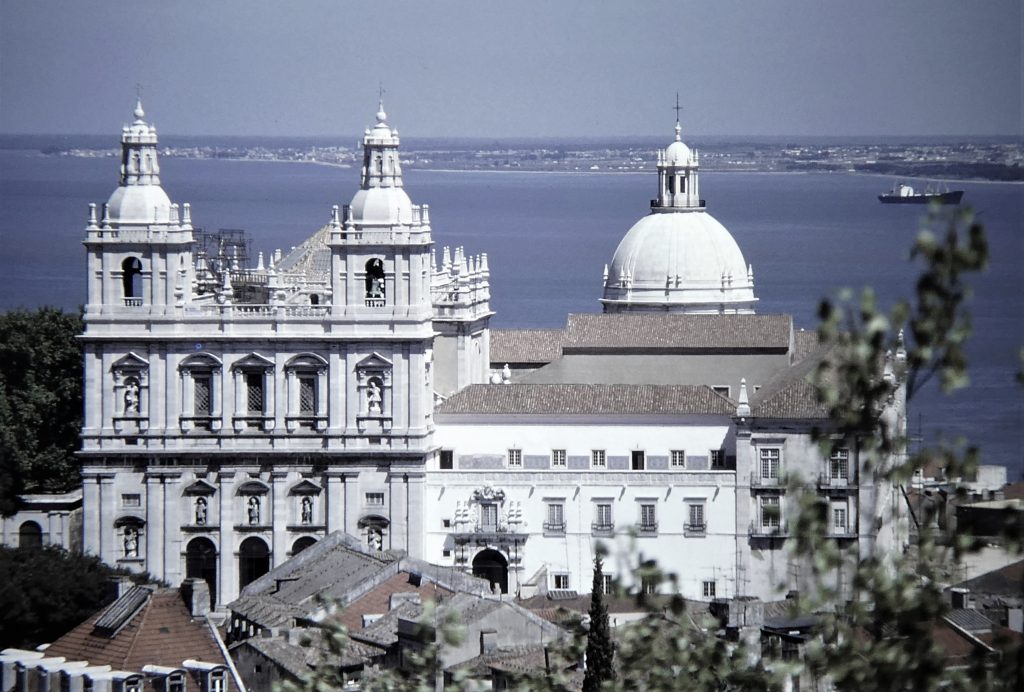 lights on when needed, he showed us the gold and silver inlays, sheets of Portuguese marble, and timber from Brazil. Nearer the city commercial centre we tried in vain to get some useful information out of two "Turismo" offices; with more helpful information, we considered later, we would have made better use of our short time in the city. But w did find the Amex office, where there was actually a letter for us, and changed US dollars for Spanish pesetas.
lights on when needed, he showed us the gold and silver inlays, sheets of Portuguese marble, and timber from Brazil. Nearer the city commercial centre we tried in vain to get some useful information out of two "Turismo" offices; with more helpful information, we considered later, we would have made better use of our short time in the city. But w did find the Amex office, where there was actually a letter for us, and changed US dollars for Spanish pesetas.
After a good lunch in the office district we took the steep climb up through another old part of town to the Castelo de San Jorge. There was a splendid view up there over the city and the River Tagus. Via a  visit to the ruins of a 14th centurt Carmelite convent we walked down to the Praca do Comercio, a big and what would have been an impressive open square had it not been simply a massive car park and swarming with traffic. Lisbon was too shambolic, noisy and packed with traffic to be truly enjoyable – keeping the cars out of the maze-like centre would be an improvement. Train back to Cascais and dinner aboard Diphda.
visit to the ruins of a 14th centurt Carmelite convent we walked down to the Praca do Comercio, a big and what would have been an impressive open square had it not been simply a massive car park and swarming with traffic. Lisbon was too shambolic, noisy and packed with traffic to be truly enjoyable – keeping the cars out of the maze-like centre would be an improvement. Train back to Cascais and dinner aboard Diphda.
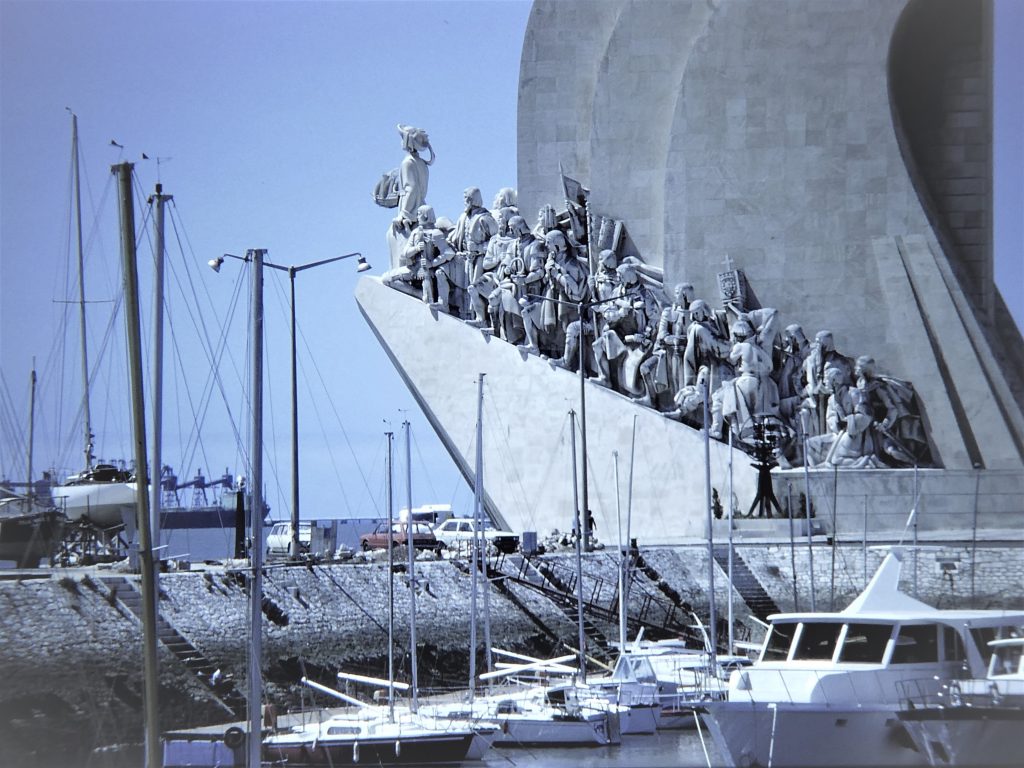 We spent the next day at the Cultural Centre of Belem, a riverside outer suburb to the west of the city. We walked along the waterfront past the marina and to the Monument to the Discoveries, built by Salazar in 1960 to mark the 500th anniversary of Henry “The Navigator” (he was actually the sponsor and organiser of the voyages rather than sailor or navigator). The monument supposedly represent the prow of a caravel. It commemorates all those who had anything to do with Portuguese navigation, and has lines of excellent statues each side, headed at the tip by Henry himself.
We spent the next day at the Cultural Centre of Belem, a riverside outer suburb to the west of the city. We walked along the waterfront past the marina and to the Monument to the Discoveries, built by Salazar in 1960 to mark the 500th anniversary of Henry “The Navigator” (he was actually the sponsor and organiser of the voyages rather than sailor or navigator). The monument supposedly represent the prow of a caravel. It commemorates all those who had anything to do with Portuguese navigation, and has lines of excellent statues each side, headed at the tip by Henry himself.
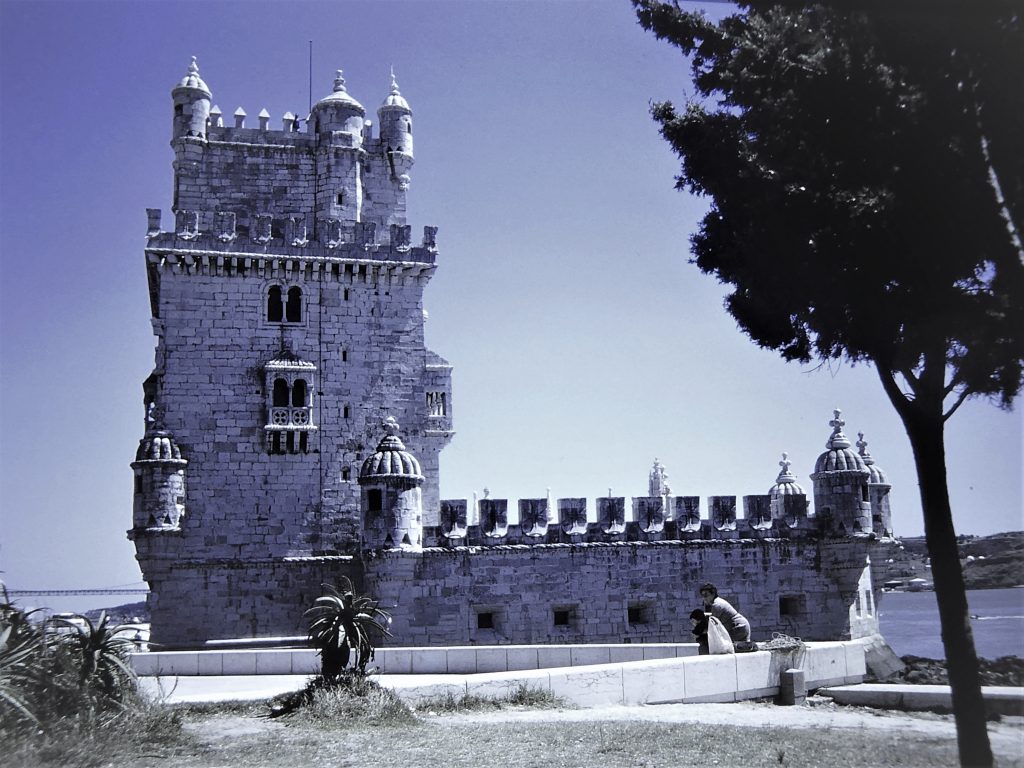 It was then to the ornate Torre de Belem, a splendid edifice, commissioned as a fortress in the Tagus by Manuel I in 1515. This is a splendid example of Manueline architecture, covered in decorated castellations and with an ornate arcaded loggia overlooking the first floor terrace, balconies, watchtowers and a Gothic interior.
It was then to the ornate Torre de Belem, a splendid edifice, commissioned as a fortress in the Tagus by Manuel I in 1515. This is a splendid example of Manueline architecture, covered in decorated castellations and with an ornate arcaded loggia overlooking the first floor terrace, balconies, watchtowers and a Gothic interior.
A short walk further took us to the Mosteiro (monastery) dos Jeronimos. We thought this was one of the most spectacularly beautiful buildings we had ever seen. It happened to be a day for weddings, and we watched a happy couple celebrating at the glorious portal of the monastery. Inside, very ornate, slender pillars with tops blending with the roof vaulting are a lovely feature of the nave. At the west end stands the tomb of Vasco da Gama. The baroque chancel is not overdone.

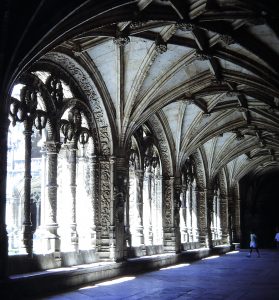 Out of the church then and into the glorious cloisters, an outstandingly beautiful space, with a different set of detailed carvings in and around every arch and doorway. An associated chapel was of lovely proportions - the peace was such that even the tourists were whispering. The high-ceilinged refectory was lined by multicoloured ceramic tiles.
Out of the church then and into the glorious cloisters, an outstandingly beautiful space, with a different set of detailed carvings in and around every arch and doorway. An associated chapel was of lovely proportions - the peace was such that even the tourists were whispering. The high-ceilinged refectory was lined by multicoloured ceramic tiles.
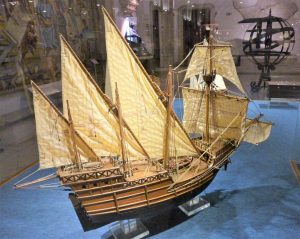 The next step in this marvellous complex was to the maritime museum, which takes part of the western side of the monastery. This is where the Portuguese explorers took mass before they sailed off into the (mostly) unknown. An absolutely stunningly detailed collection of superbly detailed models tell the history of Portuguese sailing and navigation (unfortunately, most of it in Portuguese), together with a good collection of instruments. Adjacent is a collection of royal barges (on one of which Queen Elizabeth II took the last royal ride), fishing boats, sailing yachts and three significant flying boats. All in all, a very good maritime museum, as indeed it should be.
The next step in this marvellous complex was to the maritime museum, which takes part of the western side of the monastery. This is where the Portuguese explorers took mass before they sailed off into the (mostly) unknown. An absolutely stunningly detailed collection of superbly detailed models tell the history of Portuguese sailing and navigation (unfortunately, most of it in Portuguese), together with a good collection of instruments. Adjacent is a collection of royal barges (on one of which Queen Elizabeth II took the last royal ride), fishing boats, sailing yachts and three significant flying boats. All in all, a very good maritime museum, as indeed it should be.
Writing this up in the log that evening, I commented: "Some lovely sights today".
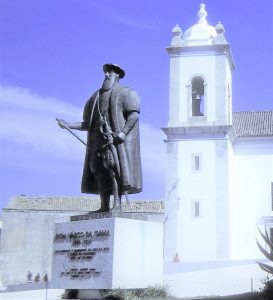 It was easy sail in light but fair winds down to the port of Sines, where we anchored in the inner harbour with some difficulty in weed. At their request, we had guided in a French-Canadian yacht, Berlu, that had contacted us on radio - they can't have known much if they knew less than us! (They were in fact a very experienced and friendly couple.)
It was easy sail in light but fair winds down to the port of Sines, where we anchored in the inner harbour with some difficulty in weed. At their request, we had guided in a French-Canadian yacht, Berlu, that had contacted us on radio - they can't have known much if they knew less than us! (They were in fact a very experienced and friendly couple.)
To our surprise, the anchorage was delightful, off a beach backed by a tidy-looking town. The huge outer harbour, with oil rigs and associated facilities, was out of sight.
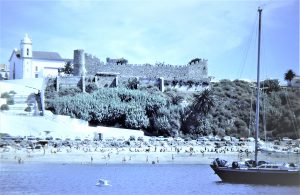 Ashore there was fairly good shopping, including in the clean market. A statue of Vasco de Gama overlooked the waterfront. We woke up the next morning in unexpected fog - which we should have expected, given the number of times fog had descended on us along this coast. It was caused by the tail of a hurricane that was also spoiling the August Bank Holiday weekend in Britain. So we stayed and did some work on the boat, including diving in frigid water to clean the hull and the propeller.
Ashore there was fairly good shopping, including in the clean market. A statue of Vasco de Gama overlooked the waterfront. We woke up the next morning in unexpected fog - which we should have expected, given the number of times fog had descended on us along this coast. It was caused by the tail of a hurricane that was also spoiling the August Bank Holiday weekend in Britain. So we stayed and did some work on the boat, including diving in frigid water to clean the hull and the propeller.
Early start the next day, with more light winds but enough to keep moving with the aid of the spinnaker and a favourable current. The wind strengthened - as it often does in such circumstances - as we rounded the Cabo de Sagres, the prominent south-west corner of Portugal and the Algarve. We saw high, flat-topped hills around the cape, with amazing rock formations falling down to the sea. There were no signs of life apart from the lighthouse, a very lonely corner of the world, we thought.
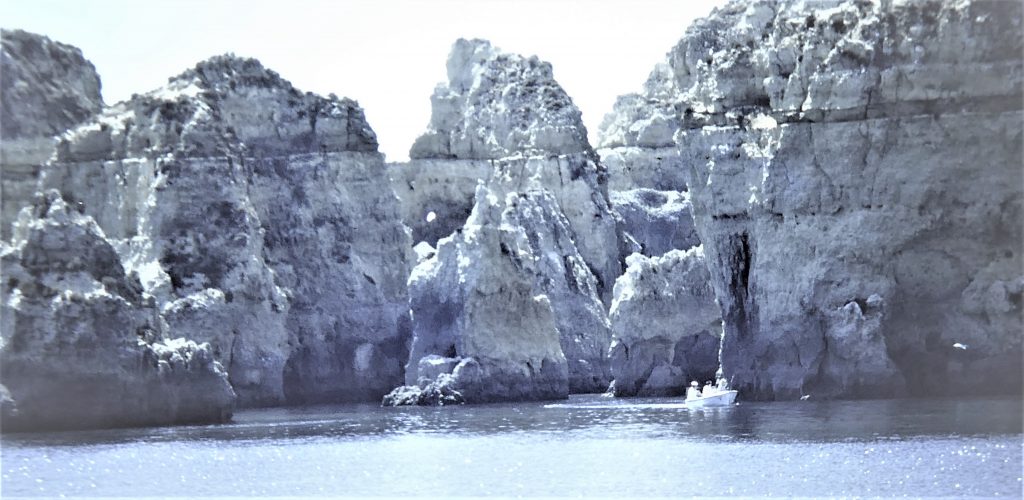 We soon came to the Ensenada de Baleeira, and anchored off the beach along with Berlu. The wind came in strongly the following day, but we had good shelter from the north. The village was small and straggly, and reminded us of Cabo san Lucas in Mexico.
We soon came to the Ensenada de Baleeira, and anchored off the beach along with Berlu. The wind came in strongly the following day, but we had good shelter from the north. The village was small and straggly, and reminded us of Cabo san Lucas in Mexico.
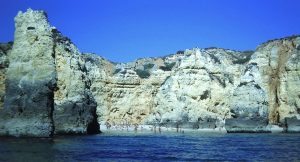 From there we had a pleasant and quite fast sail along the Algarve coast and just after rounding the Ponta de Piedade we saw some more friends anchored among an amazing array of sandstone cliffs, rocks, arches and little beaches. We joined them, hailing an extraordinary change in the weather to hot and sunny with a gentle breeze.
From there we had a pleasant and quite fast sail along the Algarve coast and just after rounding the Ponta de Piedade we saw some more friends anchored among an amazing array of sandstone cliffs, rocks, arches and little beaches. We joined them, hailing an extraordinary change in the weather to hot and sunny with a gentle breeze.
In the afternoon we launched the dinghy and took an exploratory tour of the grottoes and caves in the superb sandstone formations, along with dozens of tourist launches - more lucrative for their owners than fishing!
 In the following clear, warm morning we motored the short distance up to Lagos. We anchored off the beach outside the river harbour, and dinghied ashore for some shopping. The town was quite neat, but very busy with both tourists and locals and the market was shambolic - as usual. The fish market was favoured with neither ice not refrigeration, and the fish looked very sad. We visited a small church - the Igreja de Santo António - with the most gloriously ornate interior, shining gold, and a local museum with Roman and Moorish artefacts.
In the following clear, warm morning we motored the short distance up to Lagos. We anchored off the beach outside the river harbour, and dinghied ashore for some shopping. The town was quite neat, but very busy with both tourists and locals and the market was shambolic - as usual. The fish market was favoured with neither ice not refrigeration, and the fish looked very sad. We visited a small church - the Igreja de Santo António - with the most gloriously ornate interior, shining gold, and a local museum with Roman and Moorish artefacts.
It was not a suitable overnight anchorage, and we motored against a building sea breeze the six miles or so across a big open bay to Portimao, anchoring in the outer harbour north of the eastern mole. We had another sociable evening, with Alain and Jacinthe of Berlu, over for dinner on Cera.
It was a bit windy there, with a swell rolling in, so the next afternoon we moved to a better place and joined an Australian couple and other yachts whose company we had enjoyed in many anchorages all the way down from La Coruna. Among them was Diphda, along with a Welsh boat, Ambition. Ambition was crewed by a charming couple who had become notorious for the number of problems they had got themselves into. We had first met them aboard their boat in Viana, in the ship dock. Welcoming us aboard, he dropped the ship's main compass heavily in the cockpit, a potential disaster that he brushed aside - "it'll be OK". Unsurprisingly they kept getting lost coming down the coast, with Diphda with guiding them on several occasions. They had arrived at Cascais unable to use their dinghy because they had lost its oars overboard - they were not tied on, a critical necessity. We called them, fondly, the Welsh "disaster boat", but were not willing to shepherd them the way our more helpful friends in Diphda did.
 On the first day in September we sailed into our first marina since Treguier, in Brittany. Here, in Vilamoura, we were reminded why we avoided marinas! At the marina office we had to fill forms in for unsmiling officials from immigration, police, Customs etc, despite having officially "entered" Portugal weeks before. They had a power cut, so we couldn't fill up with the fuel we needed, and despite promises otherwise, they would not fill our gas bottles. All this, in the biggest marina in Portugal. But we again caught up with friends, with Tom (Diphda) filling us in on the latest news of the incompetent Ambition crew. (But they were such a pleasant couple - I do hope they never read this!)
On the first day in September we sailed into our first marina since Treguier, in Brittany. Here, in Vilamoura, we were reminded why we avoided marinas! At the marina office we had to fill forms in for unsmiling officials from immigration, police, Customs etc, despite having officially "entered" Portugal weeks before. They had a power cut, so we couldn't fill up with the fuel we needed, and despite promises otherwise, they would not fill our gas bottles. All this, in the biggest marina in Portugal. But we again caught up with friends, with Tom (Diphda) filling us in on the latest news of the incompetent Ambition crew. (But they were such a pleasant couple - I do hope they never read this!)
We made good use of the marina facilities and the nearby expensive and shambolic (!) shopping centre, all in lovely warm weather. To leave, we had to go through another painful series of official presentations at the marina office, marina accounts department, maritime police, immigration and Customs. All the paperwork had to be handed in to the marina office before we could leave. It's not that it was a bad marina, not at all - it just wasn't our style.
We motorsailed in very light winds round the Faro headland, caught a good little tuna on the way, and turned into the Guadiana River that separates Portugal and Spain. The border is along the middle of the river. The entrance to the river is difficult to navigate and the channel is poorly marked. We groped cautiously in with the help of the depth sounder, against the strong outgoing tidal stream and as dark fell. We anchored in pitch dark just past a ferry dock at Ayamonte, on the Spanish side of the river.
Spain - again, and Gibraltar
In the morning we went ashore via a rather dirty fishing boat basin in an attempt to clear in with Spanish officialdom. We gave up, not finding any appropriate offices. We walked into the town, very crowded but not shambolic like Portugal, with better supplies and a good market. There were some pretty squares, trimmed with beautiful ceramic seating places. Back at the anchorage I was asked for medical advice by the crew of the only other boat there, possible clavicle fracture, probably not.
The night was uncomfortable, with choppy waters when the wind was against the tide, so we pulled out the next morning, again cautiously through the river's mouth, with some advice from a fishing boat on the way.
A little further along, we anchored in the River Huelva. This was another rather complex river entry, up the other side of a long sand spit parallel with the mainland, but because the river is a major port, the channel was well marked. We found a pleasant anchorage a little way up the river, off a beach, near the town of Palos de la Frontera.
This is the town out of which Christopher Columbus sailed in La Santa Maria on 3 August 1492, leaving for the first of his voyages across the Atlantic. He made landfall on an island in the Bahamas. Having quite recently spent months in the Bahamas, where he ended that passage, we felt that we were in the presence of the ghosts of seamen long gone.
This was only an overnight rest stop, and we were away early the next morning to cross the big Golfo de Cadiz. It was a misty, windless day, and we motored the whole way to the mouth of yet another river, the Guadalete, just across the smaller Bahia Cadiz from the city. On its way there, the river's path has run down through Jerez and the other sherry towns.
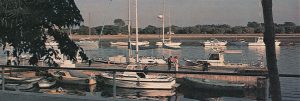
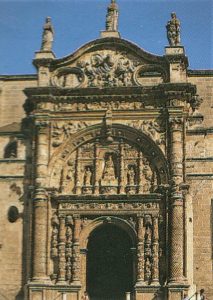 There is a yacht club a short way up the river, the Real Club Nautico del Puerto de Santa Maria, and although not inexpensive they had all facilities and made us very welcome. The little town was enchanting, with lots of cafe/restaurants and amazing shops for cooked seafood called marisquerias. There were no tourists, and by Spanish standards very quiet. We had a look at the local church and its baroque portal, and an old castle with a plaque commemorating the birth nearby of Columbus.
There is a yacht club a short way up the river, the Real Club Nautico del Puerto de Santa Maria, and although not inexpensive they had all facilities and made us very welcome. The little town was enchanting, with lots of cafe/restaurants and amazing shops for cooked seafood called marisquerias. There were no tourists, and by Spanish standards very quiet. We had a look at the local church and its baroque portal, and an old castle with a plaque commemorating the birth nearby of Columbus.
 Back at the club we wallowed in its marvellous swimming pool, a luxury we had not experienced since leaving Australia. We made good friends with American doctor and nurse Jim and Margaret Wall, in a Valiant 40 "The Loon" (an American bird). They were also intending to spend the winter in the marina at Estepona, which they had already done the previous year.
Back at the club we wallowed in its marvellous swimming pool, a luxury we had not experienced since leaving Australia. We made good friends with American doctor and nurse Jim and Margaret Wall, in a Valiant 40 "The Loon" (an American bird). They were also intending to spend the winter in the marina at Estepona, which they had already done the previous year.
 Because we were going to spend at least the winter in Spain we visited the local Maritime Police office to formally "enter" the country, which was a friendly and quick process.
Because we were going to spend at least the winter in Spain we visited the local Maritime Police office to formally "enter" the country, which was a friendly and quick process.
We took a rather rickety old ferry over to Cadiz, which has been flattened by so many invaders that there’s no such thing as an “old” city, and what we experienced was a rather dirty and uninspiring metropolis. The cathedra looked tatty and was shut, but we found an enchanting small church, partly underground, with three paintings by Goya in the dome.

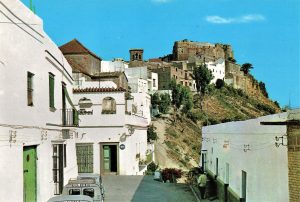 In continuing hot weather we took a bus ride, firstly visiting Jerez. This was disappointing, so we soon took another bus to Arcos de la Frontera. This, in great contrast, was a lovely little town. It lies on the ridge of a hill on top of a cliff, with a castle and two churches overlooking the cultivated valley of the upper reaches of the Guadalete. Grapevines were growing in wide, rolling fields, while sunflower and sugarcane crops were going into
In continuing hot weather we took a bus ride, firstly visiting Jerez. This was disappointing, so we soon took another bus to Arcos de la Frontera. This, in great contrast, was a lovely little town. It lies on the ridge of a hill on top of a cliff, with a castle and two churches overlooking the cultivated valley of the upper reaches of the Guadalete. Grapevines were growing in wide, rolling fields, while sunflower and sugarcane crops were going into  hibernation. The big sherry bodegas were in contrast with the smaller, very up-market ones down in Puerto de Santa Maria, such as Osborne and Terry.
hibernation. The big sherry bodegas were in contrast with the smaller, very up-market ones down in Puerto de Santa Maria, such as Osborne and Terry.
We walked the village and climbed to the top of a bell tower for lovely all-round views. The shining white walls of the dwellings confirmed it was one of the "pueblos blancos". We had a long Spanish-style lunch in a restaurant run by a friendly English-speaking couple, and then worked our way back to Puerto and a swim in the pool.
We left early the next morning for a long day's run to Gibraltar, accompanied for a while by Loon. We both took a wide detour out to the west from Cadiz, Loon a bit further out than us, to avoid the shoals that extend a mile or two out to sea. Around mid-day we were motor-sailing past Cabo Trafalgar, and we re-read the story of Nelson and the battle as we sailed by, thinking of the remains of the men-o’-war beneath our keel and marvelling at the skill and seamanship which allowed these combatants to fight and sail at the same time.
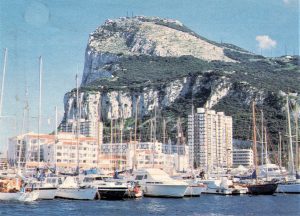 By early evening we were rounding Cape Tarifa, the northern gate to the Mediterranean, with Africa in sight to the south; we could see the cliffs of Sidi Masa, the southern location of the Pillars of Hercules. At 8:30pm local time, by now dark, we entered the Bay of Gibraltar (or Bay of Algeciras, depending on your position on the matter), and very cautiously edged up through a confusing mass of lights, mostly from anchored ships and others from the land. We finally tied up at the Customs dock and obtained quick and easy clearance. The Customs officer advised us to go over and take any open berth in the Marina Bay complex and work things out in the morning.
By early evening we were rounding Cape Tarifa, the northern gate to the Mediterranean, with Africa in sight to the south; we could see the cliffs of Sidi Masa, the southern location of the Pillars of Hercules. At 8:30pm local time, by now dark, we entered the Bay of Gibraltar (or Bay of Algeciras, depending on your position on the matter), and very cautiously edged up through a confusing mass of lights, mostly from anchored ships and others from the land. We finally tied up at the Customs dock and obtained quick and easy clearance. The Customs officer advised us to go over and take any open berth in the Marina Bay complex and work things out in the morning.
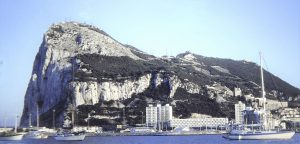 Rain came in overnight, easing to drizzle. We checked in with the marina office, but it was too expensive for us. So, after fuelling up, we went out and round the end of the airfield runway and anchored among other cruising yachts. We then launched the dinghy and returned to the marina complex, specifically the helpful
Rain came in overnight, easing to drizzle. We checked in with the marina office, but it was too expensive for us. So, after fuelling up, we went out and round the end of the airfield runway and anchored among other cruising yachts. We then launched the dinghy and returned to the marina complex, specifically the helpful 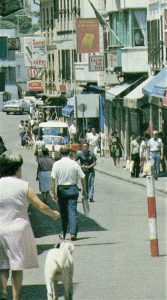 Sheppards Marina, and took a walk around the town. Our first impressions - to be confirmed later - were of a rather scruffy place. We had anticipated something like Bermuda - but it definitely was not! It was very much a base for the British armed services, and we were familiar with the look of service families when shopping in the town. Tourism was just becoming popular, but there were just a few British tourists around when we were there.
Sheppards Marina, and took a walk around the town. Our first impressions - to be confirmed later - were of a rather scruffy place. We had anticipated something like Bermuda - but it definitely was not! It was very much a base for the British armed services, and we were familiar with the look of service families when shopping in the town. Tourism was just becoming popular, but there were just a few British tourists around when we were there.
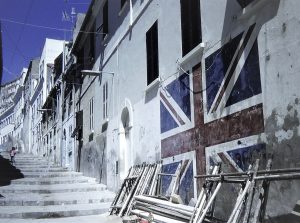 But some mail at last caught up with us, although the Coruna packages had not appeared and never did. Around the marina we caught up with a few cruisers that we had come across as long ago as when in Bermuda. We did good shopping in a good supermarket and were able to take the trolley down to the dinghy, super convenient.
But some mail at last caught up with us, although the Coruna packages had not appeared and never did. Around the marina we caught up with a few cruisers that we had come across as long ago as when in Bermuda. We did good shopping in a good supermarket and were able to take the trolley down to the dinghy, super convenient.
We visited the excellent Gibraltar museum that afternoon, and the next day took the cable car up the Rock. We communed with the rock apes, which we - and especially Norma - found appealing, tame and friendly. We walked through the "batteries", the tunnels built into the rock which were built to hold gunnery to combat invaders from the land side; just a short introduction to the 30 miles of tunnelling! After lunch we walked down, enjoying the view from the truly impressive Rock, and visited the Homage Tower, a keep-like structure part of a Moorish castle, with some good museum pieces.
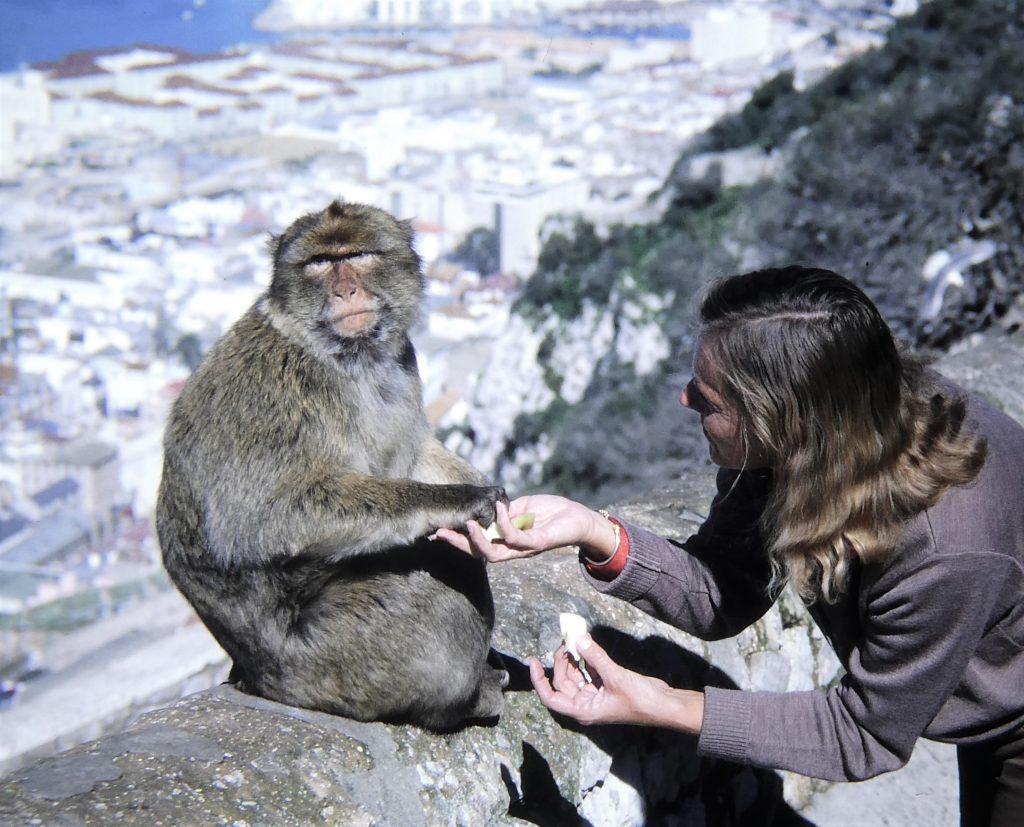
Inevitably, back at the marina, there was a lot more socialising; Gibraltar is such a crossroad meeting-place for long-distance yacht voyagers that it's easy to cross paths again with old friends and make new ones.
